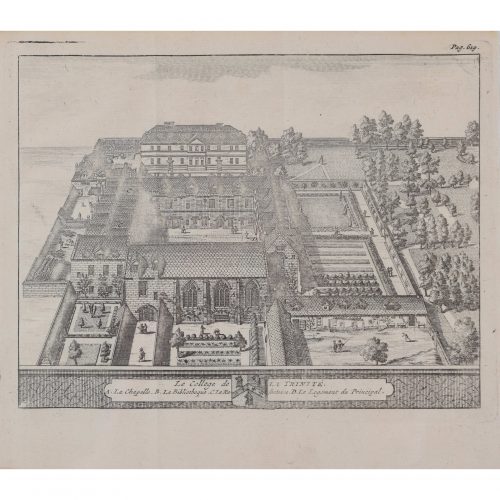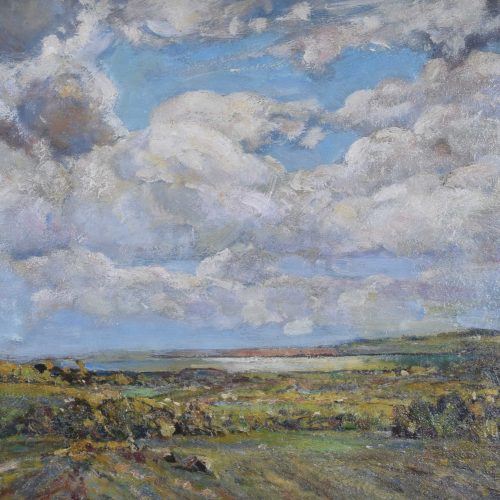-
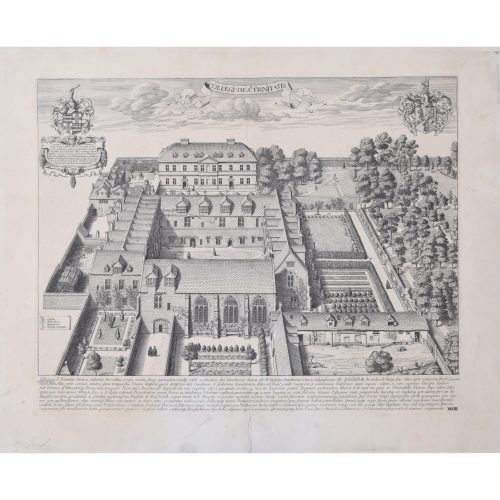
David Loggan (1634 - 1692)
Trinity College, Oxford (1705)
Engraving 32 x 41 cm Loggan's view of Trinity from the second edition of the 'Oxonia Illustrata'. Loggan was born to English and Scottish parents, and was baptised in Danzig in 1634. After studying engraving in Danzig with Willem Hondius (1598-1652 or 1658), he moved to London in the late 1650s, going on to produce the engraved title-page for the folio 1662 Book of Common Prayer. He married in 1663 and moved to Nuffield in Oxfordshire in 1665. Loggan was appointed Public Sculptor to the nearby University of Oxford in the late 1660s, having been commissioned to produce bird’s-eye views of all the Oxford colleges. He lived in Holywell Street as he did this. The 'Oxonia Illustrata' was published in 1675, with the help of Robert White (1645 - 1704). Following its completion, Loggan began work on his equivalent work for Cambridge; the 'Cantabrigia Illustrata' was finally published in 1690, when he was made engraver to Cambridge University. The 'Oxonia Illustrata' also includes an engraving of Winchester College (Winchester and New College share William of Wykeham as their founder) whilst the 'Cantabrigia Illustrata' includes one of Eton College (which shares its founder, Henry VIII, with King’s College). Bird’s-eye views from this era required a particular talent as an architectural perspectivist; it was not until 1783 that it became possible for artists to ascend via hot air balloons and view the scenes they were depicting from above. Loggan thus had to rely on his imagination in conceiving the views. Loggan’s views constitute the first accurate depictions of the two Universities, in many ways unchanged today. Whilst the Oxford engravings were produced in reasonable numbers and ran to a second edition by Henry Overton (on thicker paper and with a plate number in Roman numerals in the bottom right-hand corner), those of Cambridge were printed in much smaller numbers. The Dutchman Pieter van der Aa published some miniature versions of the engravings for James Beverell’s guidebook to the UK, 'Les Delices de la Grande Bretagne' (circa 1708). The contemporary artist Andrew Ingamells has produced a highly-acclaimed series of etchings which bring Loggan’s original vision up to date. Condition: generally very good; second edition. If you’d like to know more, please email info@manningfineart.co.uk or call us on 07929 749056. -
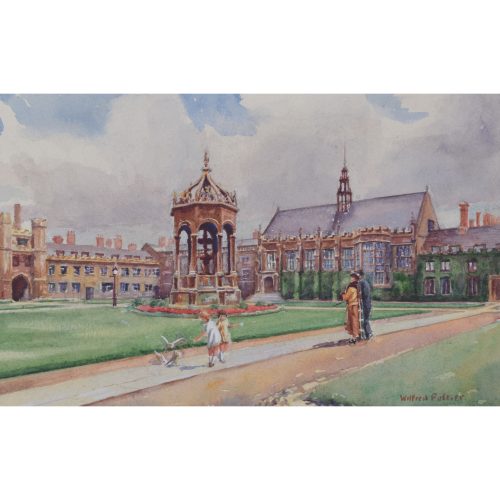
Wilfred Pettitt (1904 - 1978)
Great Court, Trinity College, Cambridge
Watercolour 17 x 27 cm A smartly-dressed couple and their two children enjoy the sunny and immaculately-lawned Great Court of Trinity College, Cambridge. The man and woman admire the ornate fountain which stands sentinel in the middle of the court (it, along with the rest of Great Court, was erected by by Thomas Nevile, master of the college in the early 17th century). Their children, perhaps oblivious to the architectural majesty around them, amuse themselves by playing with the pigeons. Wilfred Stanley Pettitt was born in Great Yarmouth, and studied at the Great Yarmouth School of Art and the Norwich School of Art. In 1928 he showed at the Royal Academy Royal Academy for the first time, and his work was also exhibited by the Royal Society of British Artists and the Royal Cambrian Academy. In 1944 Pettitt became one of the founding members of the Norwich Twenty Group (a group of Norfolk artists who intended to raise the standards of local professional art). He died in Eastbourne in 1978. Condition: mounted to board; otherwise very good. If you are interested, please email info@manningfineart.co.uk or call us on 07929 749056. Click here for other views of Trinity College, Cambridge. -
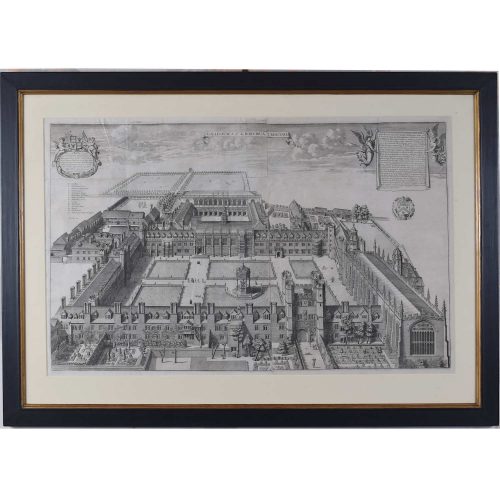
David Loggan (1634 - 1692)
Trinity College, Cambridge (1690)
Engraving 80 x 50 cm Loggan was born to English and Scottish parents, and was baptised in Danzig in 1634. After studying engraving in Danzig with Willem Hondius (1598-1652 or 1658), he moved to London in the late 1650s, going on to produce the engraved title-page for the folio 1662 Book of Common Prayer. He married in 1663 and moved to Nuffield in Oxfordshire in 1665. Loggan was appointed Public Sculptor to the nearby University of Oxford in the late 1660s, having been commissioned to produce bird’s-eye views of all the Oxford colleges. He lived in Holywell Street as he did this. The 'Oxonia Illustrata' was published in 1675, with the help of Robert White (1645 - 1704). Following its completion, Loggan began work on his equivalent work for Cambridge; the 'Cantabrigia Illustrata' was finally published in 1690, when he was made engraver to Cambridge University. The 'Oxonia Illustrata' also includes an engraving of Winchester College (Winchester and New College share William of Wykeham as their founder) whilst the 'Cantabrigia Illustrata' includes one of Eton College (which shares its founder, Henry VIII, with King’s College). Bird’s-eye views from this era required a particular talent as an architectural perspectivist; it was not until 1783 that it became possible for artists to ascend via hot air balloons and view the scenes they were depicting from above. Loggan thus had to rely on his imagination in conceiving the views. Loggan’s views constitute the first accurate depictions of the two Universities, in many ways unchanged today. Whilst the Oxford engravings were produced in reasonable numbers and ran to a second edition by Henry Overton (on thicker paper and with a plate number in Roman numerals in the bottom right-hand corner), those of Cambridge were printed in much smaller numbers. The Dutchman Pieter van der Aa published some miniature versions of the engravings for James Beverell’s guidebook to the UK, 'Les Delices de la Grande Bretagne' (circa 1708). The contemporary artist Andrew Ingamells has produced a highly-acclaimed series of etchings which bring Loggan’s original vision up to date. Condition: generally very good; printed on two sheets, folds as issued. A few creases to top area. As a multi-folded plate in the published book, Trinity has normally suffered and is normally trimmed closely and has damage; this particular example has instead good margins outside the platemark and without damage to the folds. A very good copy of Trinity. If you’d like to know more, please email info@manningfineart.co.uk or call us on 07929 749056. -
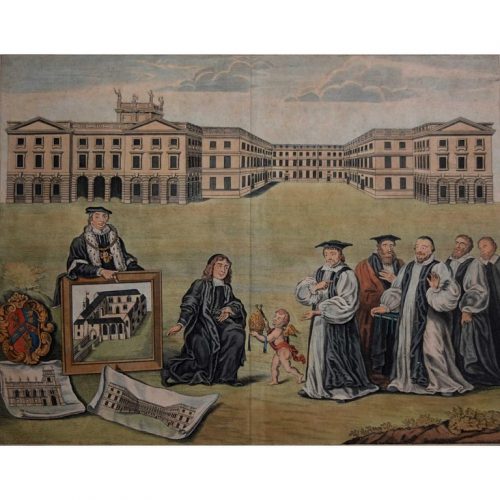
Engraving of architect showing plans of Trinity College Oxford and its chapel, behind larger elevation of Garden (early 18th Century)
Hand coloured engraving, anoymous 36.5 x 47.5 cm Rare - we have been unable to identify another copy of this print. The architect pictured has been suggested to be Henry Aldrich who designed the chapel at Trinity College, hence seen here with the plans thereof. The figures stand before the buildings of the Garden Quadrangle, built by Christopher Wren. Aldrich was Canon and Dean of Christ Church, Oxford. As well as a polymath and composer, he was a prolific architect working in the Palladian style, writing 'Elemena Architectuae Civilis' (1789) and designing Peckwater Quadrangle at Christ Church (1707-14). Condition:Generally good with some spotting and slight overall toning. Trimmed to just within platemark at top and bottom. If you are interested email info@manningfineart.co.uk or call us on 07929 749056. -
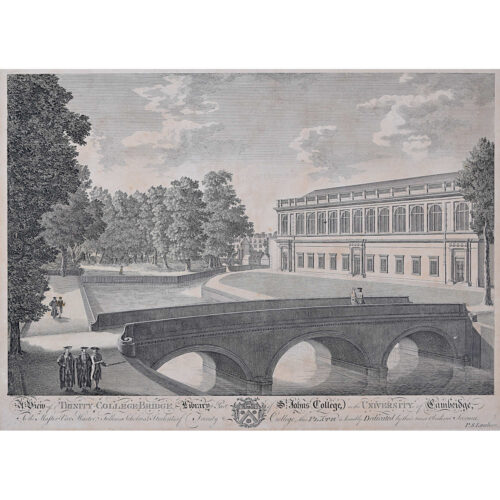
Peter Spendelowe Lamborn (1722 - 1774)
Trinity College Bridge and Library and Part of St John's College, in the University of Cambridge
Engraving 37 x 52 cm Peter Spendelowe Lamborn was an English engraver and miniature painter. He studied engraving under Basire and worked in Cambridge, where he obtained some note as an engraver. Condition: generally good; some discolouration to paper, surface dirt particularly to margins. Mounted to board and previously mounted with plate mark under mount. If you are interested, please email info@manningfineart.co.uk or call us on 07929 749056. Click here for other views of Cambridge. -
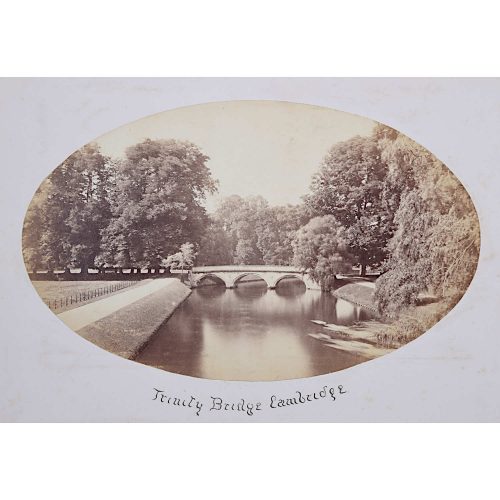
Trinity Bridge, Cambridge
Albumen print of a photograph, circa 1850 Mounted to board and inscribed 'Trinity Bridge Cambridge'. Trinity Bridge is a stone built tripled-arched road bridge across the River Cam. It was built from Portland stone in 1765 to the designs of James Essex to replace an earlier bridge built in 1651, and is a Grade I listed building. Trinity College is a constituent college of the University of Cambridge, and was founded in 1546 by King Henry VIII. Trinity is one of the oldest and largest colleges in Cambridge, with the largest financial endowment of any college at either Cambridge or Oxford. Trinity has some of the most distinctive architecture within Cambridge, with its Great Court reputed to be the largest enclosed courtyard in Europe. Condition: generally very good. If you’d like to know more, please email info@manningfineart.co.uk or call us on 07929 749056. -
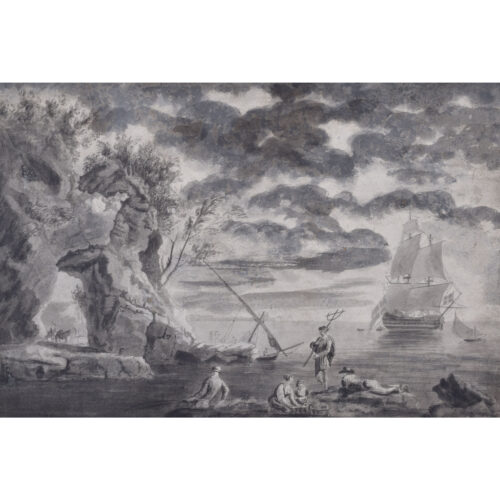
John Cantiloe Joy (1805 - 1859) / William Joy (1803 - 1865) (attributed)
Trident on the Shore
Pencil and wash 28 x 42 cm A 19th century engraving of a ship near a shore. Various figures, including one wielding a trident, appear in the foreground. John Cantiloe Joy and William Joy were brothers who worked together as English marine artists. During the 1820s, the brothers' paintings were exhibited at the Norwich Society of Artists, the Royal Society of British Artists, the Royal Academy and at the British Institution. They belonged to the Norwich School of painters which specialised in maritime scenes and views of rural Norfolk and Norwich. Condition: generally very good; mounted to board. If you are interested, please email info@manningfineart.co.uk or call us on 07929 749056. -

Gordon House (1932 - 2004)
Triangle E
Lithograph 86 x 45 cm Signed and titled in pencil below the plate. An excellent example of Gordon House's work: a modern design in several tones of blue. Gordon House was born in Pontardawe, South Wales in 1932 and studied at Luton and St. Albans Schools of Art. He began working for advertising agencies in the 1950s and became a full-time artist in 1961, exhibiting several solo shoes. He designed for several leading London galleries, the Ashmolean Museum in Oxford, and popular bands such as the Beatles and the Rolling Stones. Several dozen Gordon House prints are held by the Tate. Condition: very good. Mounted to board. If you’d like to know more, please email info@manningfineart.co.uk or call us on 07929 749056. -
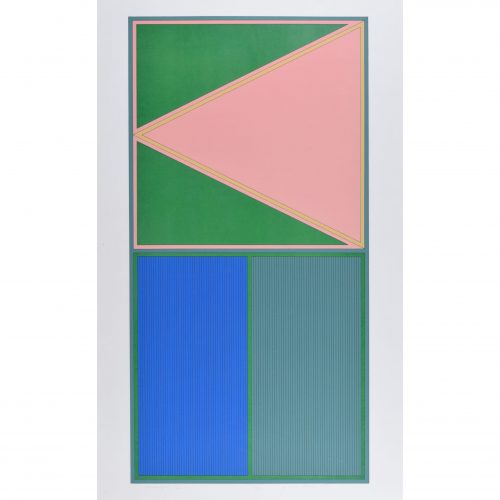
Gordon House (1932 - 2004)
Triangle D
Lithograph 86 x 45 cm Signed and titled in pencil below the plate. An excellent example of Gordon House's work: a modern design in tones of green, pink, and blue. Gordon House was born in Pontardawe, South Wales in 1932 and studied at Luton and St. Albans Schools of Art. He began working for advertising agencies in the 1950s and became a full-time artist in 1961, exhibiting several solo shoes. He designed for several leading London galleries, the Ashmolean Museum in Oxford, and popular bands such as the Beatles and the Rolling Stones. Several dozen Gordon House prints are held by the Tate. Condition: very good; backed to board. If you are interested, please email info@manningfineart.co.uk or call us on 07929 749056. Click here for other abstract lithographs by Gordon House. -
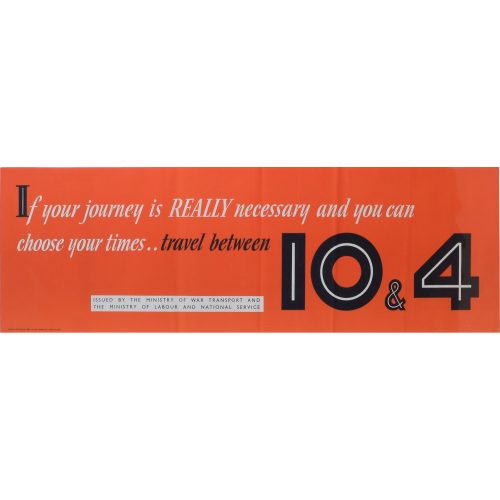
Printed for H.M. Stationery Office, c.1943
If your journey is REALLY necessary and you can choose your times… travel between 10 and 4
Issued by the Ministry of War Transport and the Ministry of Labour and National Service 18×75 cm (7″ x 30″) in unissued condition If you are interested email info@manningfineart.co.uk or call us on 07929 749056. -
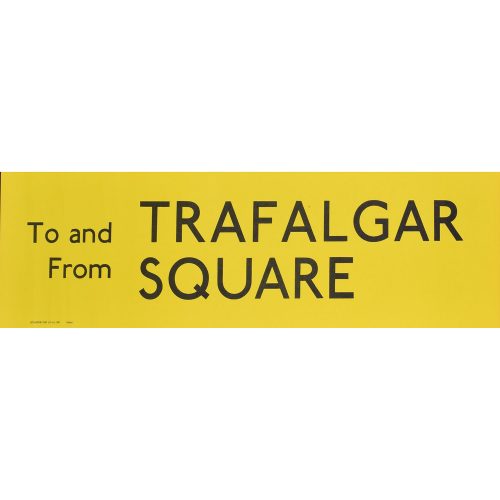
Trafalgar Square Routemaster Slipboard Poster c1970
Screenprint poster 64x19cm Printed for London Transport for use on Routemaster or RT busses. If you are interested email info@manningfineart.co.uk or call us on 07929 749056. -
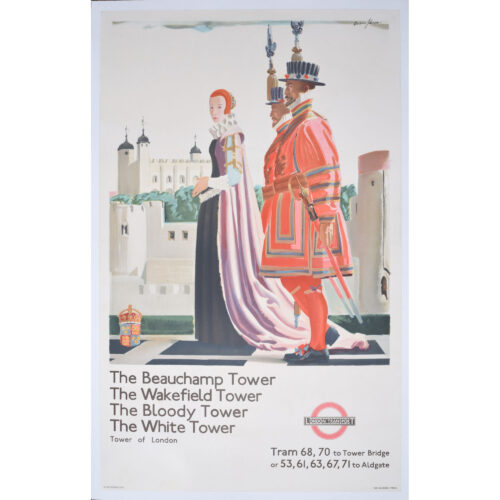
Andrew Johnson (1893 - 1973)
The Tower of London (1935)
Lithograph 102 x 64 cm A copy of this poster is held by the London Transport Museum (1983/4/4178). Queen Elizabeth I, accompanied by two Yeomen Warders, surveys the white stone of the Tower of London. Johnson's design encourages us to use London Transport (now Transport for London) to visit the Tower in all its historic glory. Andrew Johnson was born in Portsmouth and studied at the Central School of Art and Design (now Central St Martin's) in London. He worked as a poster designer for several advertising agencies. He designed posters for BP, Shell, the London and North Eastern Railway, Southern Railway, The Times, and General Motors (to name but a few). He made advertising graphics in New York in the late 1920s and later founded Grainger Johnson (a poster design company) with Tom Grainger. He was a member of the British Society of Poster Designers and several of his designs are held by the London Transport Museum. Condition: backed to linen; excellent. If you are interested, please email info@manningfineart.co.uk or call us on 07929 749056. Click here for other original vintage posters. -
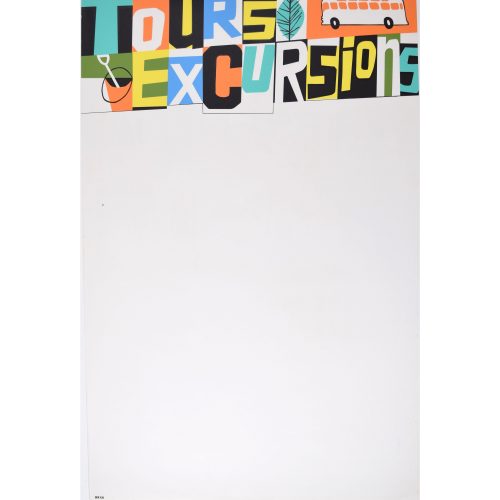
Anonymous Tours and Excursions
Original Coach Poster 75x50cm Cool and crazy mid-century lettering. Poster with area for completion with details of a coach tour. If you are interested email info@manningfineart.co.uk or call us on 07929 749056. Condition: Excellent. -
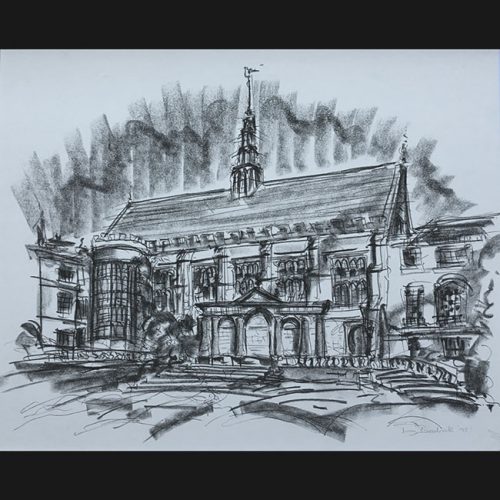
Tony Broderick
Trinity College, Cambridge, Hall from exterior
Conte drawing 37x47cm If you are interested email info@manningfineart.co.uk or call us on 07929 749056. -

Tony Broderick
St. John's Great Gate, Cambridge
Conte drawing 33x42cm If you are interested email info@manningfineart.co.uk or call us on 07929 749056. -
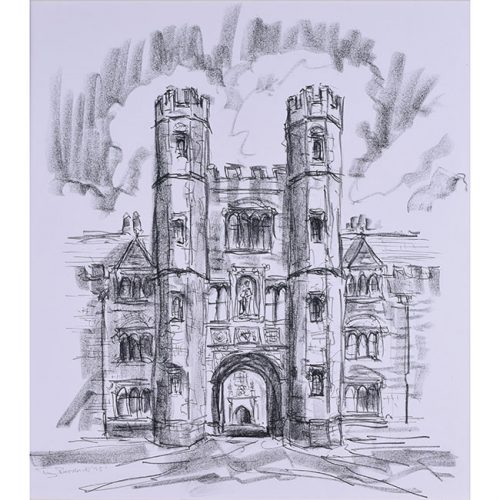
Tony Broderick
Shrewsbury Tower St. John's College Cambridge
Conte drawing 35x32cm If you are interested email info@manningfineart.co.uk or call us on 07929 749056. -
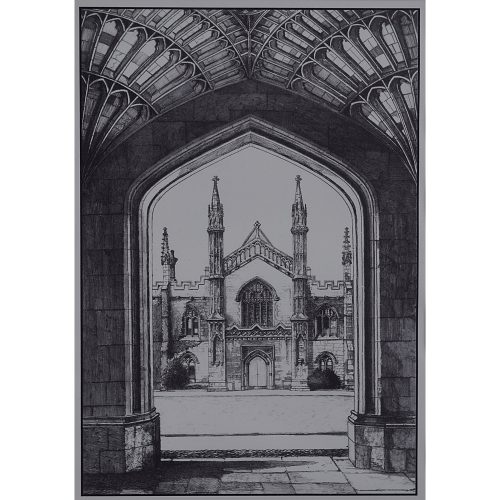
Tony Broderick (British, late 20th Century) Corpus Christi College Cambridge
Print 35x25cm A Lincoln-based artist, known for his portrayal of Lincoln and also of the Cambridge Colleges. If you are interested email info@manningfineart.co.uk or call us on 07929 749056. Condition: Excellent. -
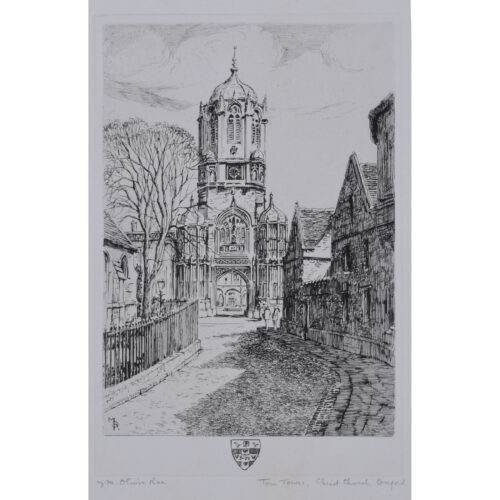
Mabel Oliver Rae (1868 - 1956)
Tom Tower, Christ Church, Oxford
Etching 23 x 15 cm Hand-signed in pencil lower left, and titled in pencil lower right. Initialled 'MR' in plate lower left. The eminent Tom Tower, as seen from Pembroke Square, with the college crest below. Mabel Oliver Rae was born in Cambridge, Cambridgeshire, and trained at the Slade School of Fine Art between 1888 and 1890. Rae is known for her skilled etchings of various rural scenes and townscapes, particularly those of the colleges of Oxford and Cambridge. She signed works with the pseudonym 'M.Oliver Rae', a ruse to conceal the fact she was a female artist, so as not to reduce her chances with commercial dealers and agents. Condition: very good; mounted to board; some time staining to extreme margins (to be hidden under mount). If you are interested, please email info@manningfineart.co.uk or call us on 07929 749056. Click here for other views of Christ Church. -
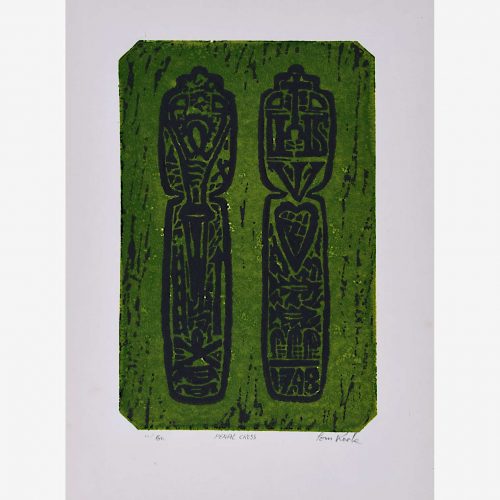
Tom Roche (b. 1940) Penal Cross
Screenprint 24x19cm Signed in pencil and numbered 11/40 Roche trained at the Irish National College of Art and Design, then studying etching and lithography at Chelsea College of Art. After working as a graphic designer in advertising, he became a full-time painter in 1972 based in Dingle in Co. Kerry. After operating from a gallery in Dingle he returned in the 1980s to Dublin, working as part0time lecturer at the Dun Laoghaire School of Art and Design and as creative director for Emerald City Productions Ltd. He is renowned for his soft, atmospheric paintings of Irisih landscape and interiors as well as for his prints such as this. If you are interested email info@manningfineart.co.uk or call us on 07929 749056. -
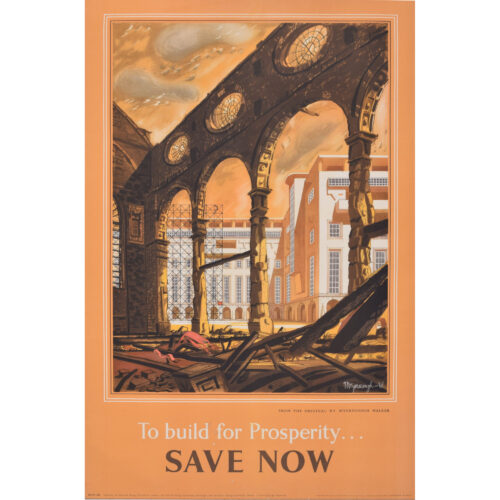
Raymond Myerscough Walker (1908 - 1984)
To Build for Prosperity - Save Now
Original vintage poster 74 x 49 cm Issued by the National Savings Committee London, the Scottish Savings Committee Edinburgh, and the Ulster Savings Committee Belfast. Printed For HM Stationery Office By Thomas Forman and Sons Ltd, Nottingham. This posters makes use of Myerscough Walker's original painting of a church bombed in the Blitz, with new buildings being constructed behind. Even in the face of war and destruction, Britain builds itself up to prosper - and, by saving, so can we. Myerscough Walker was an architectural draughtsman. He trained at Leeds School of Art and went on to the Architectural Association in London. In 1931 he won the Tite prize and was celebrated in his career for his skill as a draughtsman – as well as architect, writer, artist, sculptor and stage designer. He worked with Berhold Lubetkin, the significant modernist architect, for several years. Condition: generally very good; the odd gentle crease. Not backed. If you are interested, please email info@manningfineart.co.uk or call us on 07929 749056. Click here for other original vintage posters. -
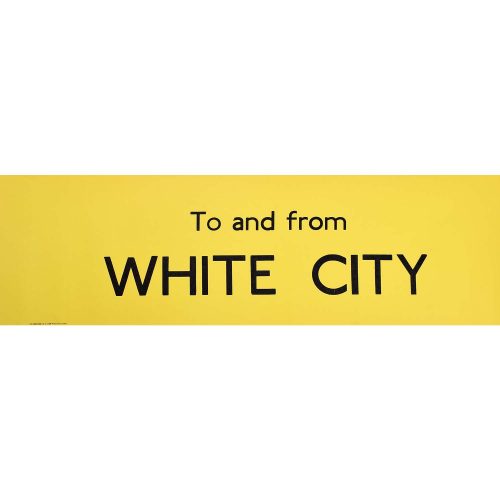
To and From White City Routemaster Bus Slipboard Poster c1970
Screenprint poster 64x19cm Printed for London Transport for use on Routemaster or RT busses. If you are interested email info@manningfineart.co.uk or call us on 07929 749056. Condition: Good. -
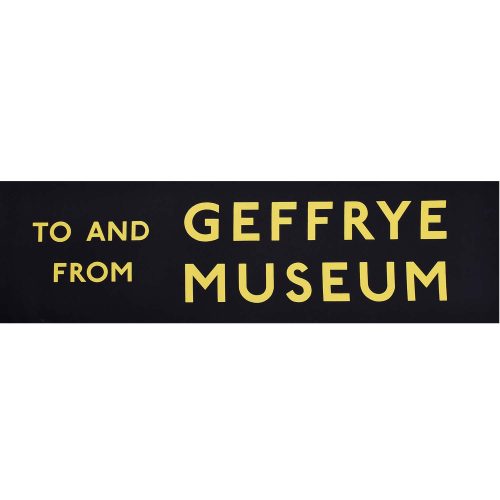
To and From Geffrye Museum Routemaster Bus Slipboard Poster c1970
Screenprint poster 64x19cm Printed for London Transport for use on Routemaster or RT busses. Geffrye Museum is the museum of the home. If you are interested email info@manningfineart.co.uk or call us on 07929 749056. Condition: Good. -
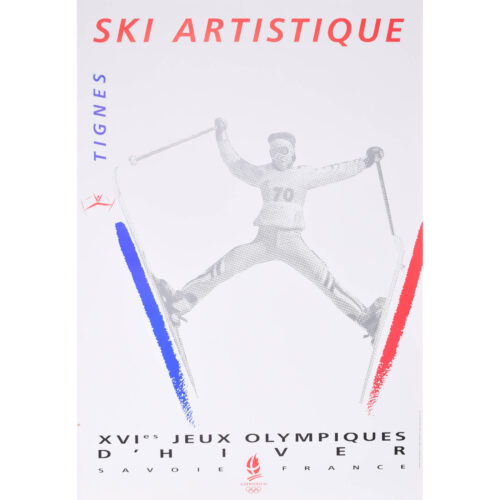
R C Meaux
Tignes - Ski Artistique (1990)
Original vintage poster 80 x 53 cm An original vintage poster printed in colour in 1990 by L’Avenir Graphic. The poster was designed to promote the 1992 Olympic Winter Games in Albertville. A similar design was also used for a limited edition French postage stamp in 1992. Condition: very good. If you are interested, please email info@manningfineart.co.uk or call us on 07929 749056. Click here for more original vintage ski posters. -
Out of stock
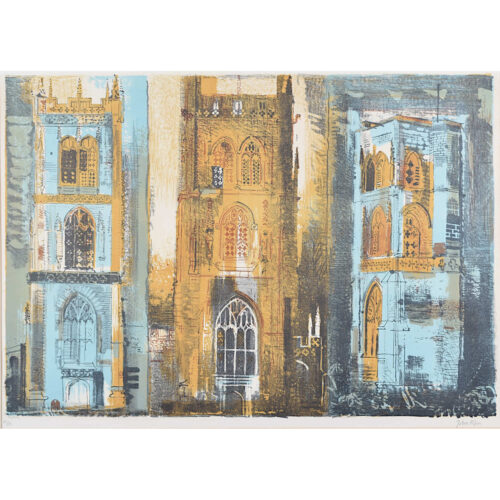
John Piper (1903-1992)
Three Somerset Towers (1973)
Screenprint 56 x 76 cm John Piper CH was an English painter, printmaker, and designer of stained-glass windows. His work often focused on the British landscape, especially churches and monuments, and included tapestry designs, book jackets, screen-prints, photography, fabrics and ceramics. Condition: generally very good; a little age toning. If you are interested, please email info@manningfineart.co.uk or call us on 07929 749056. Click here for other works by John Piper. -
Out of stock
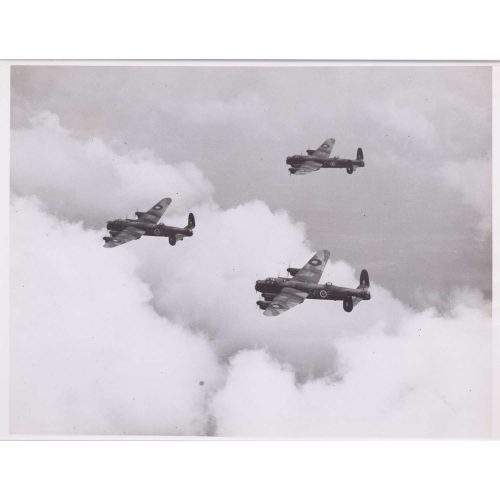
Charles E Brown (1896-1982)
Three AVRO Lancaster Bombers in Flight
Original Silver Gelatin photograph, c. 1944 16 x 21 cm Photograph 20 June 1942 above Cranwell EM-A EM-C and EM-F of 207 Squadron The RAF info website details the various Lancaster bombers of 207 Squadron. EM-C was a Lancaster I with serial number R5695 . It took off on 25 November 1942 from Langar, on a mission to Haselunne. The pilot was an Alfred Parkyn of the RCAF - whose parents lived in New Jersey. The aircraft was lost without trace and the crew are commemorated on the Runneymede Memorial. EM-A was another Lancaster I with serial number ED604. It took off from Langar on 12 March 1943 on a night mission (with 42% moon) to Essen, piloted by the 22-year-old F/O Michael Doble DFC. It crashed near Bottrop on the outskirts of Essen, with the loss of all its crew who are buried in the Reichswald Forest War Cemetery. Doble's DFC was gazetted on 31 July 1942, following an action in which 12 DFCs and one DSO were awarded. The citation reads: "The KING has- been graciously pleased to approve the following awards in recognition of gallantry displayed in flying operations against the enemy: —On 11th July, 1942, a force of bombers was detailed to make an attack on the submarine works at Danzig. The operation, which necessitated a high degree of skill and fortitude, was undertaken in extremely adverse weather. Despite this, the objective was reached by dusk, carefullyidentified and, in the face of strong oppositionfrom the ground defences, subjected to a most determined attack. Bombs were released at varying heights, some as low as 1,000 feet. Many hits were obtained. Searchlight posts were also machine-gunned and many searchlights extinguished. The success achieved reflects the greatest credit on the following personnel who participated in various capacities as leaders and members of aircraft crews." EM-F was a Lancaster I serial number R5694, piloted by Flight Lieutenant Raymund Joseph Hannan DFC which hit high ground in bad visibility at Easton, Lincs, home-bound from Bad Zwischenahn (Vechta) killing all the crew on 25 November 1942. Hannan was a New Zealander who had served for a year with the RNZAF prior to volunteering in September 1939 for the RAF. Following training he undertook a tour of 29 operations with 49 Squadron in the Handley Page Hampden, and after this served as an instructor in 25 Operational Training Unit. His DFC was gazetted on 24 October 1941. In September 1942 he was posted to 207 Squadron, flying four missions prior to that of 25 November 1942. This latter mission lasted only three hours - probably long enough to reach the Dutch coast and return to the UK, and certainly not long enough for the Luftwaffe aerodrome at Bad Zwischenahn. Upon return to base the aeroplane was unable to land owing to bad weather. It crashed near Goadby Marwood, the local history society of which have published an extensive history of the crew members at https://www.goadby-marwood-history.co.uk/the-crew-of-r5694-em-f . Five of the crew, including Hannan, are buried in St Mary's Churchyard in Bottesford. The crash site was discovered in 2021, a full report here: https://www.goadby-marwood-history.co.uk/_files/ugd/bc525f_aedab371f8794f2eab2c0c9ea9721720.pdf The grave sites of the crew members are detailed here https://aviationtrails.wordpress.com/tag/r5694/ Charles E Brown was a famous photographer of aircraft whose father was a butcher in Wimbledon, London. Young Charles was given a camera for his 14th birthday and in 1911 photographed an Edwardian gentleman in trouble landing his balloon in neighbouring Southfields. This photograph was published in the Daily Mirror – the fee being half a crown – and Brown was encouraged to join the Daily Mirror’s photography department upon leaving school at 16. Towards the end of the First World War he served with the Royal Air Force at their official London Photographic Centre. Following the war, he took to photographing trains, and captured a famous photograph of a Southern Railway locomotive that was used for the following ten years in railway posters. The income from this allowed him to pursue his passion of aviation photography in the 1920s and 1930s, from which commissions from the Air Ministry and Fleet Air Arm followed. During the war his work included commissions for Aeronautics magazine. Provenance: from the collection of Philip J R Moyes, author of many books on the RAF, most notably The Pictorial History which ran to several volumes. Condition: Generally very good. -
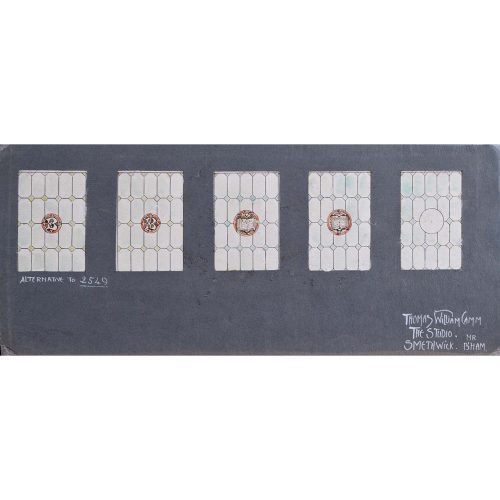
Thomas William Camm Florence Camm Design for 5 Stained Glass Window Panels
Watercolour 15x36 cm For biographical details and other works by the artist click here. If you are interested email info@manningfineart.co.uk or call us on 07929 749056. Conditon: Good. In conservation mount and in plastic sleeve for protection. -
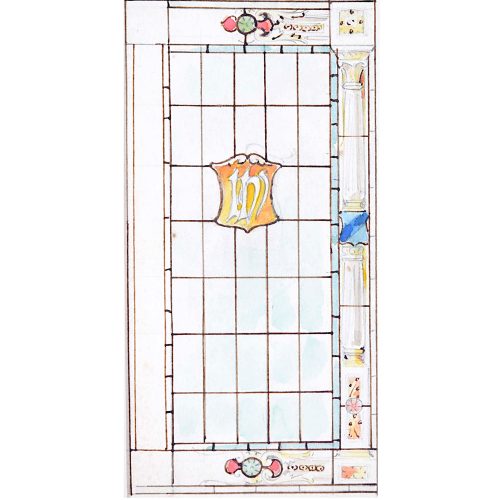
Florence Camm (1874-1960) Design for church stained glass window with 'IHS' roundel
Watercolour 17x9 cm Design for TW Camm & Co., Smethwick, Birmingham With 'IHS' Roundel - 'Iesus Hominum Salvator' ('Jesus Saviour of Mankind') The Camms were stained glass designers who exhibited 48 times at the Royal Academy and also exhibited at The Walker Art Gallery in Liverpool, The Royal Scottish Academy and Royal Birmingham Society of Artists. Following the death of her father, Florence Camm became chief designer at TW Camm with many commissions both nationally and internationally. Florence Camm was the daughter of Thomas William Camm (1839-1912) who founded the stained glass business T W Camm in High Street Smethwick. From 1892-1911 she studied at The Birmingham Municipal School of Art which, unusually for the time, encouraged girls to attend the life drawing classes – drawing fully nude female models and partially draped male models – thus explaining Camm’s skill with the human figure. Students were encouraged to execute their drawings for designs, thus giving them the skills to set up as manufacturers in Birmingham’s Jewellery Quarter. The arts and crafts designer Henry Payne was an influential tutor for Camm, being one of the most influential teachers at the BMSA who was working as a stained glass designer at the time; one of his most notable commissions was a painted mural illustrating Tudor History for the Houses of Parliament in 1908. Following the death of TW Camm, Florence and her brothers – Walter and Robert – took over the business and Florence did most of the designing. If you are interested email info@manningfineart.co.uk or call us on 07929 749056. Condition: In conservation mount and in plastic sleeve for protection. -

Theodoor Galle (c. 1571-1633) Jacob de Bye (1685-?) after Maerten de Vos (1532 - 1603) 33. Vidit Iesus quandam vidnam pauperculam mittentem ara minuta duo: Et dixit, Velre dico vobis, quia vidua hec pauper, plusquam omnes misit. Luke. 22.
Engraving From Vita, Passio, et Resurrectio Iesu Christi first published 1598, this a later edition published by Joannes Galle (1600-1676) 17.5x22cm From the Gospel of Luke, Chapter 22 "Vidit Iesus quandam vidnam pauperculam mittentem ara minuta duo: Et dixit, Vere dico vobis, quia vidua hec pauper, plusquam omnes misit. Luke. 22.” Theodoor Galle was the son of Philip Galle, a Dutch publisher best known for his old master prints, from whom he learnt the craft. Theodoor married a daughter of the prominent family of Plantin in Antwerp. His marriage established the productive partnership between the Galle workshop and the Plantin Moretus printing house. A talented workman, Galle quickly became a respected engraver, print publisher and a member of the guild of St Luke, a city guild for artists in 1595. In the years to follow he became the guild's deacon. These particular plates are after paintings by Maerten de Vos, a Flemish painter and draughtsman. His father was Pieter de Vos, from whom he learned. From 1550 - 1558 he travelled in Italy, visiting Rome and Venice and becoming master of the Antwerp Guild of St Luke upon his return in 1558. After 1575 he was mainly engaged in producing print designs. If you are interested email info@manningfineart.co.uk or call us on 07929 749056. Condition: Trimmed to plate margins, generally good condition commensurate with age, slight age toning and handling marks as evident from image. -
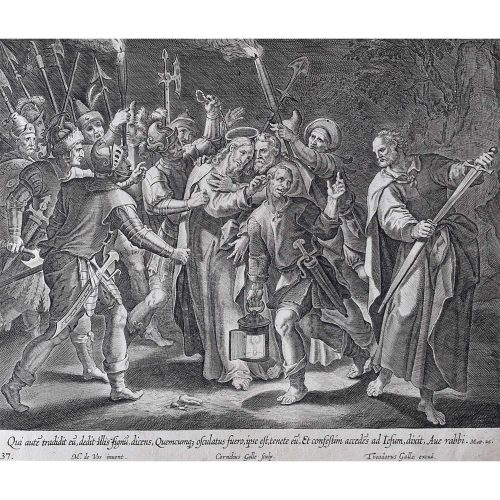
Theodoor Galle (c. 1571-1633) Cornelius Galle (1576-1650) after Maerten de Vos (1532 - 1603) 37. Qui aute tradidit eu, dedit illis fignu, dicens, Quemcumq osculatus fuero, ipse est, tenete eu. Et confestim accedes ad Iesum, dixit, Aue rabbi. Matth. 26.
Engraving From Vita, Passio, et Resurrectio Iesu Christi first published 1598, this a later edition published by Joannes Galle (1600-1676) 17.5x22cm From the Gospel of Matthew, Chapter 26 "The one I kiss, that’s the one—seize him.” He went straight to Jesus, greeted him, “How are you, Rabbi?" and kissed him.” Theodoor Galle was the son of Philip Galle, a Dutch publisher best known for his old master prints, from whom he learnt the craft. Theodoor married a daughter of the prominent family of Plantin in Antwerp. His marriage established the productive partnership between the Galle workshop and the Plantin Moretus printing house. A talented workman, Galle quickly became a respected engraver, print publisher and a member of the guild of St Luke, a city guild for artists in 1595. In the years to follow he became the guild's deacon. These particular plates are after paintings by Maerten de Vos, a Flemish painter and draughtsman. His father was Pieter de Vos, from whom he learned. From 1550 - 1558 he travelled in Italy, visiting Rome and Venice and becoming master of the Antwerp Guild of St Luke upon his return in 1558. After 1575 he was mainly engaged in producing print designs. If you are interested email info@manningfineart.co.uk or call us on 07929 749056. Condition: Trimmed to plate margins, generally good condition commensurate with age, slight age toning and handling marks as evident from image. -
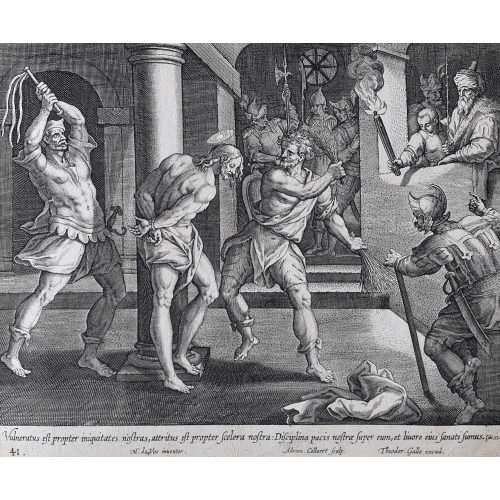
Theodoor Galle (c. 1571-1633) Adrian Collaert (1560-1618) after Maerten de Vos (1532 - 1603) 41. Vulneratus est propter iniquitates nostra, attritus est propter scelera nostra. Disciplina pacis nostrae super eum, et liuore eius sanati sumus. Isai. 53.
Engraving From Vita, Passio, et Resurrectio Iesu Christi first published 1598, this a later edition published by Joannes Galle (1600-1676) 17.5x22cm From the Gospel of Isaiah, Chapter 53 "But He was wounded for our transgressions, He was bruised for our iniquities; The chastisement for our peace was upon Him, And by His stripes we are healed." Theodoor Galle was the son of Philip Galle, a Dutch publisher best known for his old master prints, from whom he learnt the craft. Theodoor married a daughter of the prominent family of Plantin in Antwerp. His marriage established the productive partnership between the Galle workshop and the Plantin Moretus printing house. A talented workman, Galle quickly became a respected engraver, print publisher and a member of the guild of St Luke, a city guild for artists in 1595. In the years to follow he became the guild's deacon. Adrian Collaert was born in Antwerp between 1555 and 1565, becoming wijnmeester of the Guild of St Luke in 1580 - a title reserved for the sons of guild members. The guild of St Luke was generally the city guild for artists. Working for Philip Galle, a Dutch publisher best known for his old master prints, he married Galle's daughter Justa. After learning the principles of engraving in the Netherlands, he spent some years in Italy improving his skill. Upon returning to Flanders he engraved, in accomplished fashion, a great number of plates. His brother, Jan Collaert II, his son, Jan Baptist Collaert II and a grandson were all printmakers. These particular plates are after paintings by Maerten de Vos, a Flemish painter and draughtsman. His father was Pieter de Vos, from whom he learned. From 1550 - 1558 he travelled in Italy, visiting Rome and Venice and becoming master of the Antwerp Guild of St Luke upon his return in 1558. After 1575 he was mainly engaged in producing print designs. If you are interested email info@manningfineart.co.uk or call us on 07929 749056. Condition: Trimmed to plate margins, generally good condition commensurate with age, slight age toning and handling marks as evident from image. -
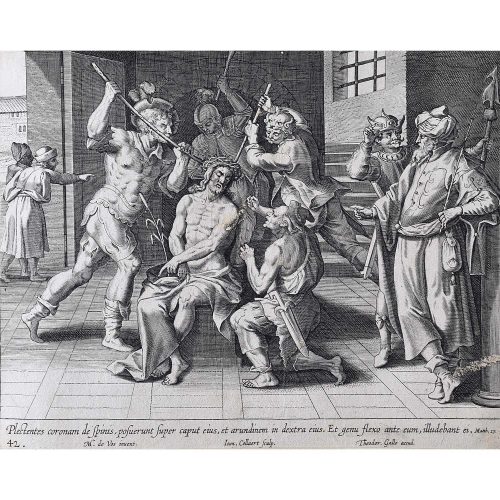
Theodoor Galle (c. 1571-1633) Johannes Collaert (1525-1580) after Maerten de Vos (1532 - 1603) 42. Plectentes coronam de spinis, posuerunt super caput eius, et arundinem in dextra eius. Et genu flexo ante eum, illudebant ei. Matth. 27.
Engraving From Vita, Passio, et Resurrectio Iesu Christi first published 1598, this a later edition published by Joannes Galle (1600-1676) 17.5x22cm From the Gospel of Matthew, Chapter 27 "When they had twisted a crown of thorns, they put it on His head, and a reed in His right hand. And they bowed the knee before Him and mocked Him." Theodoor Galle was the son of Philip Galle, a Dutch publisher best known for his old master prints, from whom he learnt the craft. Theodoor married a daughter of the prominent family of Plantin in Antwerp. His marriage established the productive partnership between the Galle workshop and the Plantin Moretus printing house. A talented workman, Galle quickly became a respected engraver, print publisher and a member of the guild of St Luke, a city guild for artists in 1595. In the years to follow he became the guild's deacon. Adrian Collaert was born in Antwerp between 1555 and 1565, becoming wijnmeester of the Guild of St Luke in 1580 - a title reserved for the sons of guild members. The guild of St Luke was generally the city guild for artists. Working for Philip Galle, a Dutch publisher best known for his old master prints, he married Galle's daughter Justa. After learning the principles of engraving in the Netherlands, he spent some years in Italy improving his skill. Upon returning to Flanders he engraved, in accomplished fashion, a great number of plates. His brother, Jan Collaert II, his son, Jan Baptist Collaert II and a grandson were all printmakers. These particular plates are after paintings by Maerten de Vos, a Flemish painter and draughtsman. His father was Pieter de Vos, from whom he learned. From 1550 - 1558 he travelled in Italy, visiting Rome and Venice and becoming master of the Antwerp Guild of St Luke upon his return in 1558. After 1575 he was mainly engaged in producing print designs. If you are interested email info@manningfineart.co.uk or call us on 07929 749056. Condition: Trimmed to plate margins, generally good condition commensurate with age, slight age toning and handling marks as evident from image. -
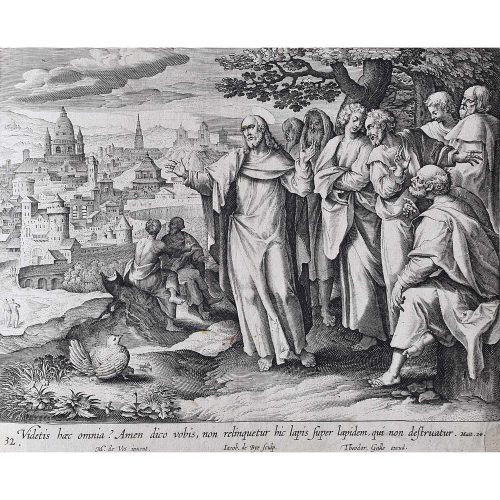
Theodoor Galle (c. 1571-1633) Jacob de Bye (1685-?) after Maerten de Vos (1532 - 1603) 31. Videtis hec omnia? Amen dico vobis, non relinquetur hic lapis super lapidem, qui non destruatur. Matth. 24.
Engraving From Vita, Passio, et Resurrectio Iesu Christi first published 1598, this a later edition published by Joannes Galle (1600-1676) 17.5x22cm From the Gospel of Matthew, chapter 24 "You see all of this? Verily I say unto you, there shall not be left here one stone upon another, that shall not be thrown down.” Theodoor Galle was the son of Philip Galle, a Dutch publisher best known for his old master prints, from whom he learnt the craft. Theodoor married a daughter of the prominent family of Plantin in Antwerp. His marriage established the productive partnership between the Galle workshop and the Plantin Moretus printing house. A talented workman, Galle quickly became a respected engraver, print publisher and a member of the guild of St Luke, a city guild for artists in 1595. In the years to follow he became the guild's deacon. These particular plates are after paintings by Maerten de Vos, a Flemish painter and draughtsman. His father was Pieter de Vos, from whom he learned. From 1550 - 1558 he travelled in Italy, visiting Rome and Venice and becoming master of the Antwerp Guild of St Luke upon his return in 1558. After 1575 he was mainly engaged in producing print designs. If you are interested email info@manningfineart.co.uk or call us on 07929 749056. Condition: Trimmed to plate margins, generally good condition commensurate with age, slight age toning and handling marks as evident from image. -
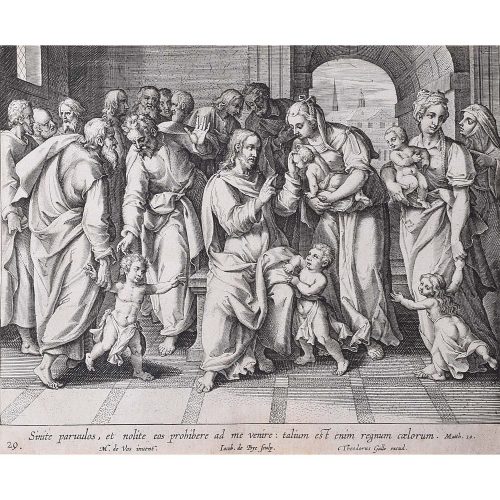
Theodoor Galle (1571 – 1633), Iacob de Bye (1581-1640) after Maerten de Vos (1532 - 1603) 29. Sinite paruulos, et nolite eos prohibere ad me venire : talium est enim reguum coelorum. 19.
Engraving From Vita, Passio, et Resurrectio Iesu Christi first published 1598, this a later edition published by Joannes Galle (1600-1676) 16.5x21.8cm Hand-finished wooden frame included (UK shipping only) From the Gospel of Matthew, chapter 19 "Suffer the little children, and forbid them not, to come unto me: for of such is the kingdom of heaven." Theodoor Galle was the son of Philip Galle, a Dutch publisher best known for his old master prints, from whom he learnt the craft. Theodoor married a daughter of the prominent family of Plantin in Antwerp. His marriage established the productive partnership between the Galle workshop and the Plantin Moretus printing house. A talented workman, Galle quickly became a respected engraver, print publisher and a member of the guild of St Luke, a city guild for artists in 1595. In the years to follow he became the guild's deacon. These particular plates are after paintings by Maerten de Vos, a Flemish painter and draughtsman. His father was Pieter de Vos, from whom he learned. From 1550 - 1558 he travelled in Italy, visiting Rome and Venice and becoming master of the Antwerp Guild of St Luke upon his return in 1558. After 1575 he was mainly engaged in producing print designs. If you are interested email info@manningfineart.co.uk or call us on 07929 749056. Condition: Trimmed to plate margins, generally good condition commensurate with age, slight age toning and handling marks as evident from image. -
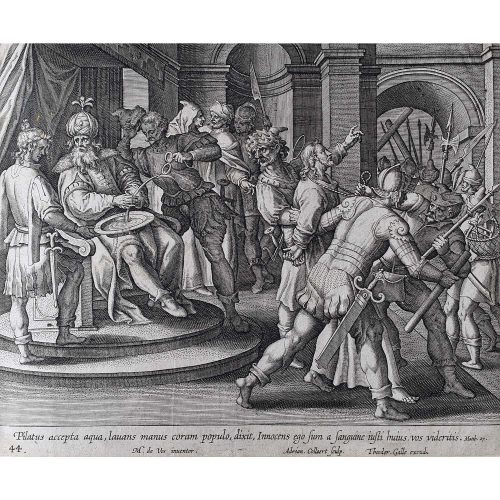
Theodoor Galle (c. 1571-1633) Adrian Collaert (c.1560-1618) after Maerten de Vos (1532 - 1603) 44. Pilatus accepta aqua, lauans manus coram populo, dixit, Innocens ego sum a sanguine insti huius vos videritus. Matth. 27.
Engraving From Vita, Passio, et Resurrectio Iesu Christi first published 1598, this a later edition published by Joannes Galle (1600-1676) 17.5x22cm From the Gospel of Matthew, Chapter 27 "When Pilate saw that he could not prevail at all, but rather that a tumult was rising, he took water and washed his hands before the multitude, saying, “I am innocent of the blood of this just Person. You see to it."" Theodoor Galle was the son of Philip Galle, a Dutch publisher best known for his old master prints, from whom he learnt the craft. Theodoor married a daughter of the prominent family of Plantin in Antwerp. His marriage established the productive partnership between the Galle workshop and the Plantin Moretus printing house. A talented workman, Galle quickly became a respected engraver, print publisher and a member of the guild of St Luke, a city guild for artists in 1595. In the years to follow he became the guild's deacon. Adrian Collaert was born in Antwerp between 1555 and 1565, becoming wijnmeester of the Guild of St Luke in 1580 - a title reserved for the sons of guild members. The guild of St Luke was generally the city guild for artists. Working for Philip Galle, a Dutch publisher best known for his old master prints, he married Galle's daughter Justa. After learning the principles of engraving in the Netherlands, he spent some years in Italy improving his skill. Upon returning to Flanders he engraved, in accomplished fashion, a great number of plates. His brother, Jan Collaert II, his son, Jan Baptist Collaert II and a grandson were all printmakers. These particular plates are after paintings by Maerten de Vos, a Flemish painter and draughtsman. His father was Pieter de Vos, from whom he learned. From 1550 - 1558 he travelled in Italy, visiting Rome and Venice and becoming master of the Antwerp Guild of St Luke upon his return in 1558. After 1575 he was mainly engaged in producing print designs. If you are interested email info@manningfineart.co.uk or call us on 07929 749056. Condition: Trimmed to plate margins, generally good condition commensurate with age, slight age toning and handling marks as evident from image. -
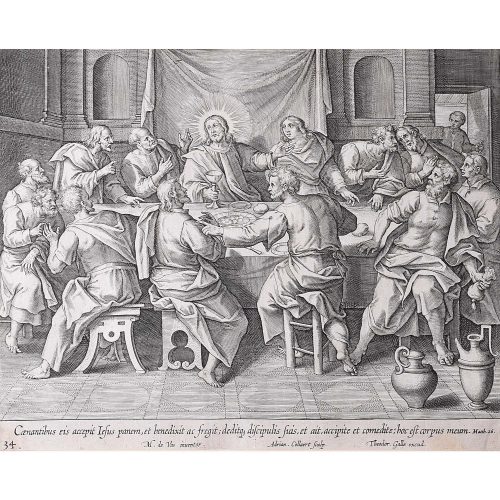
Adriaen Collaert (c. 1560-1618) Jacob de Bye (1581-1640) after Maerten de Vos (1532 - 1603) 34. Coenantibus eis accepit Iesus panem, et benedixit et fregit; deditq discipulis suis, et ait, accipite et comedite; hoc est corpus muem. Matth 16.
Engraving From Vita, Passio, et Resurrectio Iesu Christi first published 1598, this a later edition published by Joannes Galle (1600-1676) 17.5x22cm Hand-finished black frame included (UK shipping only) From the Gospel of Matthew, chapter 16 "And as they were eating, Jesus took bread, and blessed it, and brake it, and gave it to the disciples, and said, Take, eat; this is my body". Theodoor Galle was the son of Philip Galle, a Dutch publisher best known for his old master prints, from whom he learnt the craft. Theodoor married a daughter of the prominent family of Plantin in Antwerp. His marriage established the productive partnership between the Galle workshop and the Plantin Moretus printing house. A talented workman, Galle quickly became a respected engraver, print publisher and a member of the guild of St Luke, a city guild for artists in 1595. In the years to follow he became the guild's deacon. Adrian Collaert was born in Antwerp between 1555 and 1565, becoming wijnmeester of the Guild of St Luke in 1580 - a title reserved for the sons of guild members. The guild of St Luke was generally the city guild for artists. Working for Philip Galle, a Dutch publisher best known for his old master prints, he married Galle's daughter Justa. After learning the principles of engraving in the Netherlands, he spent some years in Italy improving his skill. Upon returning to Flanders he engraved, in accomplished fashion, a great number of plates. His brother, Jan Collaert II, his son, Jan Baptist Collaert II and a grandson were all printmakers. These particular plates are after paintings by Maerten de Vos, a Flemish painter and draughtsman. His father was Pieter de Vos, from whom he learned. From 1550 - 1558 he travelled in Italy, visiting Rome and Venice and becoming master of the Antwerp Guild of St Luke upon his return in 1558. After 1575 he was mainly engaged in producing print designs. If you are interested email info@manningfineart.co.uk or call us on 07929 749056. Condition: Trimmed to plate margins, generally good condition commensurate with age, slight age toning and handling marks as evident from image. -
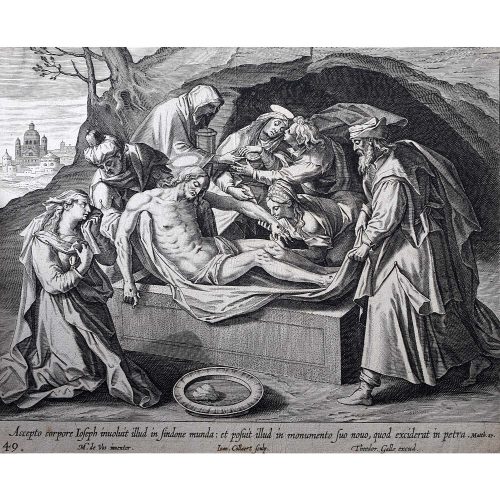
Theodoor Galle (c. 1571-1633) Jan Collaert (1545-1628) after Maerten de Vos (1532 - 1603) 49. Accepto corpore Ioseph inuoluit in sindone munda: et posuit illud in monumento suo nouo, quod exciderat in petra. Matth. 27.
Engraving From Vita, Passio, et Resurrectio Iesu Christi first published 1598, this a later edition published by Joannes Galle (1600-1676) 17.5x22cm From the Gospel of Matthew, Chapter 27 "Taking the body, wrapped in a linen cloth and placed it in his own new tomb, which had been cut into the rock." Theodoor Galle was the son of Philip Galle, a Dutch publisher best known for his old master prints, from whom he learnt the craft. Theodoor married a daughter of the prominent family of Plantin in Antwerp. His marriage established the productive partnership between the Galle workshop and the Plantin Moretus printing house. A talented workman, Galle quickly became a respected engraver, print publisher and a member of the guild of St Luke, a city guild for artists in 1595. In the years to follow he became the guild's deacon. These particular plates are after paintings by Maerten de Vos, a Flemish painter and draughtsman. His father was Pieter de Vos, from whom he learned. From 1550 - 1558 he travelled in Italy, visiting Rome and Venice and becoming master of the Antwerp Guild of St Luke upon his return in 1558. After 1575 he was mainly engaged in producing print designs. If you are interested email info@manningfineart.co.uk or call us on 07929 749056. Condition: Trimmed to plate margins, generally good condition commensurate with age, slight age toning and handling marks as evident from image. -

Theodoor Galle (c. 1571-1633) Jan Baptist Barbé (1578-1649) after Maerten de Vos (1532 - 1603) 40. Vt cognouit Pilatus quod de Herodis potestate esset, remisit eum Herodem, qui et ipse Hierosolymis erat illis diebus. Luc 23.
Engraving From Vita, Passio, et Resurrectio Iesu Christi first published 1598, this a later edition published by Joannes Galle (1600-1676) 17.5x22cm From the Gospel of Luke, Chapter 23 "When he discovered that he came under Herod’s jurisdiction, he passed him on to Herod who happened to be in Jerusalem at that time." Theodoor Galle was the son of Philip Galle, a Dutch publisher best known for his old master prints, from whom he learnt the craft. Theodoor married a daughter of the prominent family of Plantin in Antwerp. His marriage established the productive partnership between the Galle workshop and the Plantin Moretus printing house. A talented workman, Galle quickly became a respected engraver, print publisher and a member of the guild of St Luke, a city guild for artists in 1595. In the years to follow he became the guild's deacon. These particular plates are after paintings by Maerten de Vos, a Flemish painter and draughtsman. His father was Pieter de Vos, from whom he learned. From 1550 - 1558 he travelled in Italy, visiting Rome and Venice and becoming master of the Antwerp Guild of St Luke upon his return in 1558. After 1575 he was mainly engaged in producing print designs. If you are interested email info@manningfineart.co.uk or call us on 07929 749056. Condition: Trimmed to plate margins, generally good condition commensurate with age, slight age toning and handling marks as evident from image. -
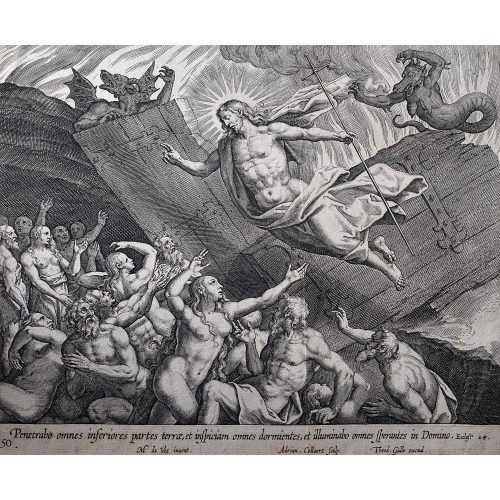
Theodoor Galle (c. 1571-1633) Jan Collaert (1545-1628) after Maerten de Vos (1532 - 1603) 50. Penetrabo omnes inferiores partes terre, et inspiciam omnes dormientes, et illuminabo omnes sperantes in Domino. Eccles. 24.
Engraving From Vita, Passio, et Resurrectio Iesu Christi first published 1598, this a later edition published by Joannes Galle (1600-1676) 17.5x22cm
From the Gospel of Ecclesiasticus, Chapter 24 "Penetrate all the lower parts of the earth, and behold all and illuminate all who hope in the Lord." Theodoor Galle was the son of Philip Galle, a Dutch publisher best known for his old master prints, from whom he learnt the craft. Theodoor married a daughter of the prominent family of Plantin in Antwerp. His marriage established the productive partnership between the Galle workshop and the Plantin Moretus printing house. A talented workman, Galle quickly became a respected engraver, print publisher and a member of the guild of St Luke, a city guild for artists in 1595. In the years to follow he became the guild's deacon. Adriaen Collaert was born in Antwerp between 1555 and 1565, becoming wijnmeester of the Guild of St Luke in 1580 - a title reserved for the sons of guild members. The guild of St Luke was generally the city guild for artists. Working for Philip Galle, a Dutch publisher best known for his old master prints, he married Galle's daughter Justa. After learning the principles of engraving in the Netherlands, he spent some years in Italy improving his skill. Upon returning to Flanders he engraved, in accomplished fashion, a great number of plates. His brother, Jan Collaert II, his son, Jan Baptist Collaert II and a grandson were all printmakers. These particular plates are after paintings by Maerten de Vos, a Flemish painter and draughtsman. His father was Pieter de Vos, from whom he learned. From 1550 - 1558 he travelled in Italy, visiting Rome and Venice and becoming master of the Antwerp Guild of St Luke upon his return in 1558. After 1575 he was mainly engaged in producing print designs. If you are interested email info@manningfineart.co.uk or call us on 07929 749056. Condition: Trimmed to plate margins, generally good condition commensurate with age, slight age toning and handling marks as evident from image. -
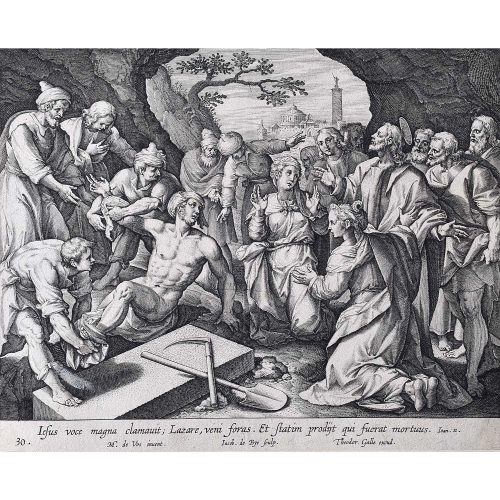
Theodoor Galle (c. 1571-1633) Jacob de Bye (1685-?) after Maerten de Vos (1532 - 1603) 30. Iesus voce magna clamauit; Lazare, veni foras. Et statim proijt qui fuerat mortuus. Iohn. 11.
Engraving From Vita, Passio, et Resurrectio Iesu Christi first published 1598, this a later edition published by Joannes Galle (1600-1676) 17.5x22cm From the Gospel of John, chapter 11 "Jesus called in a loud voice, “Lazarus, come out!” The dead man came out.” Theodoor Galle was the son of Philip Galle, a Dutch publisher best known for his old master prints, from whom he learnt the craft. Theodoor married a daughter of the prominent family of Plantin in Antwerp. His marriage established the productive partnership between the Galle workshop and the Plantin Moretus printing house. A talented workman, Galle quickly became a respected engraver, print publisher and a member of the guild of St Luke, a city guild for artists in 1595. In the years to follow he became the guild's deacon. These particular plates are after paintings by Maerten de Vos, a Flemish painter and draughtsman. His father was Pieter de Vos, from whom he learned. From 1550 - 1558 he travelled in Italy, visiting Rome and Venice and becoming master of the Antwerp Guild of St Luke upon his return in 1558. After 1575 he was mainly engaged in producing print designs. If you are interested email info@manningfineart.co.uk or call us on 07929 749056. Condition: Trimmed to plate margins, generally good condition commensurate with age, slight age toning and handling marks as evident from image. -
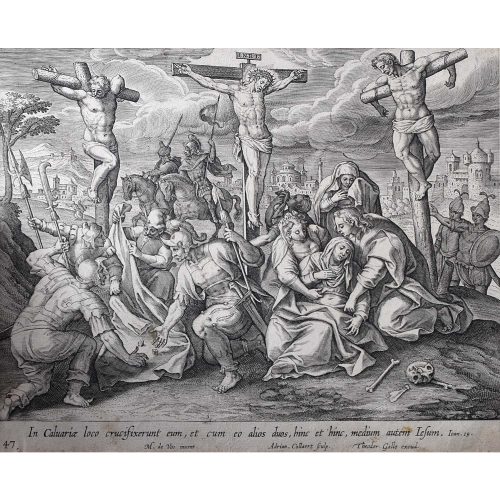
Theodoor Galle (c. 1571-1633) Adrian Collaert (c.1560-1618) after Maerten de Vos (1532 - 1603) 47. In Caluarie loco crucifixerunt eum, et cum eo alios duos, hinc, medium autem Iesum. Ioan. 19.
Engraving From Vita, Passio, et Resurrectio Iesu Christi first published 1598, this a later edition published by Joannes Galle (1600-1676) 17.5x22cm From the Gospel of John, Chapter 19 "There they crucified him, and with him two others—one on each side and Jesus in the middle." Theodoor Galle was the son of Philip Galle, a Dutch publisher best known for his old master prints, from whom he learnt the craft. Theodoor married a daughter of the prominent family of Plantin in Antwerp. His marriage established the productive partnership between the Galle workshop and the Plantin Moretus printing house. A talented workman, Galle quickly became a respected engraver, print publisher and a member of the guild of St Luke, a city guild for artists in 1595. In the years to follow he became the guild's deacon. Adriaen Collaert was born in Antwerp between 1555 and 1565, becoming wijnmeester of the Guild of St Luke in 1580 - a title reserved for the sons of guild members. The guild of St Luke was generally the city guild for artists. Working for Philip Galle, a Dutch publisher best known for his old master prints, he married Galle's daughter Justa. After learning the principles of engraving in the Netherlands, he spent some years in Italy improving his skill. Upon returning to Flanders he engraved, in accomplished fashion, a great number of plates. His brother, Jan Collaert II, his son, Jan Baptist Collaert II and a grandson were all printmakers. These particular plates are after paintings by Maerten de Vos, a Flemish painter and draughtsman. His father was Pieter de Vos, from whom he learned. From 1550 - 1558 he travelled in Italy, visiting Rome and Venice and becoming master of the Antwerp Guild of St Luke upon his return in 1558. After 1575 he was mainly engaged in producing print designs. If you are interested email info@manningfineart.co.uk or call us on 07929 749056. Condition: Trimmed to plate margins, generally good condition commensurate with age, slight age toning and handling marks as evident from image. -
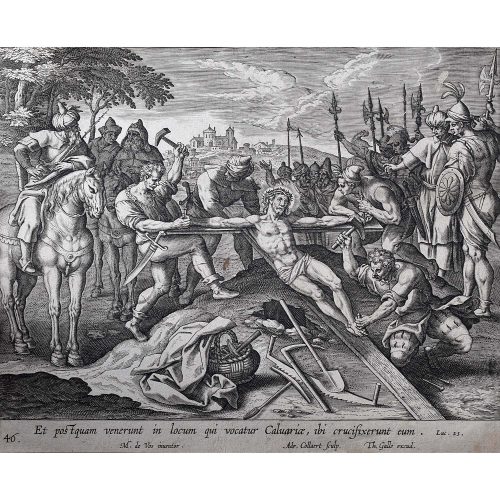
Theodoor Galle (c. 1571-1633) Adrian Collaert (c.1560-1618) after Maerten de Vos (1532 - 1603) 46. Et postquam venerunt in locum qui voctur Caluarie, ibi crucifixerunt eum. Luc. 23.
Engraving From Vita, Passio, et Resurrectio Iesu Christi first published 1598, this a later edition published by Joannes Galle (1600-1676) 17.5x22cm From the Gospel of Luke, Chapter 23 "When they came to the place called the Skull, they crucified him there." Theodoor Galle was the son of Philip Galle, a Dutch publisher best known for his old master prints, from whom he learnt the craft. Theodoor married a daughter of the prominent family of Plantin in Antwerp. His marriage established the productive partnership between the Galle workshop and the Plantin Moretus printing house. A talented workman, Galle quickly became a respected engraver, print publisher and a member of the guild of St Luke, a city guild for artists in 1595. In the years to follow he became the guild's deacon. Adriaen Collaert was born in Antwerp between 1555 and 1565, becoming wijnmeester of the Guild of St Luke in 1580 - a title reserved for the sons of guild members. The guild of St Luke was generally the city guild for artists. Working for Philip Galle, a Dutch publisher best known for his old master prints, he married Galle's daughter Justa. After learning the principles of engraving in the Netherlands, he spent some years in Italy improving his skill. Upon returning to Flanders he engraved, in accomplished fashion, a great number of plates. His brother, Jan Collaert II, his son, Jan Baptist Collaert II and a grandson were all printmakers. These particular plates are after paintings by Maerten de Vos, a Flemish painter and draughtsman. His father was Pieter de Vos, from whom he learned. From 1550 - 1558 he travelled in Italy, visiting Rome and Venice and becoming master of the Antwerp Guild of St Luke upon his return in 1558. After 1575 he was mainly engaged in producing print designs. If you are interested email info@manningfineart.co.uk or call us on 07929 749056. Condition: Trimmed to plate margins, generally good condition commensurate with age, slight age toning and handling marks as evident from image. -
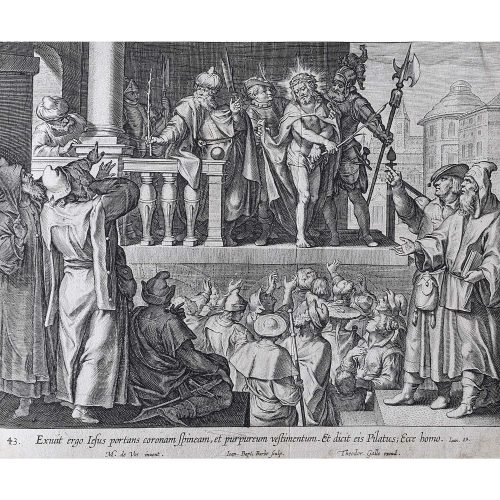
Theodoor Galle (c. 1571-1633) Jan Baptist Barbe (1578-1649) after Maerten de Vos (1532 - 1603) 43. Exiuit ergo Iesus portans coronam spineam, et purpureum vestimentum. Et dicit eis Pilatus; Ecce homo. Ioan. 19.
Engraving From Vita, Passio, et Resurrectio Iesu Christi first published 1598, this a later edition published by Joannes Galle (1600-1676) 17.5x22cm From the Gospel of John, Chapter 19 "Then Jesus came out, wearing the crown of thorns and the purple robe. And Pilate said to them, Behold the Man!" Theodoor Galle was the son of Philip Galle, a Dutch publisher best known for his old master prints, from whom he learnt the craft. Theodoor married a daughter of the prominent family of Plantin in Antwerp. His marriage established the productive partnership between the Galle workshop and the Plantin Moretus printing house. A talented workman, Galle quickly became a respected engraver, print publisher and a member of the guild of St Luke, a city guild for artists in 1595. In the years to follow he became the guild's deacon. These particular plates are after paintings by Maerten de Vos, a Flemish painter and draughtsman. His father was Pieter de Vos, from whom he learned. From 1550 - 1558 he travelled in Italy, visiting Rome and Venice and becoming master of the Antwerp Guild of St Luke upon his return in 1558. After 1575 he was mainly engaged in producing print designs. If you are interested email info@manningfineart.co.uk or call us on 07929 749056. Condition: Trimmed to plate margins, generally good condition commensurate with age, slight age toning and handling marks as evident from image. -
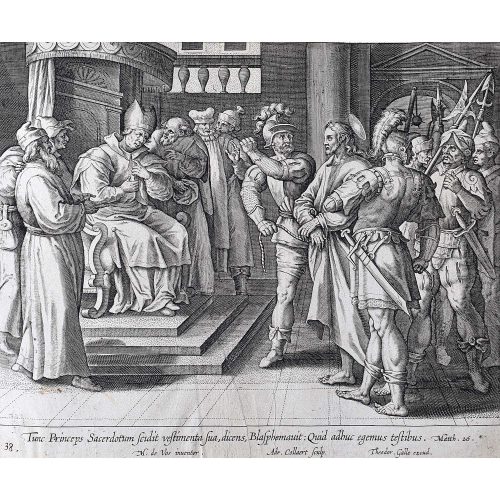
Theodoor Galle (c. 1571-1633) Adrian Collaert (1560-1618) after Maerten de Vos (1532 - 1603) 38. Tunc Princeps Sacerdotum scidit veftimenta sua, dicens, Blasphemauit: Quid adhuc egemus testibus. Matth. 26.
Engraving From Vita, Passio, et Resurrectio Iesu Christi first published 1598, this a later edition published by Joannes Galle (1600-1676) 17.5x22cm From the Gospel of Matthew, Chapter 26 "Then the high priest tore his clothes, saying, “He has spoken blasphemy! What further need do we have of witnesses?” Theodoor Galle was the son of Philip Galle, a Dutch publisher best known for his old master prints, from whom he learnt the craft. Theodoor married a daughter of the prominent family of Plantin in Antwerp. His marriage established the productive partnership between the Galle workshop and the Plantin Moretus printing house. A talented workman, Galle quickly became a respected engraver, print publisher and a member of the guild of St Luke, a city guild for artists in 1595. In the years to follow he became the guild's deacon. These particular plates are after paintings by Maerten de Vos, a Flemish painter and draughtsman. His father was Pieter de Vos, from whom he learned. From 1550 - 1558 he travelled in Italy, visiting Rome and Venice and becoming master of the Antwerp Guild of St Luke upon his return in 1558. After 1575 he was mainly engaged in producing print designs. If you are interested email info@manningfineart.co.uk or call us on 07929 749056. Condition: Trimmed to plate margins, generally good condition commensurate with age, slight age toning and handling marks as evident from image. -
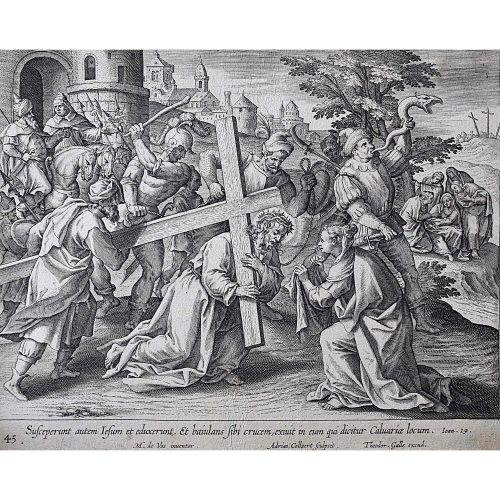
Theodoor Galle (c. 1571-1633) Adrian Collaert (c.1560-1618) after Maerten de Vos (1532 - 1603) 45. Susceperunt autem Iesum eduxerunt. Et baiulans sibi crucem, exiuit in eum qui dicitur Caluarie locum. Ioan. 19.
Engraving From Vita, Passio, et Resurrectio Iesu Christi first published 1598, this a later edition published by Joannes Galle (1600-1676) 17.5x22cm From the Gospel of John, Chapter 19 "And He, bearing His cross, went out to a place called the Place of a Skull." Theodoor Galle was the son of Philip Galle, a Dutch publisher best known for his old master prints, from whom he learnt the craft. Theodoor married a daughter of the prominent family of Plantin in Antwerp. His marriage established the productive partnership between the Galle workshop and the Plantin Moretus printing house. A talented workman, Galle quickly became a respected engraver, print publisher and a member of the guild of St Luke, a city guild for artists in 1595. In the years to follow he became the guild's deacon. Adriaen Collaert was born in Antwerp between 1555 and 1565, becoming wijnmeester of the Guild of St Luke in 1580 - a title reserved for the sons of guild members. The guild of St Luke was generally the city guild for artists. Working for Philip Galle, a Dutch publisher best known for his old master prints, he married Galle's daughter Justa. After learning the principles of engraving in the Netherlands, he spent some years in Italy improving his skill. Upon returning to Flanders he engraved, in accomplished fashion, a great number of plates. His brother, Jan Collaert II, his son, Jan Baptist Collaert II and a grandson were all printmakers. These particular plates are after paintings by Maerten de Vos, a Flemish painter and draughtsman. His father was Pieter de Vos, from whom he learned. From 1550 - 1558 he travelled in Italy, visiting Rome and Venice and becoming master of the Antwerp Guild of St Luke upon his return in 1558. After 1575 he was mainly engaged in producing print designs. If you are interested email info@manningfineart.co.uk or call us on 07929 749056. Condition: Trimmed to plate margins, generally good condition commensurate with age, slight age toning and handling marks as evident from image. -
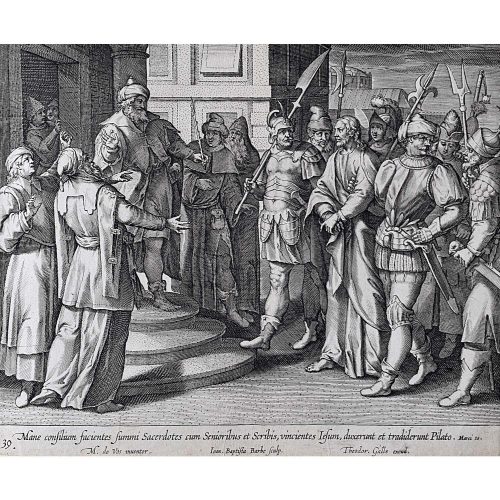
Theodoor Galle (c. 1571-1633) Jan Baptist Barbé (1578-1649) after Maerten de Vos (1532 - 1603) 39. Mane consilium facientes summi sacerdotes cum Senioribus et Scribis, vincientes Iesum, duxerunt et tradiderunt Pilato. Marci. 15.
Engraving From Vita, Passio, et Resurrectio Iesu Christi first published 1598, this a later edition published by Joannes Galle (1600-1676) 17.5x22cm From the Gospel of Mark, Chapter 15 "In the morning, the high priests and elders and teachers, binding Jesus, led him away and delivered him to Pilate." Theodoor Galle was the son of Philip Galle, a Dutch publisher best known for his old master prints, from whom he learnt the craft. Theodoor married a daughter of the prominent family of Plantin in Antwerp. His marriage established the productive partnership between the Galle workshop and the Plantin Moretus printing house. A talented workman, Galle quickly became a respected engraver, print publisher and a member of the guild of St Luke, a city guild for artists in 1595. In the years to follow he became the guild's deacon. These particular plates are after paintings by Maerten de Vos, a Flemish painter and draughtsman. His father was Pieter de Vos, from whom he learned. From 1550 - 1558 he travelled in Italy, visiting Rome and Venice and becoming master of the Antwerp Guild of St Luke upon his return in 1558. After 1575 he was mainly engaged in producing print designs. If you are interested email info@manningfineart.co.uk or call us on 07929 749056. Condition: Trimmed to plate margins, generally good condition commensurate with age, slight age toning and handling marks as evident from image. -
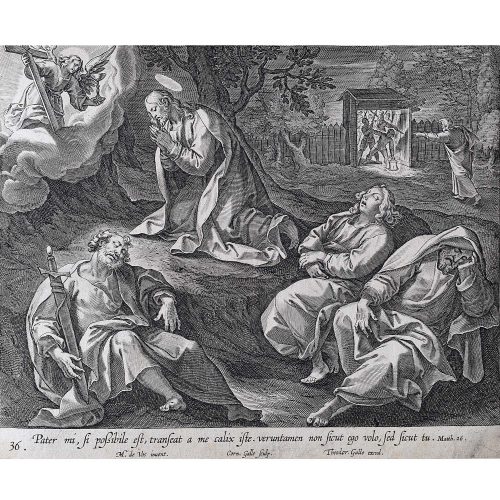
Theodoor Galle (c. 1571-1633) Cornelius Galle (1576-1650) after Maerten de Vos (1532 - 1603) 35. Pater mi, possibile est, transeat a me calix iste. veruntamen non ficut ego volo, sed sicut tu. Matth. 26.
Engraving From Vita, Passio, et Resurrectio Iesu Christi first published 1598, this a later edition published by Joannes Galle (1600-1676) 17.5x22cm From the Gospel of Matthew, Chapter 26 "My Father, if it is possible, may this cup be taken from me. Yet not as I will, but as you will.” Theodoor Galle was the son of Philip Galle, a Dutch publisher best known for his old master prints, from whom he learnt the craft. Theodoor married a daughter of the prominent family of Plantin in Antwerp. His marriage established the productive partnership between the Galle workshop and the Plantin Moretus printing house. A talented workman, Galle quickly became a respected engraver, print publisher and a member of the guild of St Luke, a city guild for artists in 1595. In the years to follow he became the guild's deacon. These particular plates are after paintings by Maerten de Vos, a Flemish painter and draughtsman. His father was Pieter de Vos, from whom he learned. From 1550 - 1558 he travelled in Italy, visiting Rome and Venice and becoming master of the Antwerp Guild of St Luke upon his return in 1558. After 1575 he was mainly engaged in producing print designs. If you are interested email info@manningfineart.co.uk or call us on 07929 749056. Condition: Trimmed to plate margins, generally good condition commensurate with age, slight age toning and handling marks as evident from image. -
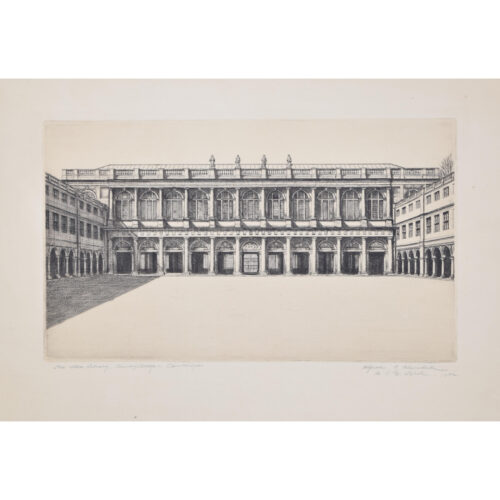
Alfred Richard Blundell (1883 - 1968)
The Wren Library, Trinity College, Cambridge
Etching 15 x 25 cm Signed, titled and inscribed 'to C A Walsh 1952' in pencil. Trinity's magnificent Wren Library was designed by Christopher Wren in 1676 and completed in 1695. Here, the artist captures the library's imposing architectural symmetry. Alfred Blundell was a painter, printmaker and glass engraver who studied at the Slade School of Fine Art. He exhibited at the Royal Academy and the Fitzwilliam Museum, Cambridge holds several of his pictures. Condition: generally very good; old tape reside to very corners. If you are interested, please email info@manningfineart.co.uk or call us on 07929 749056. Click here for other views of Trinity College, Cambridge. -
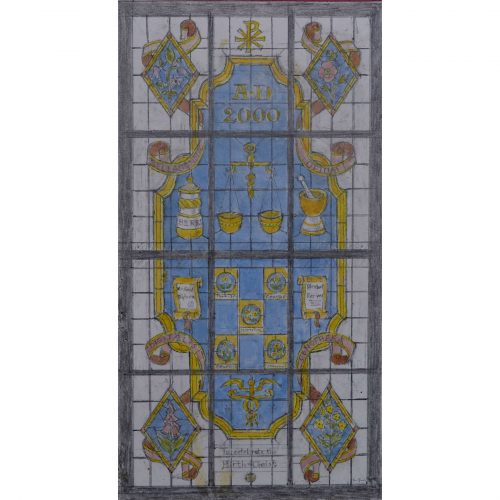
Jane Gray (b.1931)
The Worshipful Society of Apothecaries, Design for Stained Glass Millennium Window (1999)
Watercolour 25 x 13.5 cmSigned.
The Worshipful Society of Apothecaries was founded in 1617, after breaking away from the Grocers’ Company (founded 1345). The Society were granted a royal charter by James I, and, throughout the remainder of the 17th century, challenged the College of Physicians monopoly on practicing medicine. In 1704, the House of Lords overturned a ruling of the Queen’s Bench that gave apothecaries the right to practice medicine. Apothecaries, therefore, may be viewed as the forerunners of present-day general (medical) practitioners or family physicians. Gray’s design for this 2000 memorial window, in the Apothecaries Hall in Blackfriars, London, features the names and illustrations of several medicinal plants, including Belladonna, Opium, Digitalis, Oenothara, Primrose, Cowslip, Nasturtium, Camomile, and Marigold.
Provenance: the artist’s studio sale. Condition: very good. If you are interested, please email info@manningfineart.co.uk or call us on 07929 749056. For other works by Jane Gray and more information about her, please click here. -
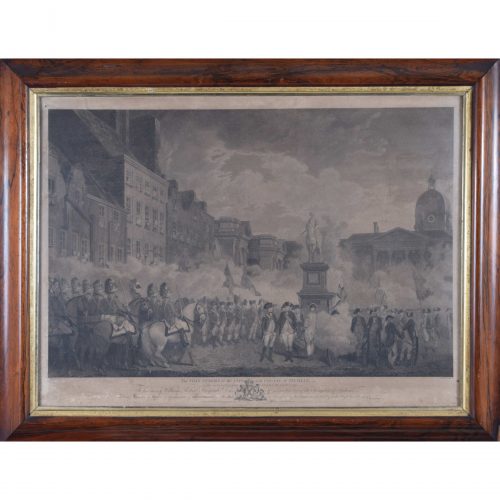
Joseph Collyer (1748 - 1827) after Francis Wheatley (1747 - 1801)
The Volunteers of the City and County of Dublin
Monochrome print 28 x 31 cm A monochrome print depicting Dublin regiments of the Irish Volunteers meeting on College Green. Francis Wheatley depicted the scene in oils in 1779, and Joseph Collyer engraved it in 1781. Wheatley went to Dublin in 1779 and established himself there as a portrait-painter; this view of the Dublin Volunteers became the basis for a best-selling print bought by numerous Irish Patriots. Volunteers were local Irish militias raised by community initiative in Ireland in 1778. Their original purpose was to guard against invasion and to preserve law and order at a time when British soldiers were withdrawn from Ireland to fight abroad during the American Revolutionary War and the government failed to organise its own militia. Taking advantage of Britain's preoccupation with its rebelling American colonies, the Volunteers were able to pressure Westminster into conceding legislative independence to the Dublin parliament. Francis Wheatley was an English portrait and landscape painter who studied at the Royal Academy, and won several prizes from the Society of Arts. He was elected an associate of the Royal Academy in 1790, and an academician in the following year. Joseph Collyer was a British engraver. In 1770 where he exhibited at the Royal Academy for the first time; he was elected an associate engraver of the Royal Academy, and appointed portrait engraver to Queen Charlotte in 1786. Condition: fair. Some browning and staining. In handsome rosewood frame. If you are interested, please email info@manningfineart.co.uk or call us on 07929 749056. -
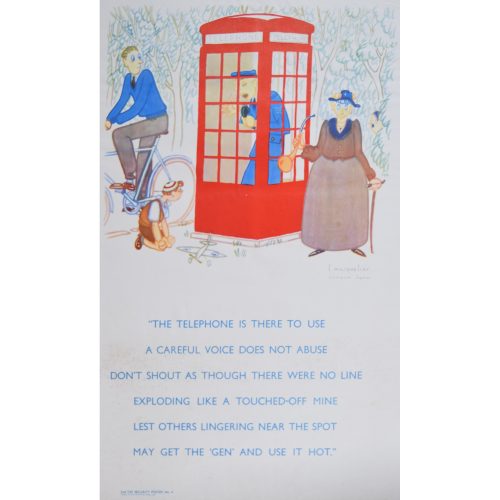
Louis Masquelier (1898-1945)
The Telephone
L. Masquelier/ Lorraine Sqdrn. (2nd TAF Security Poster No.4) Lithographic Poster 55x34.5cm Issued by the 2nd Tactical Airforce ('TAF'). This was a combination of both fighter and bomber units formed for the purposes of supporting the army in the 1944 invasion of Europe. The artist was a Sergent-chef (sergeant) in No 342 (Lorraine) Squadron RAF, a Free French Squadron transferred back to the Armée de l'Air in December 1945. An air gunner - and relatively old at 41 at the beginning of the war - he flew on many operations, also serving as cine-cameraman thanks to his artistic skills. He died on 28 May 1945, after the end of the war. Here a Frenchman has depicted that most English of items, Giles Gilbert Scott's K2 telephone box warning members of the 2nd TAF to be careful when using the telephone. If you are interested email info@manningfineart.co.uk or call us on 07929 749056. -
Out of stock
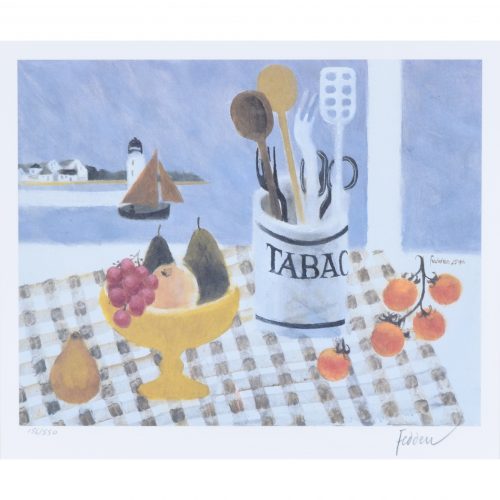
Mary Fedden (1915 - 2012)
The Tabac Jar
Lithograph 26 x 31 cm Signed lower right and numbered 156/550 lower left, both in pencil; signed and dated 1996 in the plate. A typically Fedden still life: a fruit bowl, jug of utensils, and vine of tomatoes on a gingham tablecloth. Beyond the table, a harbour scene including whitewashed buildings, sailing boat, and lighthouse. The form of the objects in her still life composition, and her lilting use of perspective, are immediately recognisable as Fedden's style. Mary Fedden was a Bristol-born artist who studied at the Slade School of Art in London in the 1930s. She painted sets for ballets at Sadlers Wells, then went on to teach art and paint portraits in Bristol. During the war she served in the Land Army and the Woman's Voluntary Service, and then worked in London as a stage painter for the Arts Theatre. In 1944 she went overseas as a driver for the Navy, Army and Air Force Institutes. In 1946 she resumed easel painting and held her first exhibition at the Mansard Gallery in Heal's Department Store in 1947. In 1951 she married the artist Julian Trevelyan, and the couple travelled the world together. She began to teach painting at the Royal Academy in the late 1950s and was elected RA in 1992. She lived and worked in her Durham Wharf studio from 1949 until her death. Condition: generally very good; framed. If you are interested, please email info@manningfineart.co.uk or call us on 07929 749056. Click here for other pictures by Mary Fedden. -
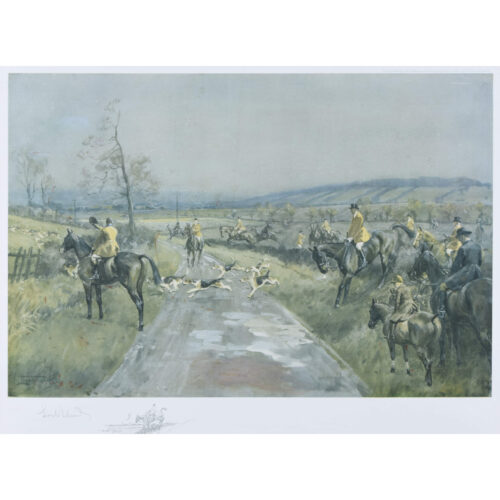
Lionel Edwards (1878 - 1966)
The South Notts Hunt (1928)
Lithograph 31 x 51 cm Signed and dated in plate lower left, and in pencil outside plate lower left. Note to reverse (1988) identifies those illustrated. A Lionel Edwards lithograph depicting the South Notts Hunt - part of the artist's 'Hunting Countries' series. The South Notts country lies in Nottinghamshire and Derbyshire and has been hunted as far back as 1677 by the Earl of Lincoln. In 1775 it was hunted by John Musters, the great-grandfather of John Chaworth-Musters, and in 1860 Mr. John Chaworth-Musters re-established the hunt. Lionel Edwards was a British artist who specialised in pictures of country life, particularly horses, and provided illustrations for Country Life. He is best known for his hunting scenes but also painted pictures of horse racing, shooting and fishing. Condition: print good; original handsome period frame. If you are interested, please email info@manningfineart.co.uk or call us on 07929 749056. Click here for other hunting pictures. -
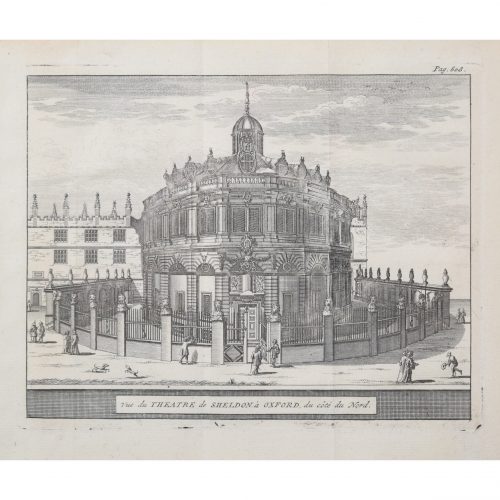
Pieter van der Aa (1659-1733), after David Loggan (1634–1692)
The Sheldonian Theatre, University of Oxford (1727)
Engraving 12 x 16 cm An eighteenth-century view of Oxford's marvellous Sheldonian Theatre, engraved by Pieter van der Aa after David Loggan, the noted engraver, draughtsman, and painter. Christopher Wren designed the building and it was constructed between 1664 and 1669; it takes its name from Gilbert Sheldon, chancellor of the University at the time and the Theatre's main financial backer. Pieter van der Aa of Leiden was a Dutch publisher best known for preparing maps and atlases, though he also printed editions of foreign bestsellers and illustrated volumes. He is noted for the many engravings he produced after David Loggan's series of Oxford and Cambridge colleges and costumes. In 1727 Van Der Aa illustrated "Les Delices de la Grande Bretagne & de L'Irelande" by James Beeverell, the book in which this engraving appears. Condition: a good impression. If you’d like to know more, please email info@manningfineart.co.uk or call us on 07929 749056. -
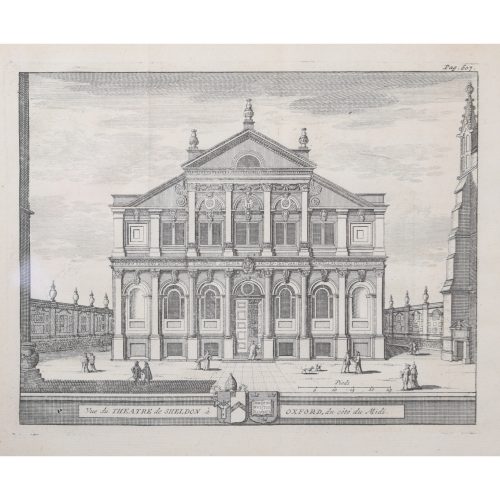
Pieter van der Aa (1659-1733), after David Loggan (1634–1692)
The Sheldonian Theatre, University of Oxford (1727)
Engraving 12 x 16 cm An eighteenth-century view of Oxford's marvellous Sheldonian Theatre, engraved by Pieter van der Aa after David Loggan, the noted engraver, draughtsman, and painter. Christopher Wren designed the building and it was constructed between 1664 and 1669; it takes its name from Gilbert Sheldon, chancellor of the University at the time and the Theatre's main financial backer. Pieter van der Aa of Leiden was a Dutch publisher best known for preparing maps and atlases, though he also printed editions of foreign bestsellers and illustrated volumes. He is noted for the many engravings he produced after David Loggan's series of Oxford and Cambridge colleges and costumes. In 1727 Van Der Aa illustrated "Les Delices de la Grande Bretagne & de L'Irelande" by James Beeverell, the book in which this engraving appears. Condition: a good impression. If you’d like to know more, please email info@manningfineart.co.uk or call us on 07929 749056. -
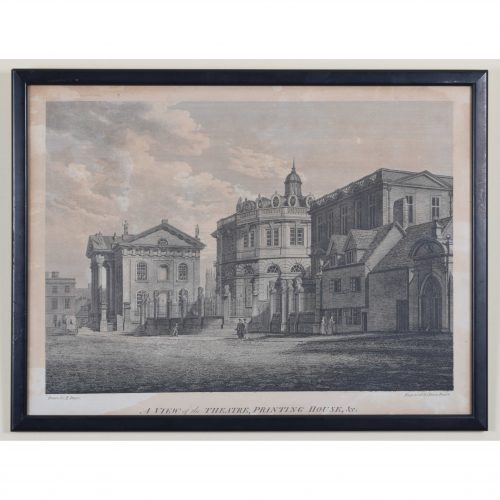
James Basire II (1769 - 1822) after Edward Dayes (1763 - 1804)
A View of the Theatre, Printing House, & c. (1800)
Engraving 36 x 49 cm A view of Broad Street, showing the Clarendon Building, Sheldonian Theatre, and what is now the Museum of the History of Science. Edward Dayes' drawing was reproduced as a lithograph in 1800, to be published in the "Oxford Almanack". The Oxford Almanack was an annual almanack published by the Oxford University Press for the University of Oxford from 1674 through 2019 (when printing sadly ceased due to "dwindling interest"). The almanack traditionally included engravings or lithographs of the University and information about the upcoming year. Other almanack artists have included Michael Burghers, J. M. W. Turner, and John Piper. Basire and Dayes collaborated on several views of Oxford during the courses of their careers. Edward Dayes was a British painter and engraver. He exhibited topographical views at the Royal Academy from 1786 until his death, and is the author of an ''Excursion through Derbyshire and Yorkshire,'' ''Essays on Painting; Instructions for Drawing and Colouring Landscapes'', and ''Professional Sketches of Modem Artists''. James Basire II was a British engraver, son of James Basire I, also a celebrated engraver. In 1802 he became Engraver to the Society of Antiquaries. Condition: some browning, as visible in photograph. If you’d like to know more, please email info@manningfineart.co.uk or call us on 07929 749056. -
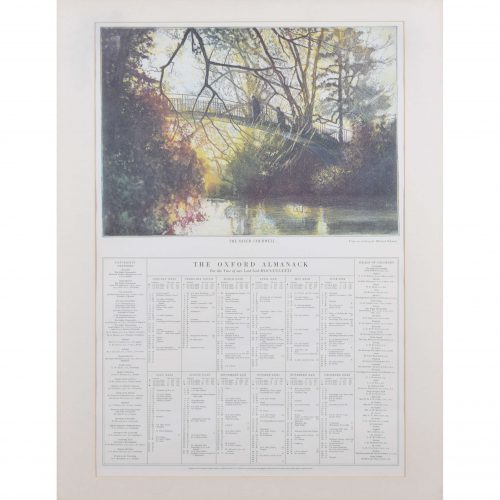
after Michael Oelman (born 1941)
The River Cherwell, The Oxford Almanac 1981
Lithograph 71 x 47 cm A lithograph featuring Oxford's wondrous River Cherwell in University Parks, after an etching by Michael Oelman. A setting sun casts its gold light over the glassy surface of the river and its surrounding trees; two figures cross the Cherwell via the famous Rainbow Bridge. The curved footbridge was built in the early 1920s by the University a project for the unemployed. Oelman's etching was reproduced as a lithograph in 1981, to be published in the "Oxford Almanack". The Oxford Almanack was an annual almanac published by the Oxford University Press for the University of Oxford from 1674 through 2019 (when printing sadly ceased due to "dwindling interest"). The almanac traditionally included engravings or lithographs of the University and information about the upcoming year. Other almanac artists have included James Basire, Michael Burghers, J. M. W. Turner, and John Piper. Michael Oelman was born in Llandudno, Wales, in 1941. He studied fine art at Reading University and then etching and lithography at the Central and Slade Schools of Art. In the 1960s he studied with S. W. Hayter in Paris, and then became a lecturer in Printmaking at Doncaster College of Art, Yorkshire. His studio is in Suffolk. Condition: very good. If you are interested, please email info@manningfineart.co.uk or call us on 07929 749056. Click here for other general views of Oxford. -
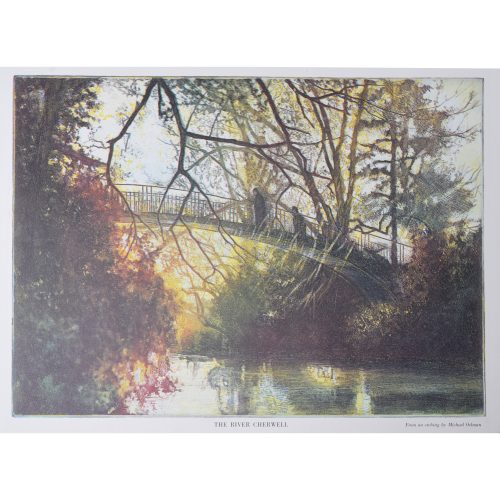
Michael Oelman (born 1941)
The River Cherwell
Lithograph 33 x 46 cm A lithograph of Oxford's wondrous River Cherwell in University Parks, from an etching by Michael Oelman. A setting sun casts its gold light over the glassy surface of the river and its surrounding trees; two figures cross the Cherwell via the famous Rainbow Bridge. The curved footbridge was built in the early 1920s by the University a project for the unemployed. Oelman's etching was reproduced as a lithograph in 1981, to be published in the "Oxford Almanack". The Oxford Almanack was an annual almanac published by the Oxford University Press for the University of Oxford from 1674 through 2019 (when printing sadly ceased due to "dwindling interest"). The almanac traditionally included engravings or lithographs of the University and information about the upcoming year. Other almanac artists have included James Basire, Michael Burghers, J. M. W. Turner, and John Piper. Michael Oelman was born in Llandudno, Wales, in 1941. He studied fine art at Reading University and then etching and lithography at the Central and Slade Schools of Art. In the 1960s he studied with S. W. Hayter in Paris, and then became a lecturer in Printmaking at Doncaster College of Art, Yorkshire. His studio is in Suffolk. Condition: very good. If you’d like to know more, please email info@manningfineart.co.uk or call us on 07929 749056. -
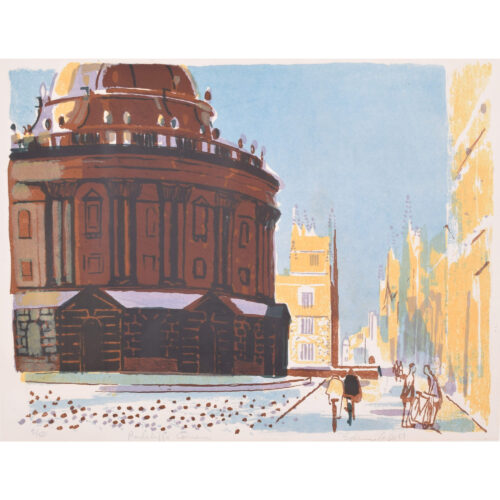
Edwin La Dell (1914-1970)
The Radcliffe Camera, Oxford
Lithograph 41 x 54 cm Numbered 2/50, titled, and signed below in pencil. Radcliffe Square in autumn shades. The Radcliffe Camera dominates the lithograph, and La Dell expertly captures the afternoon sun on the golden stone of Brasenose and the University Church. Students cycle towards the High. La Dell studied at the Sheffield School of Art, where he won a scholarship to the Royal College of Art. From 1934 to 1940 John Nash was the head of printmaking there, and taught La Dell. La Dell himself became head of lithography there in 1948, and remained in post until his death. During the war La Dell was an official war artist and a camofleur, but he is probably best known for his lithographs of Oxford and Cambridge that he published himself. His works are widely held in the public collections, including the Royal Academy and the Government Art Collection, the latter of which holds many of his views of Cambridge. Condition: generally very good. Fractional age-toning to paper; old glue marks to margin which will be under the mount when framed. If you are interested, please email info@manningfineart.co.uk or call us on 07929 749056. Click here for other general views of Oxford. -
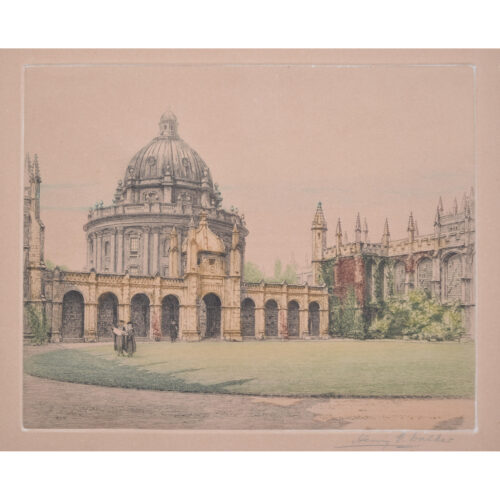
Henry George Walker (1876 - 1932)
The Radcliffe Camera from All Souls College, Oxford
Etching 20 x 25 cm Signed lower right in pencil. The artist depicts the North Quadrangle of All Souls, with the Radcliffe Camera peeking in. Two fellows contemplate a document as a third approaches. Henry Walker was born in Birmingham and specialised in architectural and landscape etchings. Condition: generally very good. If you’d like to know more, please email info@manningfineart.co.uk or call us on 07929 749056. Click here for other views of All Souls. -
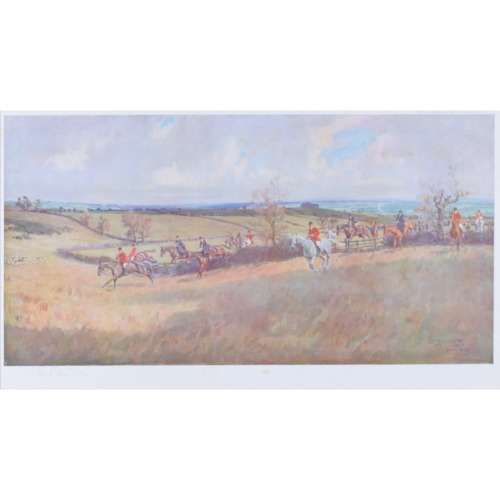
Lionel Edwards (1878 - 1966)
The Quorn Hunt (1934)
Lithograph 34 x 62 cm Signed, titled and dated in plate lower right. Signed in pencil outside plate lower left. A Lionel Edwards lithograph depicting the Quorn - part of the artist's 'Hunting Countries' series. The Quorn Hunt has a claim to be the oldest hunt in the country, being founded in 1696 by Mr Thomas Boothby of Tooley Park, Leicestershire. The hunt takes its name from the village of Quorn, where the hounds were kennelled from 1753 to 1904. Lionel Edwards was a British artist who specialised in pictures of country life, particularly horses, and provided illustrations for Country Life. He is best known for his hunting scenes but also painted pictures of horse racing, shooting and fishing. Condition: print generally good; a couple of very small brown spots. Original 3/4" black frame in generally good condition. If you are interested, please email info@manningfineart.co.uk or call us on 07929 749056. Click here for other hunting pictures. -
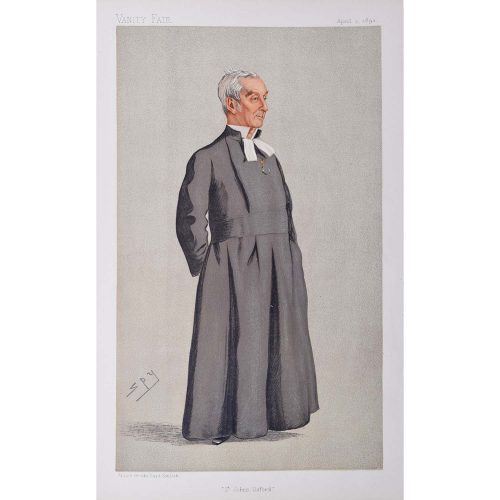
Vanity Fair Spy Magazine President of St john's College Oxford
1 April 1893 Lithograph If you are interested email info@manningfineart.co.uk or call us on 07929 749056. Condition: Good. -
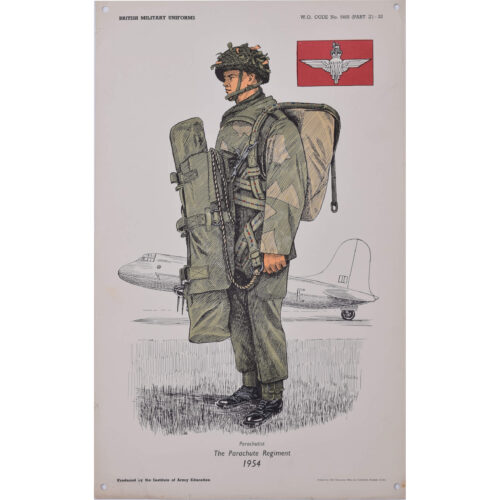
The Parachute Regiment Parachutist 1954 uniform
Lithograph 50 x 31 cm Produced for the Institute of Army Education. Printed for HM Stationery Office by I A Limited, Southall 51. These posters were produced by the Institute of Army Education, likely for display in barracks. Created in the 1950s, they illustrate the 'vintage' uniforms worn by the Corps during the First World War. Condition: punched holes to corners as issued; otherwise generally very good. If you are interested, please email info@manningfineart.co.uk or call us on 07929 749056. Click here for other original vintage Institute of Army Education uniform posters. -
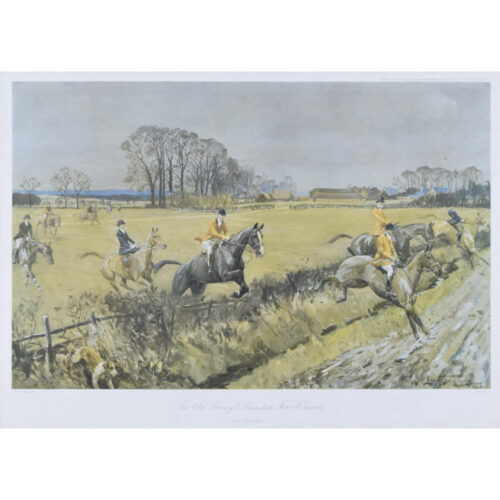
Lionel Edwards (1878 - 1966)
The Old Surrey and Burstow Fox Hounds - at Burstow (1926)
Lithograph 36 x 51 cm Signed and dated in plate lower right. In original 3/4" black frame. A Lionel Edwards lithograph depicting the Old Surrey and Burstow - part of the artist's 'Hunting Countries' series. The Old Surrey and Burstow (now the Old Surrey, Burstow and West Kent Hunt) has been hunting from Felbridge since 1909. The Burstow dates as a foxhound pack from 1866, having previously existed as a harrier pack. Lionel Edwards was a British artist who specialised in pictures of country life, particularly horses, and provided illustrations for Country Life. He is best known for his hunting scenes but also painted pictures of horse racing, shooting and fishing. Condition: print generally good; the odd tiny spot in top right corner. In original 3/4" black frame; some scratches to frame. If you are interested, please email info@manningfineart.co.uk or call us on 07929 749056. Click here for other hunting pictures. -

John Appleyard (1908 - 1960)
The Middleton Hunt at Sherriff Hutton
Watercolour 28 x 37 cm Signed lower right. The Huntsman and hounds of North Yorkshire's Middleton Hunt. Condition: very good. If you’d like to know more, please email info@manningfineart.co.uk or call us on 07929 749056. -
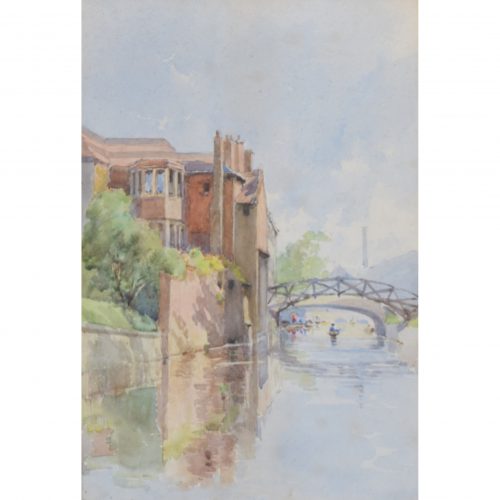
The Mathematical Bridge, Queens' College, Cambridge
Watercolour 27 x 18 cm A delightful watercolour of Cambridge's famous Mathematical Bridge. Figures punt under the bridge and the buildings of Queens are reflected in the serene waters of the River Cam. Kate Hillman of the Cambridge University Engineering Department notes that: "One of the most recognisable structures on the Cam, Queens' College bridge was originally built in 1749 by James Essex the Younger. Since then it has been rebuilt twice to the original design of William Etheridge, once in 1866 and again in 1905. In 1866 the bridge deck was changed from a stepped design to the current sloped deck. In 1905 a complete rebuild of the bridge was required due to weathering of the original oak structure. stories have suggested that a group of students (or professors, depending on the storyteller) disassembled the bridge to discover how it stood up and then couldn't put it back together. The bridge was supposedly then rebuilt using rather prominent bolts." Condition: very good; gilt frame has some age. If you’d like to know more, please email info@manningfineart.co.uk or call us on 07929 749056. -
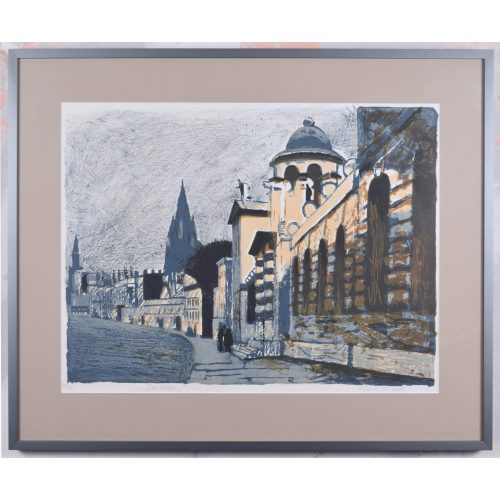
Edwin La Dell (1914-1970)
The High, Oxford
Lithograph 49 x 64 cm Signed, titled, and number 28/80 in pencil. A beautiful depiction of the golden Headington stone of Queen's College on the High Street, Oxford. The cupola above the college's entrance, and, in the background, the shadowy spire of the University Church of St Mary the Virgin, rise into the blustery sky. La Dell studied at the Sheffield School of Art, where he won a scholarship to the Royal College of Art. From 1934 to 1940 John Nash was the head of printmaking there, and taught La Dell. La Dell himself became head of lithography there in 1948, and remained in post until his death. During the war La Dell was an official war artist and a camofleur, but he is probably best known for his lithographs of Oxford and Cambridge that he published himself. His works are widely held in the public collections, including the Royal Academy and the Government Art Collection, the latter of which holds many of his views of Cambridge. Condition: very good. If you are interested, please email info@manningfineart.co.uk or call us on 07929 749056. Click here for other views of Queen's College, Oxford. -

Lionel Edwards (1878 - 1966)
The Hertfordshire Hunt (1927)
Lithograph 36 x 50 cm Signed and dated in plate lower left. A Lionel Edwards lithograph depicting the Hertfordshire - part of the artist's 'Hunting Countries' series. The Hertfordshire Hunt was founded circa 1775 by the Countess of Salisbury, of Hatfield House. Lionel Edwards was a British artist who specialised in pictures of country life, particularly horses, and provided illustrations for Country Life. He is best known for his hunting scenes but also painted pictures of horse racing, shooting and fishing. Condition: print generally good; a couple of tiny scuffs to surface. Modern frame. If you are interested, please email info@manningfineart.co.uk or call us on 07929 749056. Click here for other hunting pictures. -
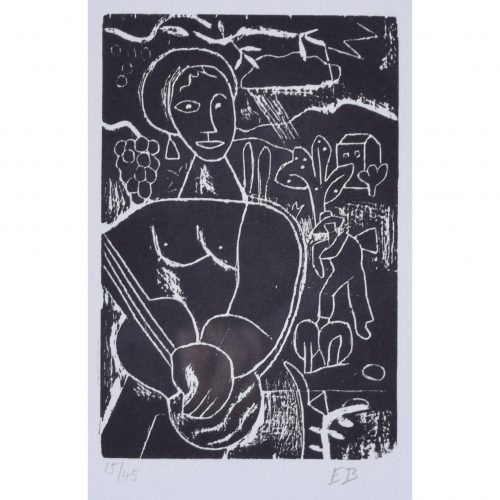
Edward Burra (1905 - 1976)
The Guitar Player
(1928 - 1929, this edition published 1971) Woodcut 15 x 10 cm; sheet size 34 x 24 cm Numbered 15/45 lower left and initialled EB lower right. Burra's woodcut of a female guitar player surrounded by a landscape of cacti. A bunch of grapes is pendent beside her triangular earring, and a male figure in a wide-brimmed hats stands in the field nearby. Edward Burra was an English painter, draughtsman, and printmaker. He travelled to Italy in 1925, the same year he met the noted British Surrealist Paul Nash, and both of these influences are evident in this woodcut. Nash introduced Burra to woodcut-making in 1928, the same year that Burra began this woodcut series. His first solo show was held at the Leicester Galleries in April 1929, and he exhibited with the English Surrealists in the 1930s. Condition: Excellent. If you’d like to know more, please email info@manningfineart.co.uk or call us on 07929 749056. -
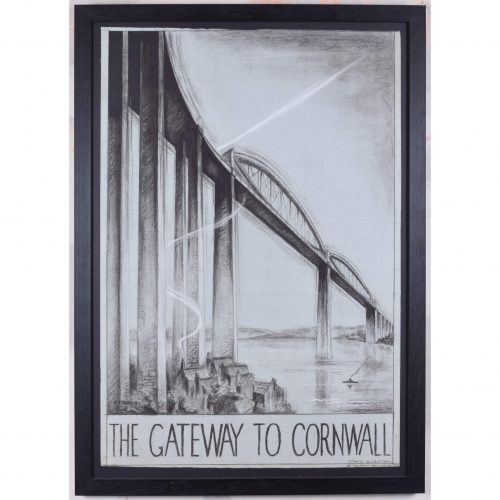
Ronald T Horley (active 1930s - 1940s)
The Gateway to Cornwall
Charcoal heightened with white 76 x 53 cm Signed and inscribed lower right 'Architect's Office, 83 Marlborough Place NW8 Marylebone'. The Great Western Railway commissioned a series of posters promoting train travel around the UK. This charcoal drawing of the Royal Albert Bridge at Saltash is the artist's original design for a poster encouraging rail travel to Devon and Cornwall. The bridge is known fondly as the 'Gateway to Cornwall'. The Royal Albert Bridge was designed by Isambard Kingdom Brunel. Surveying started in 1848 and construction commenced in 1854. The first main span was positioned in 1857 and the completed bridge was opened by Prince Albert on 2 May 1859. Condition: generally very good; a few isolated spots to bottom left corner. Click here for other original vintage travel posters and designs. -
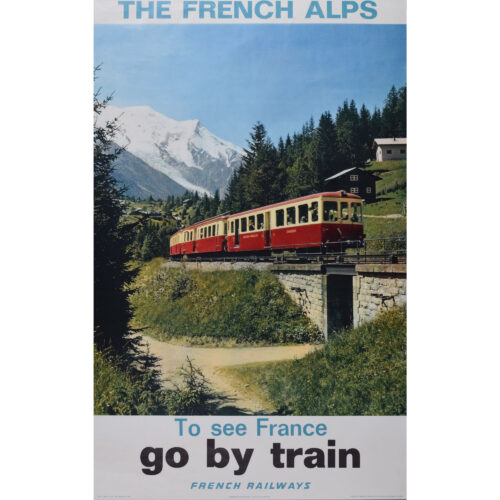
The French Alps - To See France, Go by Train (1966)
Original vintage poster 100 x 66 cm This French Railways poster encourages tourism to the French Alps, where the railway views are (and always have been) particularly charming. Condition: generally very good. If you are interested, please email info@manningfineart.co.uk or call us on 07929 749056. Click here for other original vintage travel posters. -
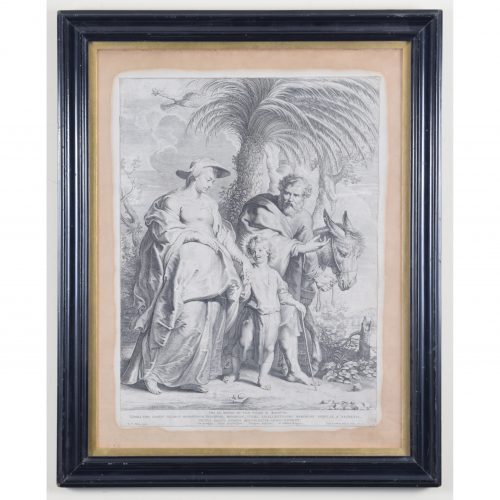
Lucas Vorsterman (1595 - 1675) after Peter Paul Rubens (1577 - 1640)
The Flight into Egypt (1620)
Engraving 30 x 45 cm Rare. We have only been able to trace one copy at auction, 2019, Izegem, Belgium. A copy of this print is held by the British Museum (R,3.50). Mary, Joseph, and the infant Christ escape into Egypt on a donkey. Lucas Vorsterman was a Baroque engraver. He worked with the artists Peter Paul Rubens and Anthony van Dyck, as well as for patrons such as Thomas Howard, 21st Earl of Arundel and Charles I of England. Condition: mounted to old paper; trimmed to platemarks; two areas of repair in region of Mary's left hand and Christ's right knee (see photo). In old ebonised frame. If you are interested, please email info@manningfineart.co.uk or call us on 07929 749056. -
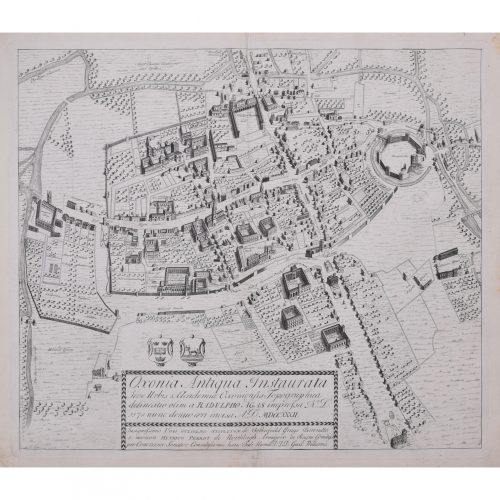
William Williams (Welsh, active 1724 - 1733)
The First Map of Oxford (1733)
Engraving 47 x 54 cm In 1578, Ralph Agas drew the first ever map of Oxford, studded with the first colleges of the University. In 1733 it was engraved by William Williams for publication in the Oxonia Depicta, a book of illustrations depicting similar views as David Loggan's volume of engravings. Ralph Agas was an English surveyor and cartographer. He was born in Suffolk and lived there throughout his life, although he travelled regularly to London. He began to practise as a surveyor in about 1566, and has been described as "one of the leaders of the emerging body of skilled land surveyors". regular work consisted of drawing up local estate maps and surveys for a variety of clients. He was one of the first estate surveyors to move beyond the traditional practice of compiling purely written descriptions of landed property, and to supplementing them with measured maps. Condition: generally very good; a few marks to margins. Central fold as issued. If you’d like to know more, please email info@manningfineart.co.uk or call us on 07929 749056. Click here for other general views of Oxford. -
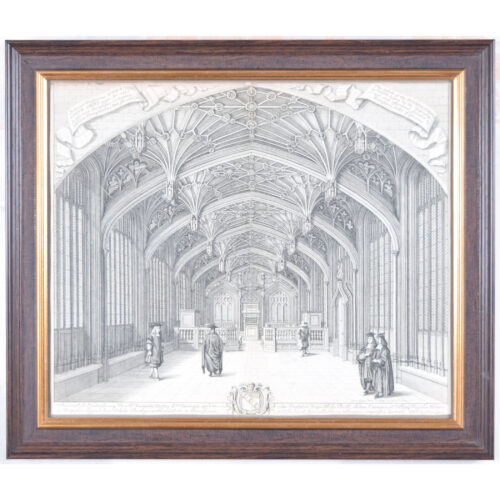
David Loggan (1634 - 1692)
The Divinity School, Oxford (1675)
Engraving 33 x 41 cm David Loggan's view of Oxford's medieval Divinity School, which was once the beating heart of theological studies at the University. Of particular interest here is the trompe l'oeil scroll of torn paper which frames the view. Loggan was born to English and Scottish parents, and was baptised in Danzig in 1634. After studying engraving in Danzig with Willem Hondius (1598-1652 or 1658), he moved to London in the late 1650s, going on to produce the engraved title-page for the folio 1662 Book of Common Prayer. He married in 1663 and moved to Nuffield in Oxfordshire in 1665. Loggan was appointed Public Sculptor to the nearby University of Oxford in the late 1660s, having been commissioned to produce bird’s-eye views of all the Oxford colleges. He lived in Holywell Street as he did this. The 'Oxonia Illustrata' was published in 1675, with the help of Robert White (1645-1704). Following its completion, Loggan began work on his equivalent work for Cambridge; the 'Cantabrigia Illustrata' was finally published in 1690, when he was made engraver to Cambridge University. The 'Oxonia Illustrata' also includes an engraving of Winchester College (Winchester and New College share William of Wykeham as their founder) whilst the 'Cantabrigia Illustrata' includes one of Eton College (which shares its founder, Henry VIII, with King’s College). Bird’s-eye views from this era required a particular talent as an architectural perspectivist; it was not until 1783 that it became possible for artists to ascend via hot air balloons and view the scenes they were depicting from above. Loggan thus had to rely on his imagination in conceiving the views. Loggan’s views constitute the first accurate depictions of the two Universities, in many ways unchanged today. Whilst the Oxford engravings were produced in reasonable numbers and ran to a second edition by Henry Overton (on thicker paper and with a plate number in Roman numerals in the bottom right-hand corner), those of Cambridge were printed in much smaller numbers. The Dutchman Pieter van der Aa published some miniature versions of the engravings for James Beverell’s guidebook to the UK, 'Les Delices de la Grande Bretagne' (circa 1708). The contemporary artist Andrew Ingamells (born 1956) has produced a highly-acclaimed series of etchings which bring Loggan’s original vision up to date. Condition: trimmed within platemark and mounted to board, otherwise in very good condition. If you are interested, please email info@manningfineart.co.uk or call us on 07929 749056. Click here for other general views of Oxford. -
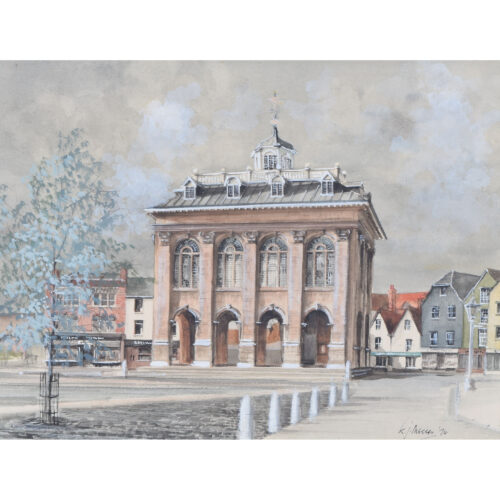
Ken Messer (1931 - 2018)
The County Hall, Abingdon (1974)
Watercolour 24 x 32 cm Signed and dated lower right. The painter and draughtsman Ken Messer is closely related to Oxford and its architecture in several ways. Born in Newport, South Wales, he was educated at the City of Oxford High School for Boys in Oxford, and then spent six years working as an accountant in Oxford. He then joined British Overseas Airways Corporation (BOAC) as a steward, flying internationally. Injury due to a car accident during the 1960s meant that he joined the design department of Pergamon Press in Oxford at the age of 33. Six years later, he was appointed to the position of studio manager, in charge of art and design. In 1974, Messer left Pergamon Press to become a freelance graphic designer. He started painting more watercolours, becoming a full-time artist. During the 1980s, his ink drawings were regularly published in the Oxford Times. He has sometimes been called "The Oxford Artist" because of his large number of works depicting Oxford. He and his wife Dilys lived at first in Richmond upon Thames and then in Abingdon, just south of Oxford. Messer's work has been shown at the Mall Galleries for the annual exhibitions of the Royal Institute of Painters in Water Colours annual exhibitions. Condition: very good. If you are interested, please email info@manningfineart.co.uk or call us on 07929 749056. -
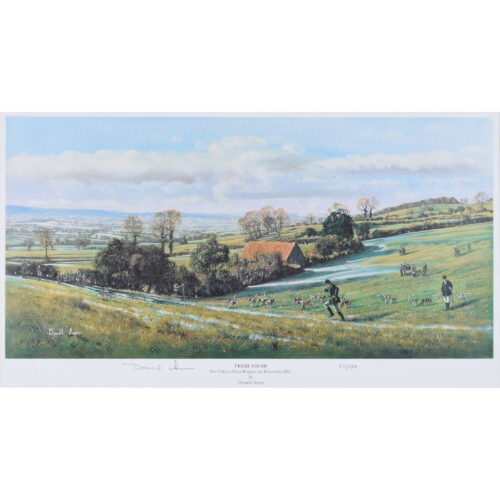
Donald Ayres (b. 1936)
The Clifton Foot Beagles on Butcombe Hill
Lithograph 24 x 44 cm Signed and numbered 423/500. A lithograph of the Clifton Foot Beagles, now the Chilmark and Clifton Foot Beagles. Donald Ayres is a landscape painter specialising in country sports such as hunting, shooting, and fishing. His work has been exhibited in most of the major commercial galleries in Britain, as well as many in Europe and America. Condition: very good. If you are interested, please email info@manningfineart.co.uk or call us on 07929 749056. Click here for other hunting pictures. -

J Black (early 19th century) after Frederick Mackenzie (1788 - 1854)
The Choir, Westminster Abbey (1812)
Hand-coloured aquatint 28 x 19 cm Published by Rudolph Ackermann (1764 - 1834). An engraving of the vast and soaring interior of Westminster Abbey. Mackenzie's drawing was engraved by Black and published by Ackermann in his 1812 "History of Westminster Abbey". The Abbey is an historic, mainly Gothic church in the City of Westminster, London, just to the west of the Palace of Westminster. It is one of the United Kingdom's most notable religious buildings and since Edward the Confessor, a burial site for English and, later, British monarchs. Since the coronation of William the Conqueror in 1066, all coronations of English and British monarchs have occurred in Westminster Abbey. Sixteen royal weddings have occurred at the abbey since 1100. According to a tradition first reported circa 1080, a church was founded at the site (then known as Thorney Island) in the seventh century, in the time of Mellitus, Bishop of London. Construction of the present church began in 1245 on the orders of Henry III. Frederick Mackenzie (1788 - 1854) was a British watercolourist and architectural draughtsman. He first exhibited at the Royal Academy in 1804, and contributed eleven drawings between that year and 1828. He contributed to the Society of Painters in Water Colours exhibitions from 1813, becoming an associate in 1822, and a full member the following year. From 30 November 1831 till his death he was treasurer to the society. In later life Mackenzie was no longer commissioned to illustrate books. Rudolph Ackermann was an Anglo-German bookseller, inventor, lithographer, publisher and businessman. In 1795 he established a print-shop and drawing-school at 96 Strand. Here Ackermann set up a lithographic press and began a trade in prints. He later began to manufacture colours and thick carton paper for landscape and miniature painters. Within three years the premises had become too small and he moved to 101 Strand, in his own words "four doors nearer to Somerset House", the seat of the Royal Academy of Arts. Between 1797 and 1800 Ackermann rapidly developed his print and book publishing business, encompassing many different genres including topography, caricature, portraits, transparencies and decorative prints. Condition: good. Some age toning. If you’d like to know more, please email info@manningfineart.co.uk or call us on 07929 749056. -

Colin Moss (1914 - 2005)
The Cedars, Kensington
Watercolour and gouache 57 x 40 cm Signed and dated '50 lower right. Moss' view of the Cedars, complete with passers-by and a stormy, jagged sky. Colin Moss was a noted British painter, draughtsman, printmaker, and teacher who served as a camoufleur during the Second World War. Moss was born in Ipswich but grew up in Plymouth following the death of his father at the Battle of Passchendaele in 1917. Moss studied at the Plymouth Art School from 1930 to 1934 and then went on to the Royal College of Art, where he studied under Gilbert Spencer and Charles Mahoney. He worked on murals for the British Pavilion at the 1939 New York World's Fair. During the war, Moss made a series of watercolours depicting his time as a camoufleur. He had designed the camouflage scheme for Stonebridge Power Station in Wembley, and produced several watercolours of the camouflaged structure. These pictures, as well as several others painted during his WWII deployment, are now held by the Imperial War Museum, having been purchased by the War Artists' Advisory Committee. In 1947 Moss' military service ended, and he became a teacher at the Ipswich School of Art. He had solo exhibitions at the Kensington Art Gallery in 1951 and the Zwemmer Gallery in 1955, and his work began to be acquired by the national collections. He became a founder member of the New Ipswich Art Group in 1958, and the Six in Suffolk Group in 1976. In the 1970s he exhibited at the Royal Academy and the Royal Watercolour Society, and retrospective exhibitions of his work were held at various British art galleries throughout the 1980s. He continued to hold numerous solo exhibitions after his retirement, and taught artists Brian Eno and Maggi Hambling. Provenance: "Britain in Watercolours" exhibition. Condition: excellent. If you’d like to know more, please email info@manningfineart.co.uk or call us on 07929 749056. -
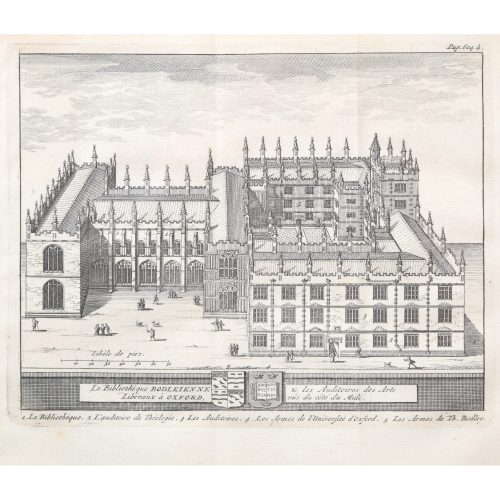
Pieter van der Aa (1659-1733), after David Loggan (1634–1692)
The Bodleian Library, Oxford (1727)
Engraving 12 x 16 cm An eighteenth-century view of the beautiful Bodleian Library, engraved by Pieter van der Aa after David Loggan, the noted engraver, draughtsman, and painter. Pieter van der Aa of Leiden was a Dutch publisher best known for preparing maps and atlases, though he also printed editions of foreign bestsellers and illustrated volumes. He is noted for the many engravings he produced after David Loggan's series of Oxford and Cambridge colleges and costumes. In 1727 Van Der Aa illustrated "Les Delices de la Grande Bretagne & de L'Irelande" by James Beeverell, the book in which this engraving appears. Condition: a good impression. If you’d like to know more, please email info@manningfineart.co.uk or call us on 07929 749056. -
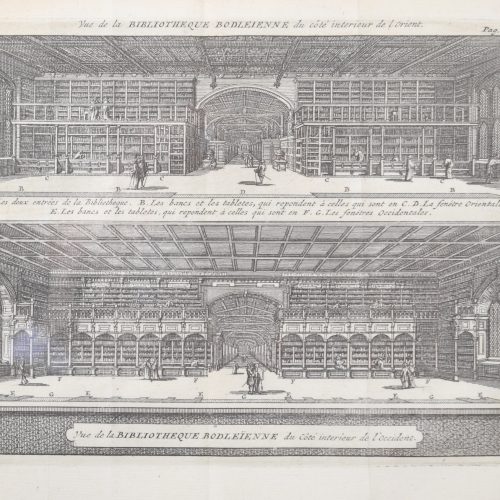
Pieter van der Aa (1659-1733), after David Loggan (1634–1692)
The Bodleian Library, University of Oxford
Engraving (1727) 12 x 16 cm An eighteenth-century view of the interior of the Bodleian Library, engraved by Pieter van der Aa after David Loggan, the noted engraver, draughtsman, and painter. Pieter van der Aa of Leiden was a Dutch publisher best known for preparing maps and atlases, though he also printed editions of foreign bestsellers and illustrated volumes. He is noted for the many engravings he produced after David Loggan's series of Oxford and Cambridge colleges and costumes. In 1727 Van Der Aa illustrated "Les Delices de la Grande Bretagne & de L'Irelande" by James Beeverell, the book in which this engraving appears. Condition: a good impression. If you are interested, please email info@manningfineart.co.uk or call us on 07929 749056. -
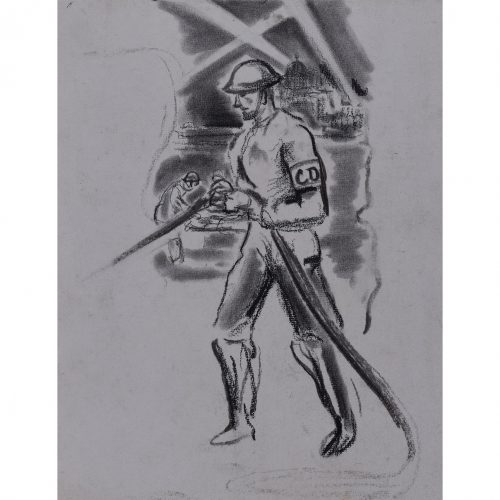
The Blitz: A Civil Defence Firefighter In Action before St Paul's Cathedral with Search Lights and Stretcher Bearers
Charcoal c. 1940 30x24cm A World War II Civil Defence firefighter, with 'CD' armband operates a fire hose as stretcher bearers work behind him, St Paul's cathedral being illuminated by searchlights. A typical night-time scene from London during the 1940 Blitz. If you are interested email info@manningfineart.co.uk or call us on 07929 749056. -
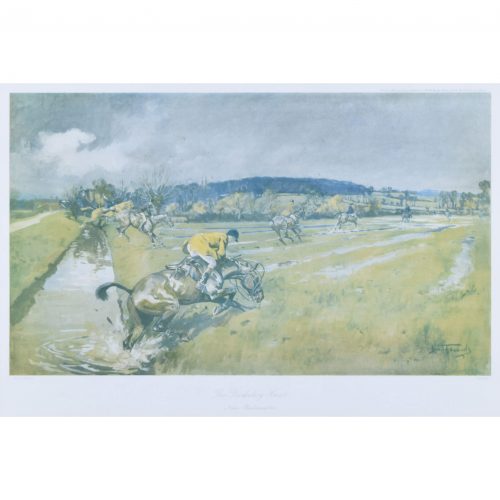
Lionel Edwards (1878 - 1966)
The Berkeley Hunt - Near Rockhampton (1925)
Lithograph 34 x 51 cm Signed in plate lower right. In original 3/4" black frame. A Lionel Edwards lithograph depicting the Berkeley - part of the artist's 1925 'Hunting Countries' series. The yellow coats with green collars and the running fox on the lapel are worn by the Masters and Hunt Staff and are unique in hunting circles, representing the outdoor livery of the Berkeley family; the ladies' colours of navy and maroon represent the indoor livery. The Berkeley is the oldest pack in the country and is one of the very few that are still family owned. The Fifth Earl of Berkeley could hunt his hounds from Berkeley Castle to Berkeley Square in London and had six kennels along the route. The season would start in Berkeley and progress to each of his kennels to London and then in stages back again to Gloucestershire. The present kennels date from the early 18th century and are home to around 90 hounds. Lionel Edwards was a British artist who specialised in pictures of country life, particularly horses, and provided illustrations for Country Life. He is best known for his hunting scenes but also painted pictures of horse racing, shooting and fishing. Condition: print generally good; the odd tiny spot in top left area. In original 3/4" black frame - some scratches to frame. If you are interested, please email info@manningfineart.co.uk or call us on 07929 749056. Click here for other hunting pictures. -
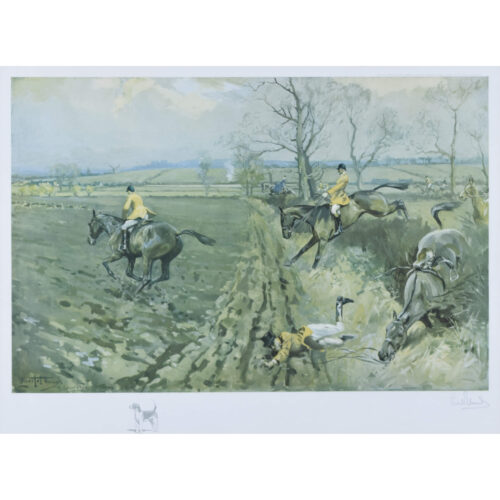
Lionel Edwards (1878 - 1966)
The Belvoir Hunt (1928)
Lithograph 31 x 51 cm Signed and dated in plate lower left, and in pencil outside plate lower left. A Lionel Edwards lithograph depicting the Belvoir - part of the artist's 'Hunting Countries' series. The Belvoir Hunt, sometimes known as the Duke of Rutland's Hounds, dates from 1750 and became a foxhound pack in 1762. Since then, the kennels have been located at Belvoir Castle. Lionel Edwards was a British artist who specialised in pictures of country life, particularly horses, and provided illustrations for Country Life. He is best known for his hunting scenes but also painted pictures of horse racing, shooting and fishing. Condition: print good; original handsome period frame; small area of loss to top of frame. If you are interested, please email info@manningfineart.co.uk or call us on 07929 749056. Click here for other hunting pictures. -
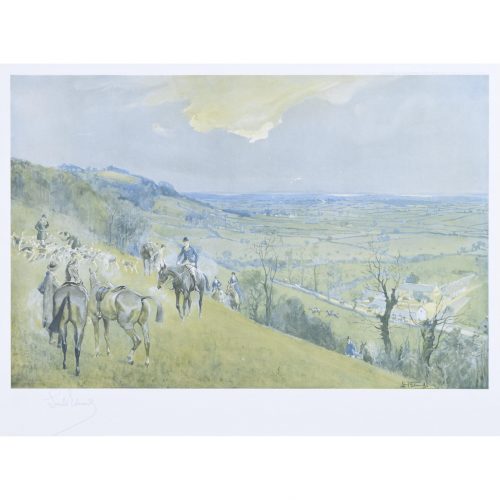
Lionel Edwards (1878 - 1966)
The Beaufort Hunt. Kill Above Sodbury Vale. (1925)
Lithograph 38 x 52 cm Signed in plate lower right and in pencil lower left outside the plate. Printed and Published by Eyre and Spottiswoode. A Lionel Edwards lithograph depicting the Beaufort - part of the artist's 1925 'Hunting Countries' series. The Beaufort's hunt dress is peculiar to the country in that the Huntsman and Whippers-In wear green and the subscribers a blue coat with buff facings. The earliest records of hounds being kennelled at Badminton date back to 1640 when the then Marquis of Worcester hunted mainly deer, but hare and fox as well. Dukes of Beaufort have either hunted hounds themselves or have been in the Mastership since the title was created in 1682 and the hounds, kennels and stables still belong to them. The 10th Duke was master from 1924 to 1984 and so great was his contribution to foxhunting he became universally known as "Master". The Beaufort is one of the few remaining private packs. Lionel Edwards was a British artist who specialised in pictures of country life, particularly horses, and provided illustrations for Country Life. He is best known for his hunting scenes but also painted pictures of horse racing, shooting and fishing. Condition: generally very good; some fading to the clouds. If you are interested, please email info@manningfineart.co.uk or call us on 07929 749056. Click here for other hunting pictures. -
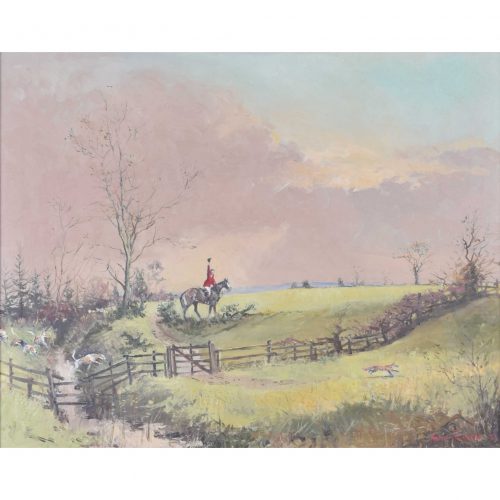
Robin Furness (born 1933)
The Three O'Clock Fox - Dobinson's Covert (1972)
Oil on canvas 40 x 50 cm Signed lower right. A delightful oil painting of the Raby Hunt at Bedburn by Robin Furness, former MFH of the Bedale Hunt and noted painter of hunting scenes. Condition: very good. If you’d like to know more, please email info@manningfineart.co.uk or call us on 07929 749056. -

Terry Frost (1915-2003)
Autumnal Landscape in Red, Black and Yellow
Watercolour 40 x 58 cm Signed and dated 1958 Framed in hand-finished grey 'Nicholson' butt-jointed frame. Click here for biographical details and other works by the artist. If you are interested email info@manningfineart.co.uk or call us on 07929 749056. In 1954 Frost moved to Leeds to become Gregory Fellow at the University. This began a period when he painted yellow and black and white paintings, inspired by the Yorkshire landscape. In 1958 he joined the London group and then moved to St Ives. This painting dates to this era. -
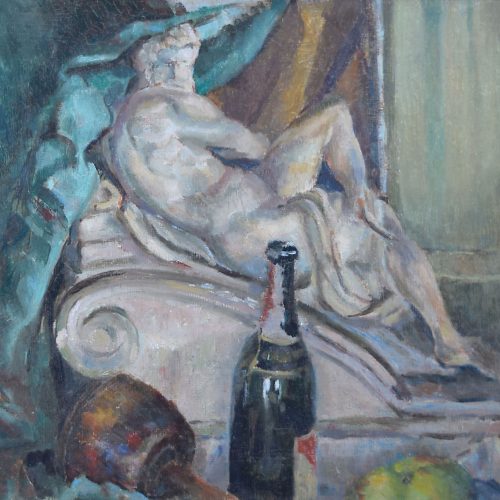 Sir Terry Frost (1915-2003) Bottle and Statue Oil on board c. 1947 38 x 46cm A distinctive still life featuring bottle, statue, and drapery. Terry Frost was a prominent British abstract artist. Frost is most noted for his simplistic abstract forms and unusual colour; he worked alongside the St Ives group and as Barbara Hepworth's assistant for several years, his artistic style being heavily influenced by them. In 1992 he became a Royal Academician, and he was made Sir Terry Frost in 1998. Bottle and Statue highlights Frost's unique compositional skill. His brushwork makes the statue seem like a real nude, who, framed by turquoise and ochre draperies, examines the still life in the foreground. An early work, painted shortly after the War and prior to his adoption of abstraction. For other works by Frost and biographical details please click here. Condition: A little craquelure in the oil above the statue's head.
Sir Terry Frost (1915-2003) Bottle and Statue Oil on board c. 1947 38 x 46cm A distinctive still life featuring bottle, statue, and drapery. Terry Frost was a prominent British abstract artist. Frost is most noted for his simplistic abstract forms and unusual colour; he worked alongside the St Ives group and as Barbara Hepworth's assistant for several years, his artistic style being heavily influenced by them. In 1992 he became a Royal Academician, and he was made Sir Terry Frost in 1998. Bottle and Statue highlights Frost's unique compositional skill. His brushwork makes the statue seem like a real nude, who, framed by turquoise and ochre draperies, examines the still life in the foreground. An early work, painted shortly after the War and prior to his adoption of abstraction. For other works by Frost and biographical details please click here. Condition: A little craquelure in the oil above the statue's head. -

Anonymous
Man of the World: in a modern force the territorial army for adventure plus technical training
Lithographic poster c. 1960 75.5x51cm If you are interested email info@manningfineart.co.uk or call us on 07929 749056. -
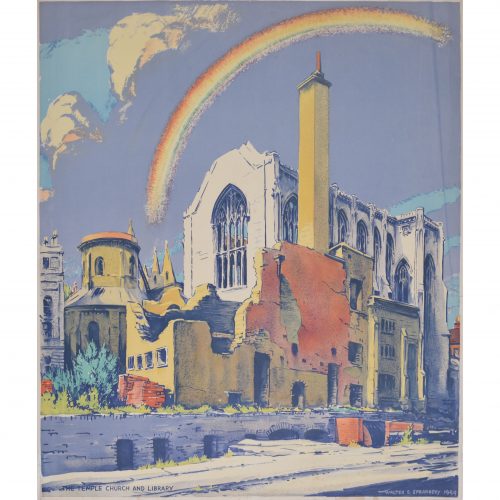
Walter Ernest Spradbery (1889 - 1969)
Temple Church and Library after Bombardment (1944)
Lithograph 66 x 57 cm Walter Spradbery's poster for the London Underground depicting a bombed Temple Church; a rainbow strikes hopefully out of the church's remains, and the sun shines on the golden stone of the building. The full poster bears the legend 'The Proud City' above Spradbery's design, and, beneath it, a quote from Charles Lamb: 'So may the winged horse, your ancient badge and cognisance, still flourish!'. This is a fantastic piece of British and London history, as well as a fantastically designed poster by a notable 20th century artist. The London Transport Museum has a copy of the poster, reference 1983/4/5751. 'The Proud City' was a series of six posters, all designed by Spradbery. They were commissioned by London Transport in 1944 as a defiant celebration of London's surviving the Blitz, and each poster also included a literary quotation. Walter Ernest Spradbery was a designer, painter, and poet who lived through the First and Second World Wars. He produced posters for LNER, Southern Railways, and London Transport, and was noted for his fascination with architecture and landscape. He studied, and later taught, at the Walthamstow School of Art. He was a pacifist and campaigned for nuclear disarmament, serving in the Medical Corps during the First World War and painting scenes of warfare for its duration, as well as during the Second World War. His anti-war stance and the horrors he had witnessed as a medic fed into his post-war poster design, especially 'The Proud City' poster series. Condition: generally very good. If you’d like to know more, please email info@manningfineart.co.uk or call us on 07929 749056. -
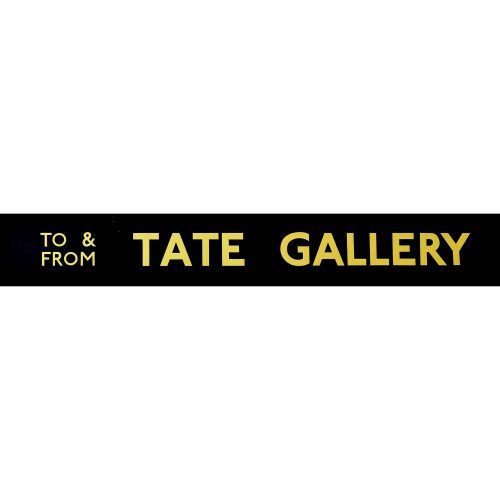
Anon.
Tate Gallery Routemaster
Slipboard Poster c.1970 Screenprint poster 64x9cm In a black hand-finished frame. Printed for London Transport for use on Routemaster or RT busses. If you are interested email info@manningfineart.co.uk or call us on 07929 749056. Condition: Excellent. -
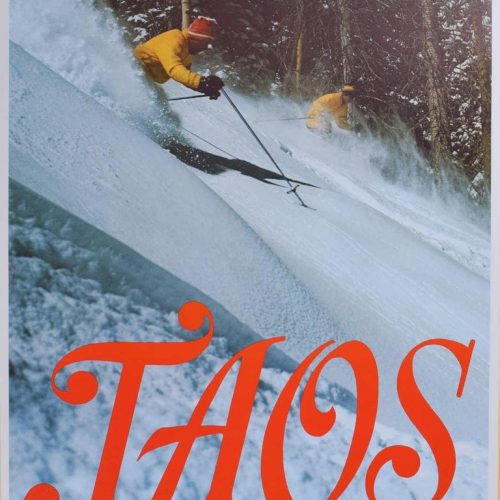
Taos New Mexico USA Vintage Ski Poster 1974 Victor Frohlich and Tom Carrera
67 x 53 cm Poster Printed by LooArt Press, Colorado Springs, Colorado Direct from the surplus stock of the printers, LooArt Press, which closed in the early 1970s. This features Victor Frohlich in the foreground, who had been at Taos Ski Valley since the start, with Tom Carrera in behind him. This is on the Snakedance fun in 1974. Taos Ski Valley was founded in 1955 by Ernie and Rhonda Blake who lived in an eleven foot camper van prior to the construction of the Hondo Lodge - now the Inn at Snakedance (where they lived without power until 1963!) In 1956 Ernie - together with sixteen men from Taos Puelbo and a mule named Lightning - installed the first lift, the Bridger-Boseman J-Bar, serving the current Snakedance run which at the time was the mountain's only run. Condition: From the printer's surplus stock, in generally excellent condition. -
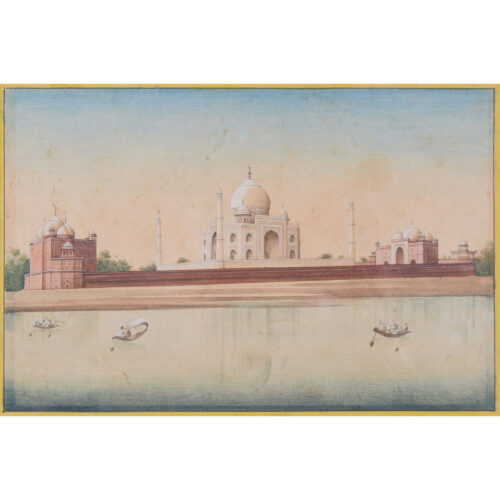
Taj Mahal, India
Watercolour 13 x 20 cmA 20th century watercolour by an unknown artist of the Taj Mahal, Shah Jahan's 1631 mausoleum for his wife. We have three other Indian architectural views by the same artist available.Condition: generally very good; one or two small scratches as visible in photographs. If you are interested, please email info@manningfineart.co.uk or call us on 07929 749056. Click here for other works from the same series. -
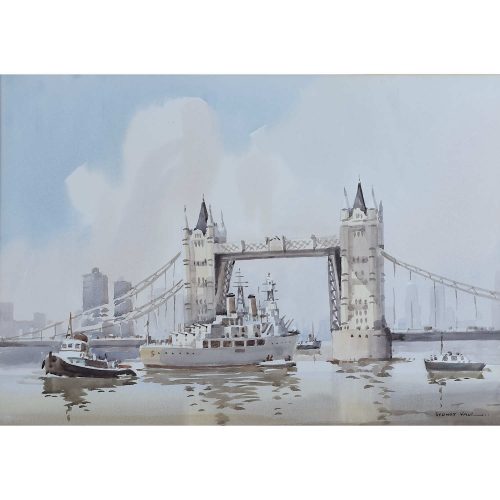
Sydney Vale F. R. S. A. (1916 - 1991)
A warship passing under Tower Bridge
Watercolour 35 x 50 cm Born in 1916, Sydney Vale was a Fellow of the Royal Society of Arts and a member of the prestigious Wapping Group of Artists from 1972 to 1991, which was formed primarily to record life in London's Docklands. Within this group, Vale and his contemporaries specialised in portraying the charm and romance of the River Thames from source to estuary. -
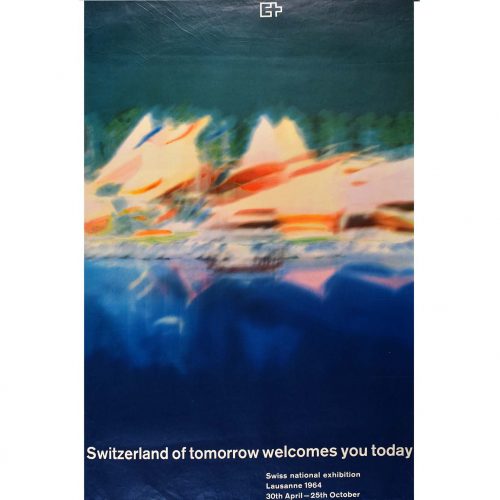
Switzerland of Tomorrow Welcomes You Today (1964)
Lithographic poster 152.4cm x 63.5 cm 1964 Original "Switzerland of Tomorrow" poster from the 1964 Swiss National Exhibition. As well as a brilliantly-designed futuristic poster printed in rich colours, it is a real piece of Swiss (and European) history. The poster is the English-language edition of a tourism-encouraging poster produced in several languages to welcome international visitors to an exhibition of Swiss innovation. Switzerland holds such an event four times per century, and the exhibitions often act as a portrait of contemporary culture, design, and politics. The 1964 National Exhibition in Lausanne offered a rather different representation of Switzerland from previous exhibitions. This was partly the result of its being held during one of the tensest periods of the Cold War; the attitudes of the Swiss were changing as the twentieth century progressed, as was the case for most Europeans, and the shadow of war had encouraged many citizens, businesses, and public bodies to reexamine their values. At "Expo 64", the nickname for that year's exhibition, the 'Gulliver Project' was introduced. The exhibition organisers made use of the character Gulliver (from Swift's 'Gulliver's Travels' to assess visitors' attitudes to daily life. A small questionnaire written by "Gulliver" was given to visitors, asking them questions about their societal attitudes, domestic lives, and work ethics, such as "Can you be a good Swiss and get up at 9am?". The theatre director Charles Apothéloz suggested having Gulliver ask these questions so as to make the questionnaire seem less serious, and to encourage people to answer truthfully. The questionnaire answers were compiled and analysed, but never published, as had been Apothéloz's initial intention. Charles Ascher discusses this at length in his 1965 article 'Gulliver in the Land of the Swiss'. If you are interested, please email info@manningfineart.co.uk or call us on 07929 749056. Condition: Good, pinholes to corners with some soft creases along bottom inch (would be hidden by mount). -
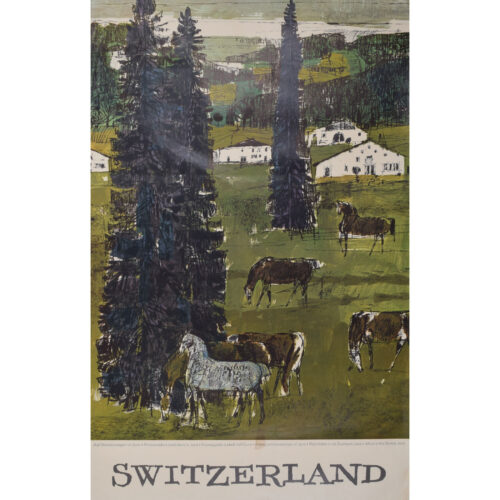
Hugo Wetli (1916 - 1972)
Switzerland - Afoot in the Swiss Jura
Original vintage poster 100 x 64 cm Hugo Wetli trained as a technical draughtsman and then became apprenticed to a private graphic studio. He worked in Geneva and Berne as a painter and draughtsman, also producing book illustrations and travel poster designs. In 1947 he studied at the Académie de la Grande Chaumière in Paris and then ran his own graphic design studio. Condition: generally very good; old tape stain under 'Paseo' approx 2 cm sq and extending almost invisibly into image; a few pin holes to corners; a little soft creasing. If you are interested, please email info@manningfineart.co.uk or call us on 07929 749056. Click here for other original vintage travel posters. -
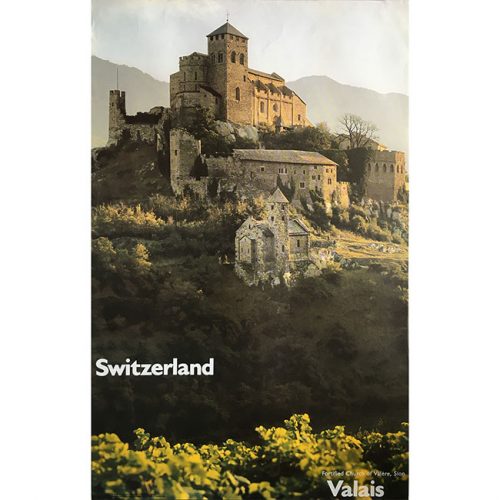 Anonymous Switzerland (Valais, Church of Rarogne) Photo:Giegel/SNTO Photolithographic poster 102x64cm If you are interested email info@manningfineart.co.uk or call us on 07929 749056.
Anonymous Switzerland (Valais, Church of Rarogne) Photo:Giegel/SNTO Photolithographic poster 102x64cm If you are interested email info@manningfineart.co.uk or call us on 07929 749056. -
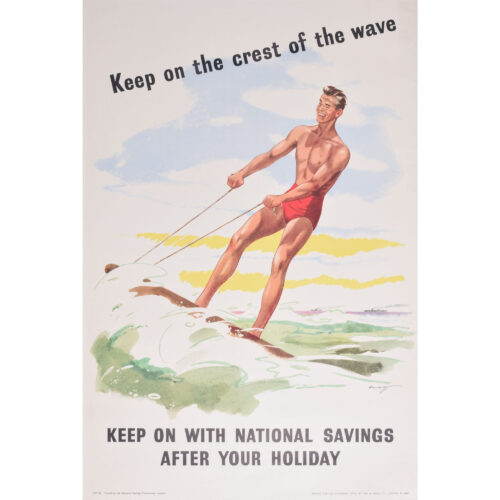
Keep on the Crest of the Wave
Original vintage poster 76 x 51 cm Issued by the National Savings Committee, London. Printed for HM Stationery Office by Fosh & Cross Ltd. An original vintage WW2 poster encouraging Britons to save via the National Savings scheme - like the cheery and composed surfer, we must keep saving to stay on the crest of the wave. Condition: generally very good; slight wear to right-hand margin. Not backed. If you are interested, please email info@manningfineart.co.uk or call us on 07929 749056. Click here for other original vintage National Savings posters. -
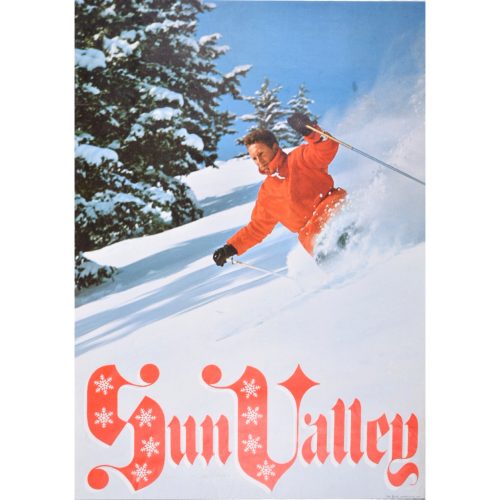
Sun Valley
Original lithographic poster c. 1965 76x51cm Published by LooArt Press, Colorado The resort was the first destination winter resort in the US and was developed by W A Harriman, the chairman of the Union Pacific Railroad to increase passenger numbers. The Austrian Count Schaffgotsch was instructed to find a suitable site and Sun Valley was born. Sun Valley was the site of the world's first chairlifts as single-seat chairs were installed in 1936 for the opening. The poster is believed to depict Sigfried 'Sigi' Engl, an Austrian who became director of Sun Valley Ski School in 1952 and made it famous for his innovative instructional methods. A few light creases and small spot towards top right. -
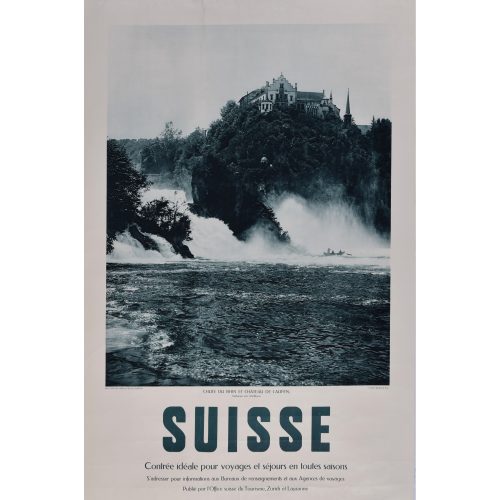
Suisse Chutes du Rhin
Original lithographic poster (1925) 40x25" If you are interested email info@manningfineart.co.uk or call us on 07929 749056. Condition: Generally good, a little edge wear. -
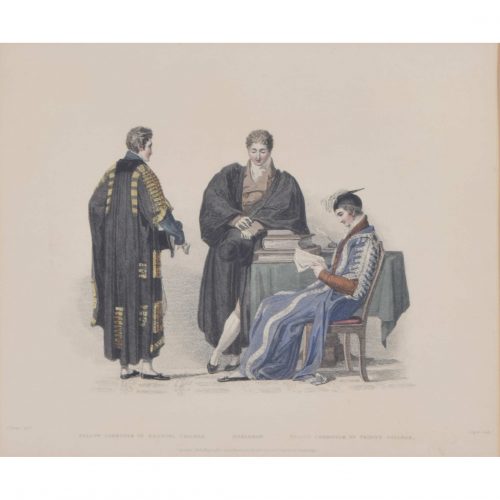
John Samuel Agar (1773 - 1858) after John Uwins (1782 - 1857)
Fellow Commoner of Emanuel College; a Nobleman; Fellow Commoner of Trinity College (1815)
Hand-coloured aquatint 25 x 29.5 cm Published by Rudolph Ackermann (1764 - 1834). An engraving of two students and a nobleman from Ackermann's ''A History of the University of Cambridge, Its Colleges, Halls and Public Buildings''. The three figures dwell over a pile of books and papers, clad in the appropriate academic dress. Thomas Uwins RA RWS was a British painter in watercolour and oil, and a book illustrator. He became a full member of the Old Watercolour Society and a Royal Academician, and held a number of high-profile art appointments including the librarian of the Royal Academy, Surveyor of Pictures to Queen Victoria and the Keeper of the National Gallery. In the late 1790s he began producing work for Ackermann''s collections. John Samuel Agar was an English portrait painter and engraver, who exhibited his works at the Royal Academy from 1796 to 1806 and at the British Institution until 1811. He was at one time president of the Society of Engravers. Rudolph Ackermann published many of his engravings. Rudolph Ackermann was an Anglo-German bookseller, inventor, lithographer, publisher and businessman. In 1795 he established a print-shop and drawing-school at 96 Strand. Here Ackermann set up a lithographic press and began a trade in prints. He later began to manufacture colours and thick carton paper for landscape and miniature painters. Within three years the premises had become too small and he moved to 101 Strand, in his own words "four doors nearer to Somerset House", the seat of the Royal Academy of Arts. Between 1797 and 1800 Ackermann rapidly developed his print and book publishing business, encompassing many different genres including topography, caricature, portraits, transparencies and decorative prints. Condition: good. Some age toning. If you’d like to know more, please email info@manningfineart.co.uk or call us on 07929 749056. -
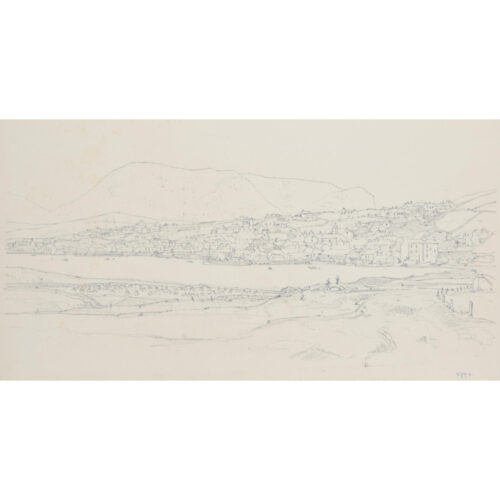
Claude Muncaster (1903 - 1974)
Stromness, Orkney
Pencil drawing 23 x 53 cm A drawing of Stromness, Orkney, with two figures in the foreground. The buildings seem tiny in comparison to the huge cliffs overlooking the town. Claude Grahame Muncaster, RWS ROI RBA SMA was the son of Oliver Hall RA. He was born Grahame Hall (his father was the Royal Academician Oliver Hall, who taught his son to paint from an early age) but adopted the name Claude Muncaster in 1922, hoping to strike out on his own and dissociate his career from that of his father. His career as a landscape painter began when he was fifteen; he spent the 1920s and 30s travelling the world with his sketchbook by boat. Muncaster’s primary choice of subject matter came from a genuine love of the sea. He made several long-distance sea voyages, including one around the Horn as a deckhand in the windjammer Olivebank in 1931, which he described in ‘Rolling Round the Horn’, published in 1933. Armed with a sketchbook, his aim was to be able to ‘paint ships and the sea with greater authority’. This he certainly achieved, perfectly capturing the limpid first light of morning over the Port of Aden, the choppy rain-grey waters of the Bay of Biscay and a streak of sunlight through gathering storm clouds at dusk in Exeter. He became an Associate of the Royal Watercolour Society in 1931 and was a founder member, and later President, of the Royal Society of Marine Artists. When the Second World War broke out, Muncaster joined the Royal Naval Reserves, training as a navigator before going on to advise on the camouflage of ships. He also worked as an official war artist. In ‘Still Morning at Aden’ (1944) he depicts Allied warships in this safe anchorage in the Middle East; the back is stamped with Admiralty approval. In 1946-7 he was commissioned by the Queen to produce watercolours of the royal residences (some of which are available below); the Duke of Edinburgh, in a foreword to a biography of Muncaster, recalls looking at these and considering the artist’s ‘unerring instinct for a subject’, his sense of atmosphere. Other commissions included large panoramas of the Thames and of Bradford. His career also included work as an etcher, illustrator, writer, lecturer and broadcaster, and his paintings can be found in the Royal Academy, Tate, National Maritime Museum Cornwall, National Railway Museum and Royal Air Force Museum. He was a frequent guest at Sandringham for the rest of his life. If you are interested, please email info@manningfineart.co.uk or call us on 07929 749056. Click here for other works by the artist. -
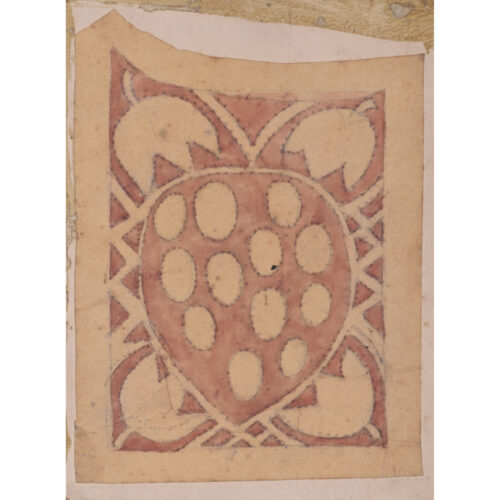
Reginald Hallward (1858 - 1948)
Design for a banner in the shape of a strawberry
Watercolour 14 x 10 cm A design for a banner featuring a strawberry motif. The design, like many others by Hallward, is likely influenced by in the Arts and Crafts style popularised by William Morris in the 1890s. Reginald Hallward was born on the Isle of Wight, and was a painter, poet, glassmaker and book designer. He is best known for his stained glass window designs and the tempera murals he painted in several churches. A great exponent of the English Arts and Crafts movement, he often used black paint for outlines, rather than leaded glass. A consumate craftsman, he insisted on painting, firing and leading with his own hands. Condition: mounted to board, old glue marks to margins, and some loss of colour; otherwise good. If you are interested, please email info@manningfineart.co.uk or call us on 07929 749056. Click here for other pictures by Reginald Hallward. -
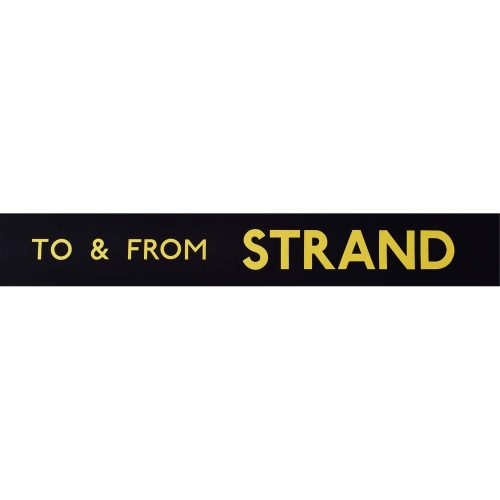
Anon.
Strand Routemaster
Slipboard Poster c.1970 Screenprint poster 64x9cm In a black hand-finished frame. Printed for London Transport for use on Routemaster or RT busses. If you are interested email info@manningfineart.co.uk or call us on 07929 749056. Condition: Excellent. -
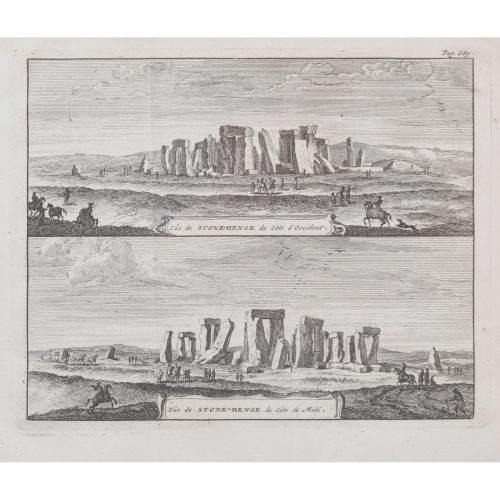
Pieter van der Aa (1659-1733), after David Loggan (1634–1692)
Stonehenge (1727)
Engraving 12 x 16 cm Two eighteenth-century views of the pagan and mystical Stonehenge, engraved by Pieter van der Aa after David Loggan, the noted engraver, draughtsman, and painter. Pieter van der Aa of Leiden was a Dutch publisher best known for preparing maps and atlases, though he also printed editions of foreign bestsellers and illustrated volumes. He is noted for the many engravings he produced after David Loggan's series of Oxford and Cambridge colleges and costumes. In 1727 Van Der Aa illustrated "Les Delices de la Grande Bretagne & de L'Irelande" by James Beeverell, the book in which this engraving appears. Condition: a good impression. If you’d like to know more, please email info@manningfineart.co.uk or call us on 07929 749056. -
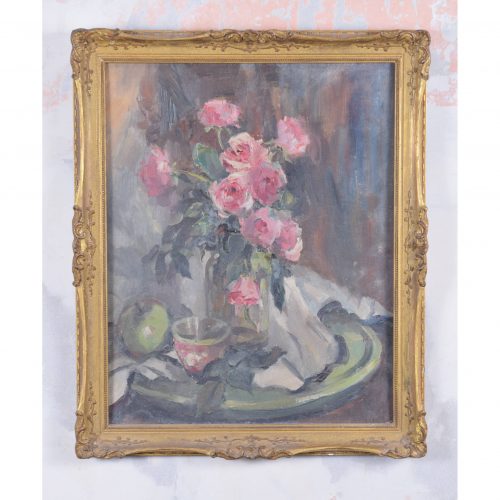
Angela Stones (1914 - 1995)
Still Life with Pink Roses
Oil on board 47 x 37 cm A beautiful still life which moves between pink and green: pink roses and bowl, and green leaves, apples, and plate. Stones' impasto technique brings texture to the fruit and petals, and the blues and browns of the background highlight the brilliance of the roses. Stones was educated at the Chelsea School of Art, and was a member of an artistic dynasty. Her mother Dorothy Bradshaw (1893 - 1983) studied under Jack Merriott – the artist famous for his British Rail posters, and her son, Christopher Assheton-Stones (1947 - 1999), was arguably the foremost pastel artist of his time. Provenance: the family of the artist. Condition: very good; gilt frame has a few repaired small losses. If you are interested, please email info@manningfineart.co.uk or call us on 07929 749056. Click here for other pictures by the artist. -
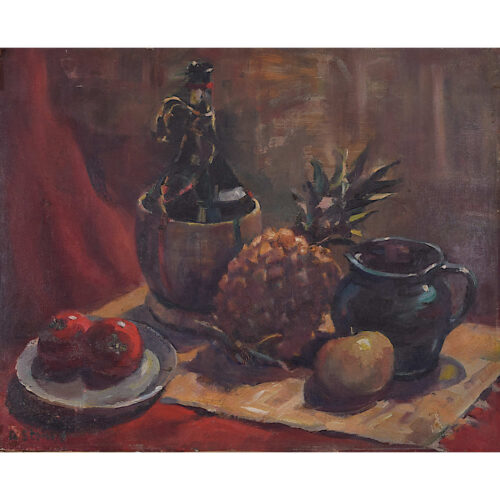
Angela Stones (1914 - 1995)
Still Life with Pineapple
Oil on board 41 x 51 cm Signed lower left. Provenance: the family of the artist. A dark, characterful mid-century still life in oils, characterised by Stones' textured brushwork and rich use of colour. Stones was educated at the Chelsea School of Art, and was a member of an artistic dynasty. Her mother Dorothy Bradshaw (1893-1983) studied under Jack Merriott – the artist famous for his British Rail posters, and her son, Christopher Assheton-Stones (1947 - 1999), was arguably the foremost pastel artist of his time. Condition: very good. If you’d like to know more, please email info@manningfineart.co.uk or call us on 07929 749056. Click here for more still lifes. -
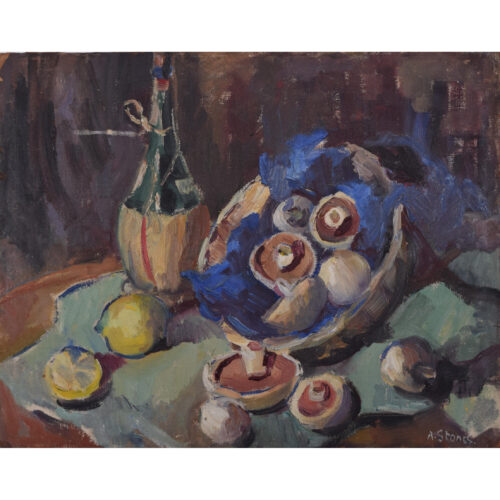
Angela Stones (1914 - 1995)
Still Life with Mushrooms
Oil on board 41 x 51 cm Signed lower right. Provenance: the family of the artist. A dark, characterful mid-century still life in oils, characterised by Stones' textured brushwork and rich use of colour. Stones was educated at the Chelsea School of Art, and was a member of an artistic dynasty. Her mother Dorothy Bradshaw (1893-1983) studied under Jack Merriott – the artist famous for his British Rail posters, and her son, Christopher Assheton-Stones (1947 - 1999), was arguably the foremost pastel artist of his time. Condition: very good. If you’d like to know more, please email info@manningfineart.co.uk or call us on 07929 749056. Click here for more still lifes. -
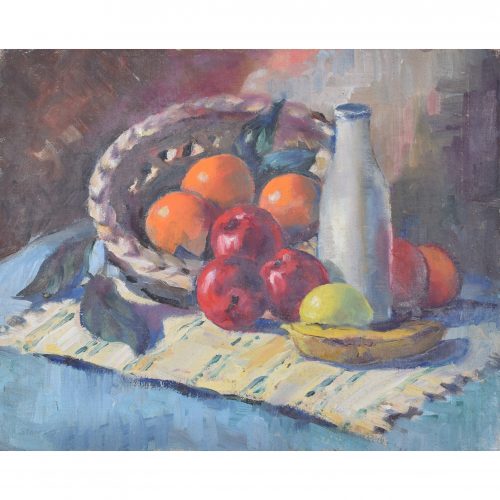
Angela Stones (1914 - 1995)
Still Life with Fruit and Milk Bottle
Oil on board 41 x 51 cm Signed lower left. A mid-century still life in oils, characterised by Stones' textured brushwork and use of vivid colours. Stones was educated at the Chelsea School of Art, and was a member of an artistic dynasty. Her mother Dorothy Bradshaw (1893-1983) studied under Jack Merriott – the artist famous for his British Rail posters, and her son, Christopher Assheton-Stones (1947-1999), was arguably the foremost pastel artist of his time. Provenance: the family of the artist. Condition: very good. If you’d like to know more, please email info@manningfineart.co.uk or call us on 07929 749056. -
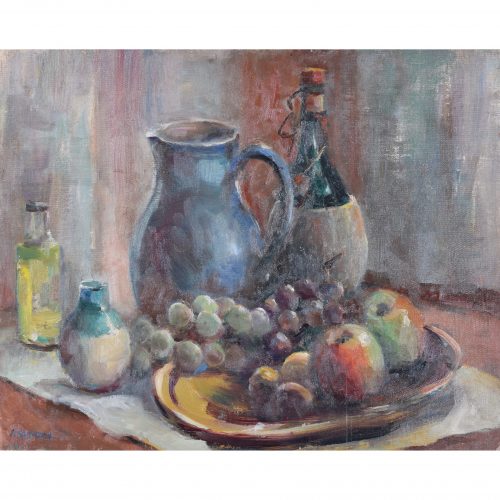
Angela Stones (1914 - 1995)
Still Life with Fruit and Jug
Oil on board 40 x 50 cm Signed lower left. A stylish mid-century still life, characterised by Stones' lively brushwork and rich use of colour. Stones was educated at the Chelsea School of Art, and was a member of an artistic dynasty. Her mother Dorothy Bradshaw (1893-1983) studied under Jack Merriott – the artist famous for his British Rail posters, and her son, Christopher Assheton-Stones (1947-1999), was arguably the foremost pastel artist of his time. Provenance: the family of the artist. Condition: very good. If you’d like to know more, please email info@manningfineart.co.uk or call us on 07929 749056. -

Angela Stones (1914 - 1995)
Still Life with Fruit and Flowers
Oil on board 62 x 46 cm A typically stylish mid-century still life. The citrus fruits in the foreground are the painting's focus, with their peel dancing between reds, greens, yellows, and oranges. Stones was educated at the Chelsea School of Art, and was a member of an artistic dynasty. Her mother Dorothy Bradshaw (1893-1983) studied under Jack Merriott – the artist famous for his British Rail posters, and her son, Christopher Assheton-Stones (1947-1999), was arguably the foremost pastel artist of his time. Provenance: the family of the artist. Condition: very good; recently cleaned and varnished. If you’d like to know more, please email info@manningfineart.co.uk or call us on 07929 749056. -
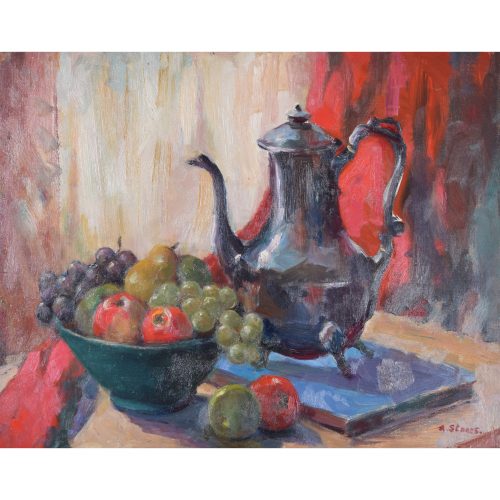
Angela Stones (1914 - 1995)
Still Life with Fruit and Coffee Pot
Oil on board 41 x 51 cm Signed lower right. A sophisticated mid-century still life, characterised by gleaming coffee pot and brimming fruit bowl. The rich red of the apples communicates with the scarlet of the draperies and Stones' signature, just as the bluish-purple hues of the grapes do with the glinting metal of the coffee pot and the blue book on which it stands. Stones was educated at the Chelsea School of Art, and was a member of an artistic dynasty. Her mother Dorothy Bradshaw (1893-1983) studied under Jack Merriott – the artist famous for his British Rail posters, and her son, Christopher Assheton-Stones (1947-1999), was arguably the foremost pastel artist of his time. Provenance: the family of the artist. Condition: very good. If you’d like to know more, please email info@manningfineart.co.uk or call us on 07929 749056. -
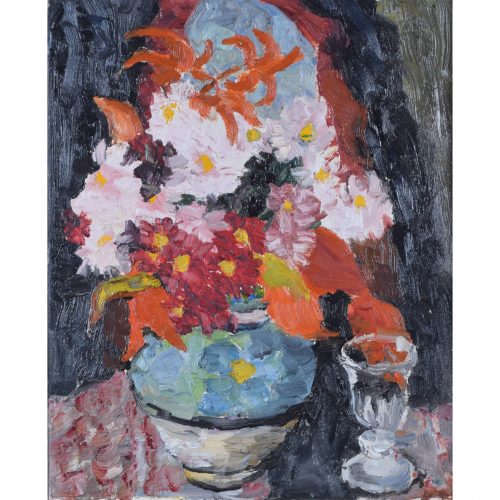
Eva Lucy Harwood (1893 - 1972)
Still Life with Flowers and Glass
Oil on canvas 49 x 40 cm ( 67 x 57 cm framed) A mid-century still life typical of Harwood's impasto style. Lucy Harwood was a British artist who studied art at the Slade just before the outbreak of the First World War. She had initially intended to be a professional pianist, but turned her attentions to visual art after becoming partially paralysed. She was one of the first students to enrol at Cedric Morris' East Anglian School of Drawing and Painting, where she focused on painting Post-Impressionist landscapes, painting just with her left hand. She moved to Upper Layham in Suffolk and is known for her landscapes of the area. Condition: generally very good. Handsome hand-finished frame. Provenance: Louise Kosman, Edinburgh. If you’d like to know more, please email info@manningfineart.co.uk or call us on 07929 749056. Click here to view our other still life pictures. -
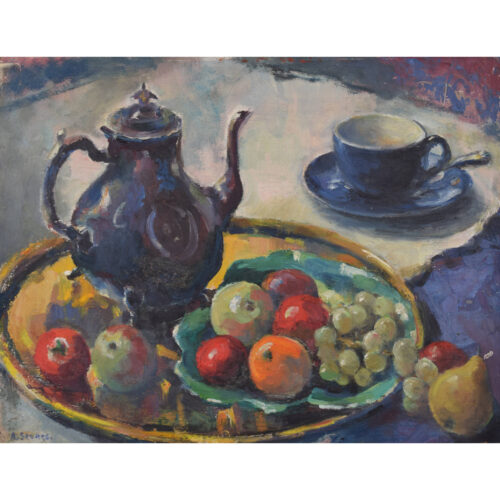
Angela Stones (1914 - 1995)
Still Life with Coffee Pot and Fruit
Oil on board 41 x 51 cm Signed lower right. Provenance: the family of the artist. A mid-century still life in oils, characterised by Stones' textured brushwork, inventive composition, and rich use of colour. Stones was educated at the Chelsea School of Art, and was a member of an artistic dynasty. Her mother Dorothy Bradshaw (1893-1983) studied under Jack Merriott – the artist famous for his British Rail posters, and her son, Christopher Assheton-Stones (1947-1999), was arguably the foremost pastel artist of his time. Condition: very good. If you’d like to know more, please email info@manningfineart.co.uk or call us on 07929 749056. Click here for more still lifes. -

Leslie Carr (1891 - 1969)
1440 Great Northern Railway (1910)
Pen and ink 19 x 41 cm Signed and dated lower right. The Great Northern Railway (GNR) was a British railway company incorporated in 1846 with the object of building a line from London to York. Although many local lines have been closed, much of the network remains active today. Leslie Carr was a painter and poster designer from London. He served in the Tank Corps in the First World War and then became a professional artist, mainly producing maritime and architectural scenes. He designed posters for Southern Railway, the London and North Eastern Railway, and British Railways (among others). Carr served as a fireman in the Second World War and was a part of several firemen artists' exhibitions. Carr was a member of the Society of Marine Artists. Condition: very good. If you are interested, please email info@manningfineart.co.uk or call us on 07929 749056. Click here for other pictures by the artist. -
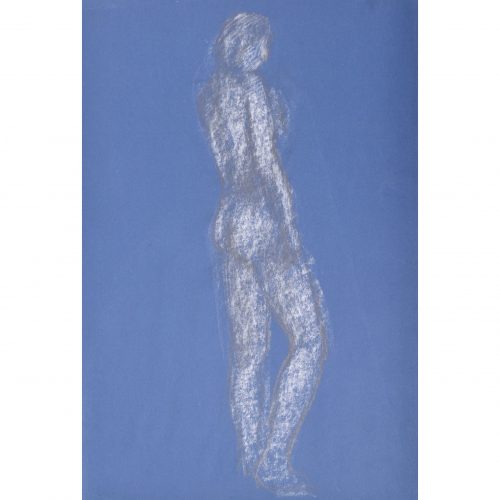
Hilary Hennes (née Hilary Miller) (1919 - 1993)
Standing Nude
Chalks 56 x 38 cm A chalk drawing of a standing female nude. The reverse of Hennes' drawing Flowers on a Table. Hilary Miller was born in London, where her father was a curator at the South London Art Gallery. She attended Blackheath High School and, from 1936 to 1940, studied at the Blackheath School of Art, and then for a further three years at the Royal College of Art. After graduating, she taught at the South East Sussex Technical College and in 1946 married the artist Hubert Hennes. The couple lived in Oxford, where they both held teaching posts at the Oxford School of Art. Between 1948 and 1967 Miller frequently exhibited paintings at the Royal Academy in London, and also illustrated a number of books on gardening and natural history, such as 'The Living World' and 'Boff's Book of Gardening'. Provenance: the artist's studio sale. Condition: generally very good. The reverse of Hennes' drawing Flowers on a Table (see photograph above). If you are interested, please email info@manningfineart.co.uk or call us on 07929 749056. Click here for other works by the artist. -
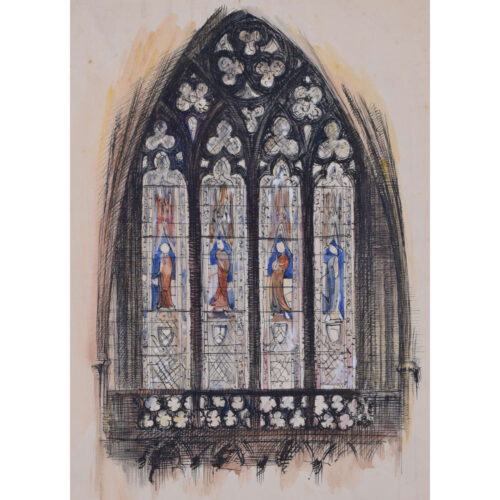
Louis Osman FRIBA (1914 - 1996)
Stained glass window
Watercolour 23 x 16 cm On Pioneer Fine laid paper. An intricately-detailed watercolour of a stained glass window, featuring four Biblical figures. Osman was as much an artist as an architect. This is likely a portfolio piece from his time studying at the Bartlett School of Architecture, and is as such a piece of architectural history as well as a beautiful Osman design. Osman was awarded a First Class degree and the Donaldson Medal of the RIBA (for the best result in his year group) by the Bartlett, and then went on to the Slade School of Art. He subsequently trained with Sir Albert Richardson - we also have several Richardson works in our collection. After the war, Osman busied himself as an architect. His work included contributions to Westminster Abbey, and Lincoln, Exeter, Ely, and Lichfield Cathedrals, Staunton Harold Church in Ashby de la Zouch for the National Trust, and of course his folly: the Grade I listed Elizabethan manor house, Canons Ashby in Northamptonshire, now a National Trust property. At Canons Ashby he established a workshop and had a team of silversmiths and goldsmiths working for him. In 1976 he made the gold enamelled coffin that holds the copy of the Magna Carta on view in the United States Capitol, Washington, DC. Condition: generally very good. If you’d like to know more, please email info@manningfineart.co.uk or call us on 07929 749056. -
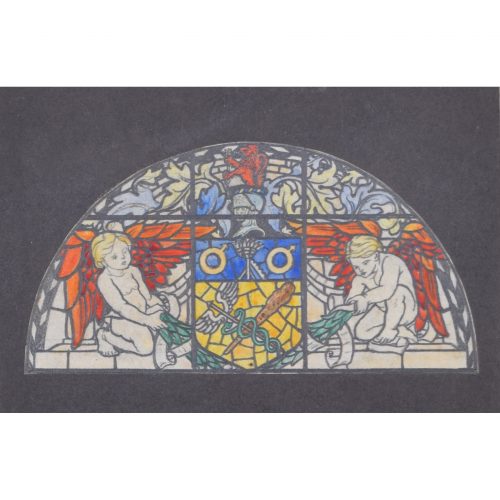
Thomas William Camm (1839 – 1912)
Stained glass window design for an arched panel
Watercolour 7 x 13 cm Design for TW Camm & Co., Smethwick, Birmingham. Numbered 13080. From the Camm studio sale. The Camms were stained glass designers who exhibited 48 times at the Royal Academy and also exhibited at The Walker Art Gallery in Liverpool, The Royal Scottish Academy, and the Royal Birmingham Society of Artists. Thomas William Camm's work was widely acclaimed, with his studio winning medals in Paris in 1878, in Sydney in 1879 and in Turin in 1911. In 1915, the American architect Ralph Adams Cram wrote that 'at the present moment a large number of artists in England are producing work of most singular beauty and perfection. Amongst these I have no hesitation in placing Mr. Camm easily as the first'. Following the death of her father, Florence Camm became the chief designer at TW Camm. Condition: very good; in oak frame. If you’d like to know more, please email info@manningfineart.co.uk or call us on 07929 749056. -
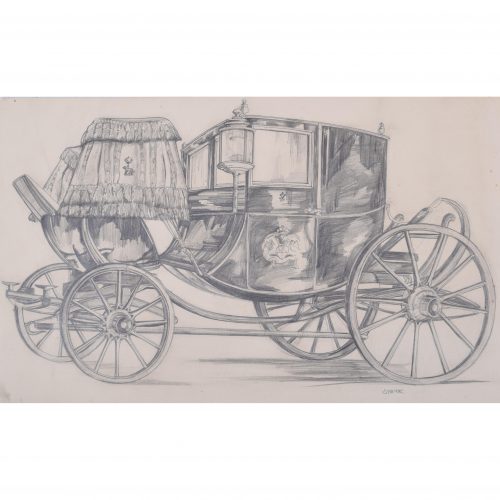
Gerald Mac Spink (flourished 1920 - 1940)
Stagecoach
Pencil 32 x 53 cm Signed 'Spink' lower right. Spink was a skilled artist, illustrator, and designer who produced a series of posters in the inter-war period for companies including the London Underground, Southern Railways, LNER, Hawker Engineering, and British Steel. He won a prize in 1933 from the Imperial Institute for his poster artwork. He also worked as an aeronautical engineer in Kingston-on-Thames for Hawker Engineering; his greatest achievement was the creation of the 'Squanderbug', a 500cc racing car which he built in 1947, and which races even to this day. Provenance: the artist's estate. Condition: generally very good. If you are interested, please email info@manningfineart.co.uk or call us on 07929 749056. Click here for other works by the artist. -
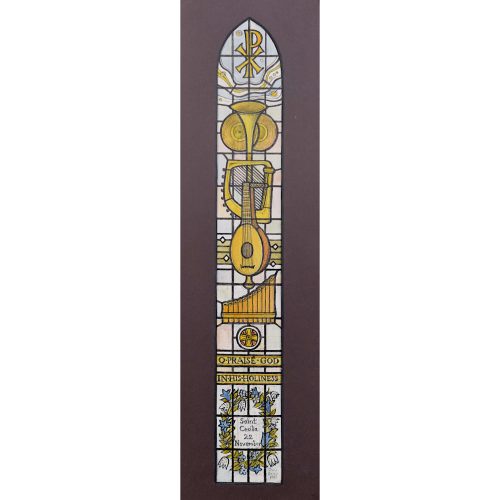
Jane Gray (b.1931)
St Peter's Church, Martindale, Design for Stained Glass Window (1980)
Watercolour 29.5 x 4.5 cm Signed and dated verso. St Peter’s Church was built in Martindale, Cumbria in 1880 by a local craftsman using stone from the surrounding area. The church is situated in an enchanting rural oasis and has connections to the acclaimed modern poet, Kathleen Raine, who lived in the Old Vicarage, as well as William and Dorothy Wordsworth who visited the area on one of their Cumbrian excursions. Gray's 'Martindale Era' lasted from 1974-81, in which time, she designed and installed fifteen stained glass windows in St Peter's Church. This window was designed in memory of Charles Barrand, the vicar at Martindale, who died in 1981. Alongside the cymbals, harp, pipes, horn, and musical notes to celebrate the musical Saint Cecilia, are some of the flowers the vicar grew in the vicarage garden and his favourite psalm: number 150. Provenance: the artist’s studio sale. Literature: Jane Gray, Playing with Rainbows. (Shropshire: Ellingham Press, 2011), pp.20, 74. Condition: very good. If you are interested, please email info@manningfineart.co.uk or call us on 07929 749056. For other works by Jane Gray and more information about her, please click here. -
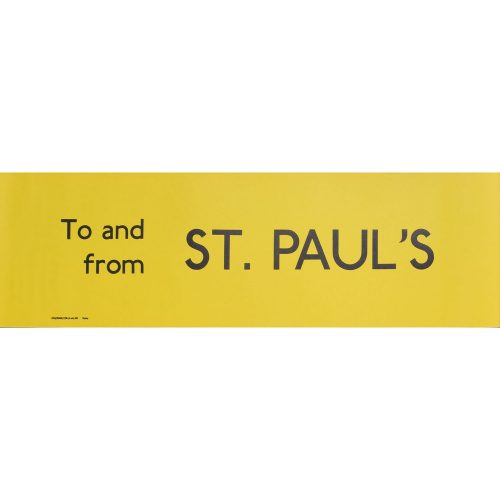
St. Paul's Routemaster Slipboard Poster c1970
Screenprint poster 64x19cm In a black hand-finished frame. Printed for London Transport for use on Routemaster or RT busses. If you are interested email info@manningfineart.co.uk or call us on 07929 749056. -

Anonymous St. John’s College, Cambridge
Watercolour 32x24.5cm If you are interested email info@manningfineart.co.ukor call us on 07929 749056. Condition: Good. -

Jane Gray (b.1931)
St Wilfrid’s Church, Ribchester, Lancashire, Design for Stained Glass Memorial Window (1995)
Watercolour 20.5 x 3.5 cm Signed, dated and studio stamp verso.St Wilfrid’s Church, Ribchester is situated in the picturesque Ribble Valley, in the heart of rural Lancashire, and dates back to the 13th century. It has since undergone several alterations in the 14th, 15th and 16th centuries as well as substantial restoration works in the 17th, 18th and 19th centuries. The village of Ribchester grew out of the ruins of the Roman fort of Bremetenaccum and the Parish Church of St Wilfrid's stands where the key buildings of the fort would have been. This window was installed in 1996.
Provenance: the artist’s studio sale. Literature: Jane Gray, Playing with Rainbows. (Shropshire: Ellingham Press, 2011), p.84. Condition: very good. If you are interested, please email info@manningfineart.co.uk or call us on 07929 749056. For other works by Jane Gray and more information about her, please click here. -
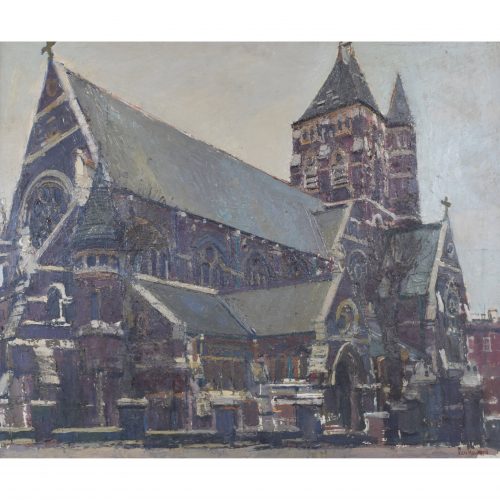
Ken Howard RA (1932 - 2022)
Hampstead Church (St Stephen's Church, Rosslyn Hill)
Oil on board 75 x 91 cm Ken Howard's magnificent view of St Stephen's Church, Hampstead. The artist's rich, deep colour palette and use of impasto underline the neo-gothic style of the church. Howard died in Hampstead and painted several views of the area and its architecture. St Stephen's was designed in the Neo Gothic style by Samuel Sanders Teulon and he considered it the best of the 114 churches he designed, calling it his "mighty church". The building is no longer a church, but wedding ceremonies still take place there; it was made a Grade I listed building in 1974. Kenneth Howard OBE RA was a British artist and painter. He was President of the New English Art Club from 1998 to 2003. He studied at the Hornsey College of Art and the Royal College of Art. In 1958 he won a British Council Scholarship to Florence, and in 1973 and 1978 he was the Official War Artist to Northern Ireland, and 1973 - 80 worked in various locations, including Hong Kong, Cyprus and Canada with the British Army. In 1983 he was elected an Associate of the Royal Academy (ARA). In 1998 he became President of the New English Art Club, a post he held until 2003. In 1991 he was elected a Royal Academician (RA). Howard was given his OBE in 2010. Condition: very good. If you’d like to know more, please email info@manningfineart.co.uk or call us on 07929 749056. -
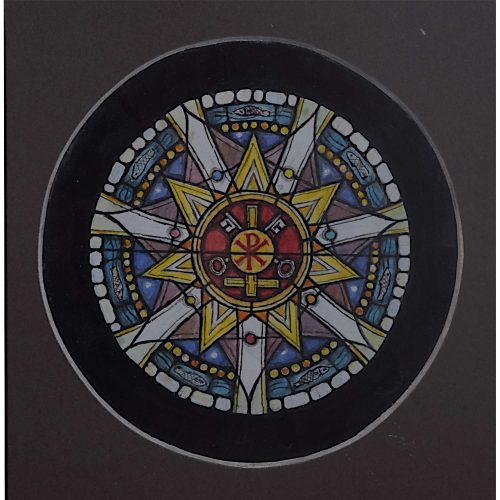
Jane Gray (b.1931)
St Peter’s Church, Monkmoor Road, Shrewsbury, Design for Stained Glass Window (1990)
Watercolour D.12 cmSigned, dated and studio stamp verso.
St Peter’s is a small, modern mission church adjoining Shrewsbury Abbey and was consecrated shortly before the outbreak of World War II in 1939. Gray’s stained glass design sensitively yet strikingly reflects this simple site of religious worship in her typical modern-medieval style. Important numbers in Christian iconography are included: three for the Trinity (Body, Mind, and Spirit), four for the material world of the Elements, and so, together, seven which combines the worlds of matter and spirit and is thus regarded as the perfect number. At the centre of the window sits the Chi-Ro, or monogram of Christ, placed against the emblems of St Peter (a pair of crossed keys and an inverted Latinate cross). Surrounding the design, seven fish swim in a turquoise sea. The window was installed in 1992.
Provenance: the artist’s studio sale. Literature: Jane Gray, Playing with Rainbows. (Shropshire: Ellingham Press, 2011), pp.48, 81. Condition: very good. If you are interested, please email info@manningfineart.co.uk or call us on 07929 749056. For other works by Jane Gray and more information about her, please click here. -
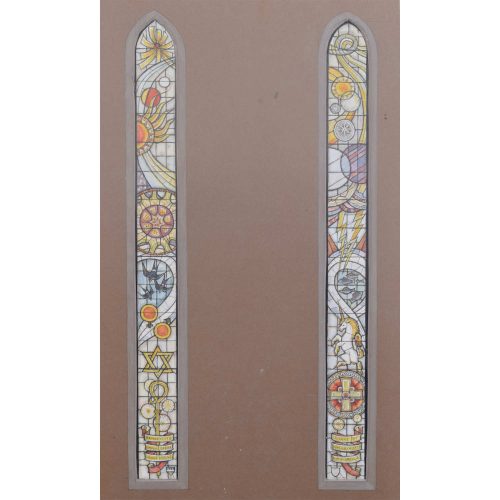
Jane Gray (b.1931)
St Peter’s Church, Martindale, Design for Benedicite Stained Glass Windows (1975-77)
Watercolour 32.5 x 8 cmSt Peter’s Church was built in Martindale, Cumbria in 1880 by a local craftsman using stone from the surrounding area. The church is situated in an enchanting rural oasis and has connections to the acclaimed modern poet, Kathleen Raine, who lived in the Old Vicarage, as well as William and Dorothy Wordsworth who visited the area on one of their Cumbrian excursions. Gray’s ‘Martindale Era’ lasted from 1974-1981, in which time, she designed and installed fifteen stained glass windows in St Peter’s Church. This pair of windows were commissioned as Gray was constructing her fifth, and supposedly last, window; the church had received a gift from an American donor who shared the name ‘Martindale’ and the vicar decided to commission two more windows on the them of the Benedicite.
Provenance: the artist’s studio sale. Literature: Jane Gray, Playing with Rainbows. (Shropshire: Ellingham Press, 2011), pp.17-18, 74. Condition: very good. If you are interested, please email info@manningfineart.co.uk or call us on 07929 749056. For other works by Jane Gray and more information about her, please click here. -

Jane Gray (b.1931)
St Peter’s Church, Martindale Design for Stained Glass Windows (1976)
Watercolour 17.5 x 6 cmStudio label verso.
St Peter’s Church was built in Martindale, Cumbria in 1880 by a local craftsman using stone from the surrounding area. The church is situated in an enchanting rural oasis and has connections to the acclaimed modern poet, Kathleen Raine, who lived in the Old Vicarage, as well as William and Dorothy Wordsworth who visited the area on one of their Cumbrian excursions. Gray’s ‘Martindale Era’ lasted from 1974-1981, in which time, she designed and installed fifteen stained glass windows in St Peter’s Church. These window designs are for Resurrection and Passion windows on the north-side of the church.
Provenance: the artist’s studio sale. Literature: Jane Gray, Playing with Rainbows. (Shropshire: Ellingham Press, 2011), pp.17, 74. Condition: very good. If you are interested, please email info@manningfineart.co.uk or call us on 07929 749056. For other works by Jane Gray and more information about her, please click here. -
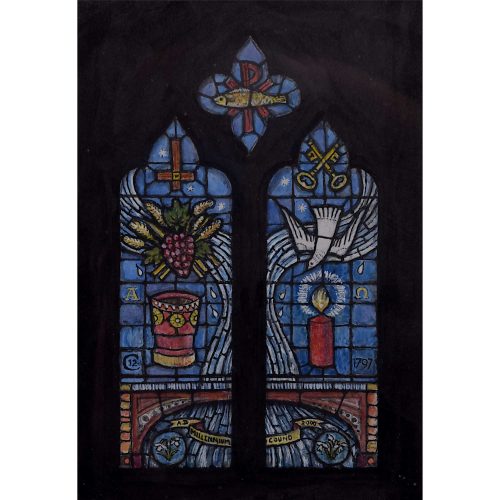
Jane Gray (b.1931)
St Peter’s Church, Cound, Shropshire, Design for Stained Glass Window (1999)
Watercolour 16.5 x 11.5 cmSigned, dated and studio stamp verso.
Proposed design for a window on the south wall, over the font. St Peter’s Church, Cound lies in the grounds of the Cound Hall estate and is dedicated to St Peter because of its medieval association with Shrewsbury Abbey (dedicated to Saints Peter and Paul). The oldest part of the present church dates back to the 13th century but it has been renovated several times since then, with additions from the 14th, 15th and 19th centuries.
Provenance: the artist’s studio sale. Condition: very good. If you are interested, please email info@manningfineart.co.uk or call us on 07929 749056. For other works by Jane Gray and more information about her, please click here. -
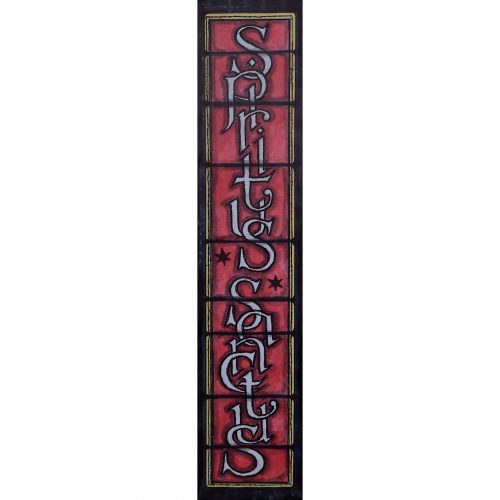
Jane Gray (b.1931)
St Peter’s Church, Cound, Shropshire, Design for Stained Glass Lettered Panel (1999)
Watercolour 24.5 x 5 cmStudio stamp verso.
St Peter’s Church, Cound lies in the grounds of the Cound Hall estate and is dedicated to St Peter because of its medieval association with Shrewsbury Abbey (dedicated to Saints Peter and Paul). The oldest part of the present church dates back to the 13th century but it has been renovated several times since then, with additions from the 14th, 15th and 19th centuries. This unique design by Gray highlights her modern style, the simple lettered panel, bearing the Latin name for the holy spirit, brimming with vibrant energy.
Provenance: the artist’s studio sale. Literature: Jane Gray, Playing with Rainbows. (Shropshire: Ellingham Press, 2011), p.86. Condition: very good. If you are interested, please email info@manningfineart.co.uk or call us on 07929 749056. For other works by Jane Gray and more information about her, please click here. -
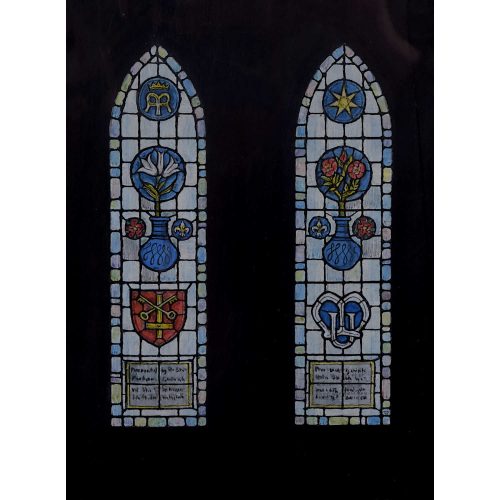
Jane Gray (b.1931)
St Peter’s Church, Chorley, Lancashire, Design for Stained Glass Window (1987)
Watercolour 18 x 13 cmSigned, dated and studio stamp verso.
St Peter’s Church was designed by the Liverpudlian architect, Charles Reed in the Early English style and built in 1850 with stone donated from Lady Hoghton’s nearby quarry. Reed wrote, ‘The general effect is expected to be very quaint and beautiful, while its elevated situation will make it a charming landmark from every side’. The church was consecrated on St Mark’s Day, 1851 by the first Bishop of Manchester, the Rt. Revd. James Prince Lee. This window was installed in 1988.
Provenance: the artist’s studio sale. Literature: Jane Gray, Playing with Rainbows. (Shropshire: Ellingham Press, 2011), p.79. Condition: very good. If you are interested, please email info@manningfineart.co.uk or call us on 07929 749056. For other works by Jane Gray and more information about her, please click here. -
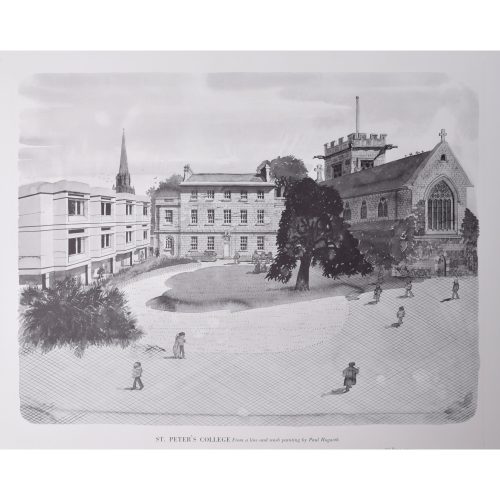
Paul Hogarth
St Peter's College, Oxford (1982)
Lithograph 33 x 46 cm A lithograph of St Peter's, from a line and wash painting by Paul Hogarth. Hogarth's view shows Linton Quad, with the chapel on the right; the chapel was built in 1874 and incorporated some of the stone of an earlier church on the site. Dons and undergraduates pace across the quad, and birds fly over the Latter Building and past the city's dreaming spires. Hogarth's line and wash painting was reproduced as a lithograph in 1982, to be published in the "Oxford Almanack". The Oxford Almanack was an annual almanac published by the Oxford University Press for the University of Oxford from 1674 through 2019 (when printing sadly ceased due to "dwindling interest"). The almanac traditionally included engravings or lithographs of the University and information about the upcoming year. Other almanac artists have included James Basire, Michael Burghers, J. M. W. Turner, and John Piper. Condition: very good. If you’d like to know more, please email info@manningfineart.co.uk or call us on 07929 749056. -
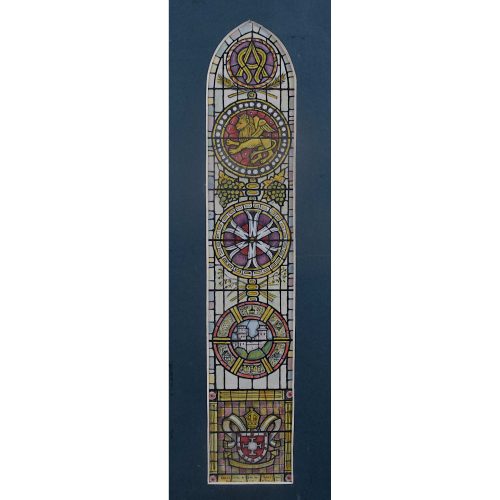
Jane Gray (b.1931)
St Paul’s Church, Warwick, Design for One of Two Stained Glass Windows (1991)
Watercolour 27.5 x 5 cmStudio stamp and notes in artist's hand verso.
Rapid population expansion in Warwick in the early 1800s, due to the opening of the canal and industrialisation, saw the churchyards of St Mary and St Nicholas unable to cope. In 1823 both churches petitioned the Bishop of Worcester for extra burial space, but it wasn’t until 1918 that the Coventry diocese was finally created. A cemetery and chapel, known as St Mary’s Episcopal Chapel were built in 1824 on the site where St Paul’s sits today but was used exclusively for burials. In 1844 the Parish of St Paul's was formed and the church was consecrated on 26th July 1844 by the Bishop of Worcester. This window was installed in 1992.
Provenance: the artist’s studio sale. Literature: Jane Gray, Playing with Rainbows. (Shropshire: Ellingham Press, 2011), p.81. Condition: very good. If you are interested, please email info@manningfineart.co.uk or call us on 07929 749056. For other works by Jane Gray and more information about her, please click here. -
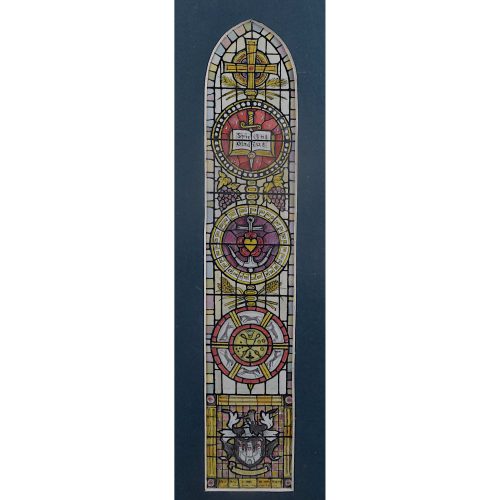
Jane Gray (b.1931)
St Paul’s Church, Warwick, Design for One of Two Stained Glass Windows (1991)
Watercolour 27.5 x 5 cmSigned, dated and studio stamp verso.
Rapid population expansion in Warwick in the early 1800s, due to the opening of the canal and industrialisation, saw the churchyards of St Mary and St Nicholas unable to cope. In 1823 both churches petitioned the Bishop of Worcester for extra burial space, but it wasn’t until 1918 that the Coventry diocese was finally created. A cemetery and chapel, known as St Mary’s Episcopal Chapel were built in 1824 on the site where St Paul’s sits today but was used exclusively for burials. In 1844 the Parish of St Paul's was formed and the church was consecrated on 26th July 1844 by the Bishop of Worcester. This window was installed in 1992.
Provenance: the artist’s studio sale. Literature: Jane Gray, Playing with Rainbows. (Shropshire: Ellingham Press, 2011), p.81. Condition: very good. If you are interested, please email info@manningfineart.co.uk or call us on 07929 749056. For other works by Jane Gray and more information about her, please click here. -
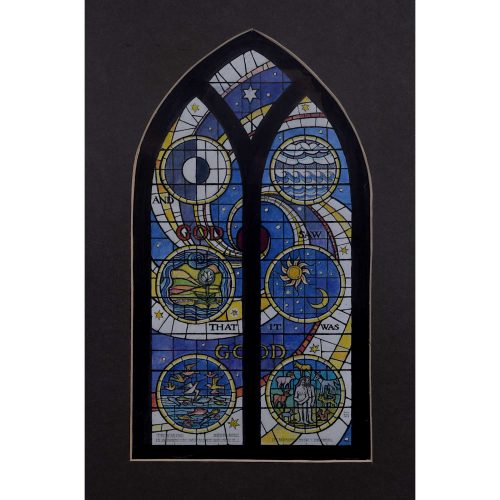
Jane Gray (b.1931)
St Paul’s Church, Marton, Design for Stained Glass Window (1984)
Watercolour 25.5 x 14 cmSigned, dated and artist label verso.
Worship at Marton, a township-chapelry in Poulton-le-Fylde parish, Lancashire, began in 1760 but it wasn’t until 1800 that Marton got it’s own church dedicated to St Paul. Gray’s vibrant design for the church’s south wall window depicts the stages of creation against a swirling night sky and features the biblical line, ‘and God saw that it was good’, from Genesis 1:31. This design fantastically demonstrates Gray’s modernist style, with her simple yet detailed, geometrical delineation of her subjects.
Provenance: the artist’s studio sale. Condition: very good. If you are interested, please email info@manningfineart.co.uk or call us on 07929 749056. For other works by Jane Gray and more information about her, please click here. -
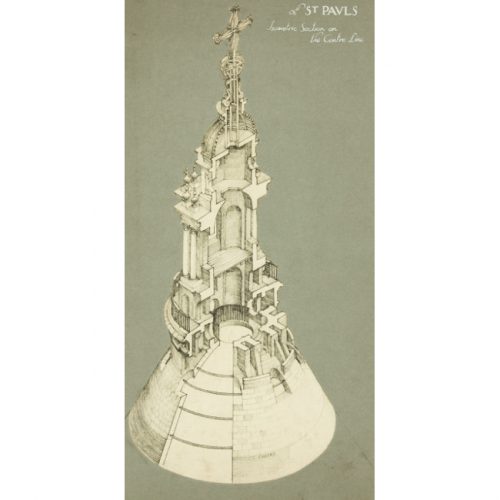
John Charles Rogers RIBA (1888-1939)
The Lantern, St Paul's Cathedral, London
41 x 18 cm (61 x 7") Graphite on paper Signed JC Rogers Inscribed 'Isometric section on the centre line'. Rogers was a practising architect who trained at Regent Street Polytechnic and was then assistant to Messrs Harvey & Potter. -
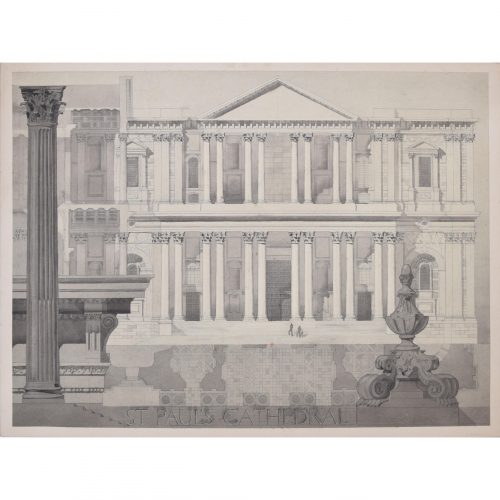
S Clapham (active 1940 - 1960)
St Paul's Cathedral
Watercolour 51 x 68 cm Signed lower right. This architectural watercolour is a panegyric to the English Baroque grandeur of St Paul's Cathedral. Three small figures climb the steps, emphasising the size and magnificence of the architecture around them. St Paul's was built between 1675 and 1711 by Sir Christopher Wren. The foundation stone was laid in 1675 when Wren was 43 years old, and the building works were completed 35 years later by Wren's son. Its construction was part of a major rebuilding programme in the city after the Great Fire of London. Clapham was an architect based in Stockwell in London. Condition: generally very good; a couple of spots. Mounted to board by artist and signed to board. If you are interested, please email info@manningfineart.co.uk or call us on 07929 749056. Click here for other works by the artist. -
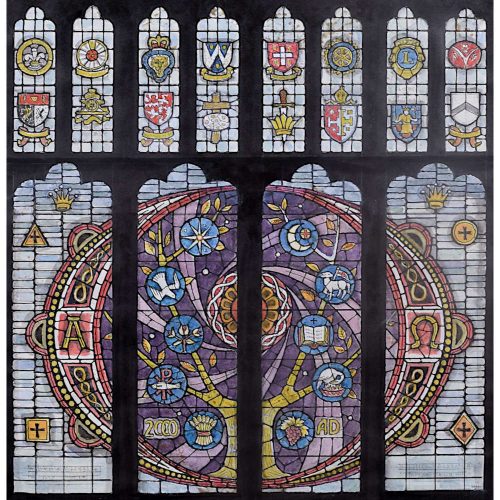
Jane Gray (b.1931)
St Oswald’s Church, Oswestry, Shropshire, Design for Stained Glass Window (2001)
Watercolour 28 x 27 cmSigned, dated and studio stamp verso.
St Oswald’s Church in Oswestry, Shropshire has been a place of worship for nearly 1000 years and commands a prominent position in the Town Centre. The church has a rich history, with William Morgan, who famously translated the whole Bible into Welsh, appointed Vicar of Oswestry in 1599, and the renowned Victorian architect G E Street substantially renovating the church between 1872-74. The church and town receive their names from Saint Oswald, the Christian King of Northumbria, who was killed at the Battle of Maserfield in 642 AD by the pagan King of Mercia, a mere 400 metres from the site of the present church. One of Oswald’s severed arms was allegedly snatched by a raven and dropped “a bowshot” away, causing a well to spring up that would be visited for centuries for healing and still exists today. The present-day name of Oswestry is a corruption of the original name Oswald’s Tree, which derives from Oswald's body being nailed to a tree in mock crucifixion. In Gray’s design, a large O fills the central four windows, a continuum (symbolising eternity) depicted at its centre, and a tree branching out across the central lights. Within them are also small roundels representing groups connected with Oswestry, including: Cambrian Railways, Round Table, Royal British Legion, Shropshire County Council, Oswestry Town Council, Rotary International, Lions International, Women’s Royal Voluntary Service, Orthopaedic Hospital, Royal Artillery, and Oswestry Borough Council. This window was installed and dedicated in 2004.
Provenance: the artist’s studio sale. Literature: Jane Gray, Playing with Rainbows. (Shropshire: Ellingham Press, 2011), pp.63, 88-9. Condition: very good. If you are interested, please email info@manningfineart.co.uk or call us on 07929 749056. For other works by Jane Gray and more information about her, please click here. -
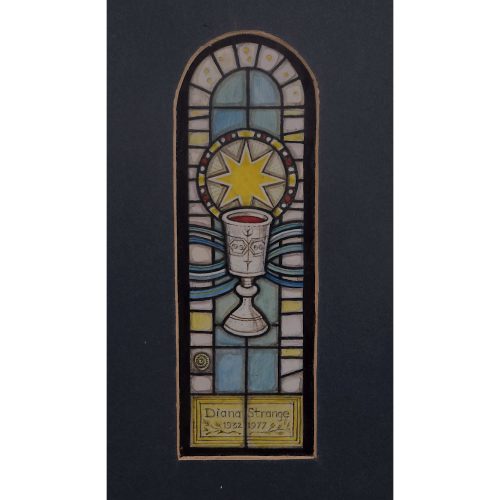
Jane Gray (b.1931)
St Nicholas Church, Worth Matravers, Dorset, Design for Memorial Stained Glass Window (1978)
Watercolour 15.5 x 5 cmDated and detailed in artist’s hand with studio label verso.
St Nicholas Church in Worth Matravers is one of the oldest churches in Dorset. It was built around the year 1100 AD. Though the majority of the church is Norman, some of the stonework appears to come from an earlier building, suggesting that there was a church here in the late Saxon period. This memorial window commemorates Diana Strange who died tragically in 1977. It was commissioned by her husband who was a keen admirer of Gray’s work and centres on the Elizabethan chalice used in St Nicholas’ Church. The window directly opposite contains another memorial window designed by Gray for Diana’s Husband, John Strange, who died seven years later. Diana's memorial window was installed in 1979.
Provenance: the artist’s studio sale. Literature: Jane Gray, Playing with Rainbows. (Shropshire: Ellingham Press, 2011), pp.22, 75. Condition: very good. If you are interested, please email info@manningfineart.co.uk or call us on 07929 749056. For other works by Jane Gray and more information about her, please click here. -
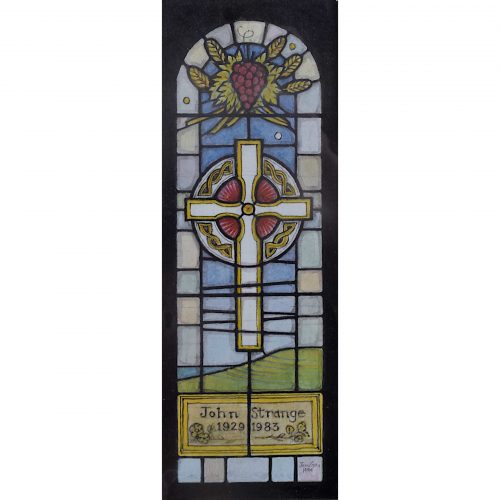
Jane Gray (b.1931)
St Nicholas Church, Worth Matravers, Dorset, Design for Memorial Stained Glass Window (1983)
Watercolour 17 x 6.5 cm Dated, detailed in artist’s hand and studio label verso.St Nicholas Church in Worth Matravers is one of the oldest churches in Dorset. It was built around the year 1100 AD. Though the majority of the church is Norman, some of the stonework appears to come from an earlier building, suggesting that there was a church here in the late Saxon period.This memorial window commemorates John Strange who died in 1984. It was commissioned in advance by John, a keen admirer of Gray’s work, after his wife, Diana, died tragically in 1977. John asked that his window included the sea view from their home, and the vine of grapes in the top panes nods to the full chalice in Diana’s window which sits directly opposite John’s and was also designed by Gray. John’s window was installed in the church in 1986.
Provenance: the artist’s studio sale. Literature: Jane Gray, Playing with Rainbows. (Shropshire: Ellingham Press, 2011), p.22, 75. Condition: very good. If you are interested, please email info@manningfineart.co.uk or call us on 07929 749056. For other works by Jane Gray and more information about her, please click here. -
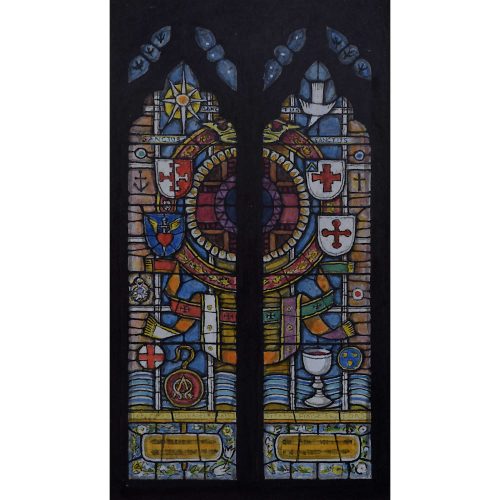
Jane Gray (b.1931)
St Michael and All Angels Church, Craven Arms, Shropshire, Design for Stained Glass Window (1995)
Watercolour 18.5 x 10.5 cmSigned, dated and studio stamp verso.
St Michael and All Angels is a Norman church that dates back to the 12th century. In 1902, it was sympathetically restored by the renowned early 20th century architect, Detmar Blow in his characteristic Arts and Crafts style, but is perhaps best known for housing both a significant fragment of a medieval wall painting, and the oldest Perpendicular pulpit (with Jacobean additions) in Shropshire.
Provenance: the artist’s studio sale. Condition: very good. If you are interested, please email info@manningfineart.co.uk or call us on 07929 749056. For other works by Jane Gray and more information about her, please click here. -
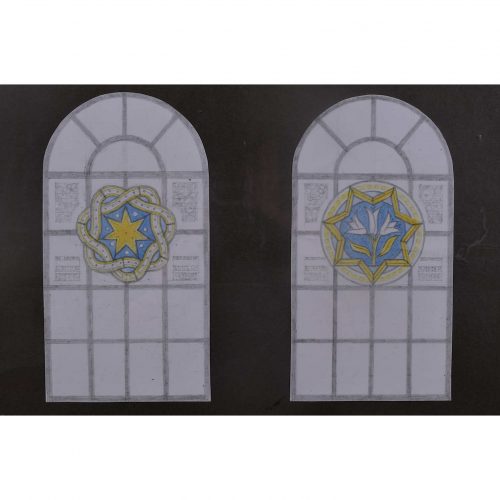
Jane Gray (b.1931)
St Mary’s Church, Twickenham, Middlesex, Design for Stained Glass Memorial Windows (1988)
Watercolour 15.5 x 17 cmSigned, dated and studio stamp verso.
St Mary’s Church stands on the site of an earlier church in Twickenham, a short distance from York House and the banks of the River Thames, and incorporates a 15th-century, medieval tower. St Mary's has an impressive and illustrious history of notable parishioners including the painter Godfrey Kneller who, after the collapse of the ancient church's 14th-century nave in 1714, took active involvement in redesigning the church in the Neo-classical style alongside local architect John James, as well as Henry Fielding and Alfred Lord Tennyson whose sons were both baptised here. Gray had a personal connection to St Mary’s, her great grandfather having been the vicar some years before. These windows held especial personal meaning for Gray as they commemorated the death of her parents in 1982 and 1985 respectively. The windows were installed in 1989.
Provenance: the artist’s studio sale. Literature: Jane Gray, Playing with Rainbows. (Shropshire: Ellingham Press, 2011), pp.42-3, 80. Condition: very good. If you are interested, please email info@manningfineart.co.uk or call us on 07929 749056. For other works by Jane Gray and more information about her, please click here. -
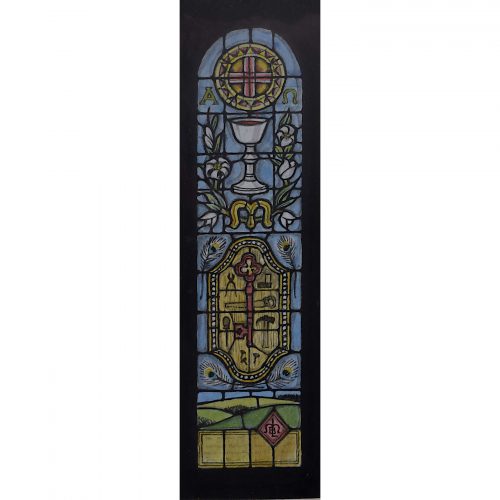
Jane Gray (b.1931)
St Mary’s Church, Sullington, Design for Stained Glass Window (1992)
Watercolour 18 x 5 cmSigned, dated and studio stamp verso.
The little church of St Mary’s, Sullington, has laid nestled beneath the Sussex Downs for almost a thousand years, within the bounds of an even older yew grove. The tower and the nave date back to c.1050 but were altered in the Norman period and again in thee 12th and 13th centuries.This small window pays remembrance to the local carpenter and verger. The design incorporates carpenters’ tools, peacock feathers from the peacocks in the neighbouring Manor House who often joined the church services, the Church’s communion chalice, and a view of the Sussex Downs. This window was installed in 1992.
Provenance: the artist’s studio sale. Literature: Jane Gray, Playing with Rainbows. (Shropshire: Ellingham Press, 2011), pp.51, 82. Condition: very good. If you are interested, please email info@manningfineart.co.uk or call us on 07929 749056. For other works by Jane Gray and more information about her, please click here. -
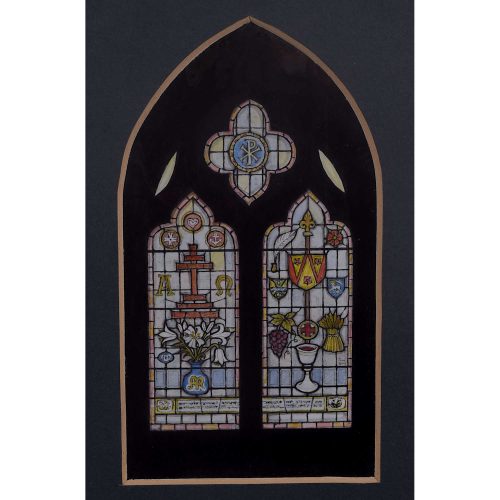
Jane Gray (b.1931)
St Mary’s Church, Penwortham, Lancashire, Design for Stained Glass Window Dedicated to the Royal British Legion (1984)
Watercolour 19.5 x 11 cmDated and artist label verso.
St Mary’s Church, set in the midst of ancient woodland, is the parish church of the Ancient Parish of Penwortham and dates from the 14th century. The church Nave and Chancel contain several memorial windows and tablets sacred to the memory of parishioners who have died; most are Victorian, such as memorial to John Horrocks, a prominent industrialist in the golden age of the Lancashire cotton industry who founded the textile company Horrockses, Miller, & Co., but the North wall features Gray’s traditional design for a window dedicated to the Royal British Legion.
Provenance: the artist’s studio sale. Condition: very good. If you are interested, please email info@manningfineart.co.uk or call us on 07929 749056. For other works by Jane Gray and more information about her, please click here. -
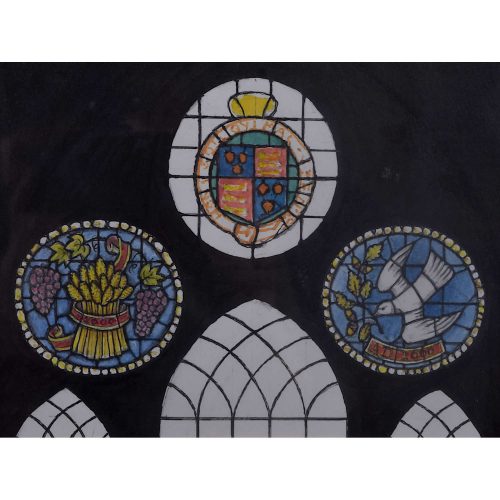
Jane Gray (b.1931)
St Mary’s Church, Longnor, Shropshire, Design for Stained Glass Millennium Commemoration Window (2000)
Watercolour 12.5 x 17.5 cmSigned, dated and studio stamp verso.
St Mary’s Church, Longnor, was originally built as a chapel to Condover around 1280 A.D. It was then a private chapel to the Corbett family of Longnor Hall, before becoming the parish church. These designs for two stained glass roundel windows in the East window were commissioned to commemorate the Millennium. This window was installed in 2001.
Provenance: the artist’s studio sale. Literature: Jane Gray, Playing with Rainbows. (Shropshire: Ellingham Press, 2011), p.87. Condition: very good. If you are interested, please email info@manningfineart.co.uk or call us on 07929 749056. For other works by Jane Gray and more information about her, please click here.

